- 2 Cities and towns
- 3.1 National parks
- 3.2 Other attractions
- 4.1 History
- 4.3 Climate
- 4.4 Holidays and festivals
- 4.5 Time zone
- 6.1 Visas and immigration
- 6.2 By plane
- 6.3 By boat
- 7.1 By plane
- 7.4 By bicycle
- 7.5 By thumb
- 7.6 Carpooling
- 10.1.1 Exchange
- 10.3 Tipping
- 10.4 Shopping
- 16.1 Authorities
- 16.2 Nature
- 16.3 Natural disasters
- 16.4 Driving
- 17 Stay healthy
- 18.1 Sensitive issues
- 19.1 Telephone
- 19.2 Mobile
- 19.3 Internet
<a href=\"https://tools.wmflabs.org/wikivoyage/w/poi2gpx.php?print=gpx&lang=en&name=Iceland\" title=\"Download GPX file for this article\" data-parsoid=\"{}\"><img alt=\"Download GPX file for this article\" resource=\"./File:GPX_Document_rev3-20x20.png\" src=\"//upload.wikimedia.org/wikipedia/commons/f/f7/GPX_Document_rev3-20x20.png\" decoding=\"async\" data-file-width=\"20\" data-file-height=\"20\" data-file-type=\"bitmap\" height=\"20\" width=\"20\" class=\"mw-file-element\" data-parsoid='{\"a\":{\"resource\":\"./File:GPX_Document_rev3-20x20.png\",\"height\":\"20\",\"width\":\"20\"},\"sa\":{\"resource\":\"File:GPX Document rev3-20x20.png\"}}'/></a></span>"}'/>
Iceland ( Icelandic : Ísland ) is a stunningly beautiful place if you enjoy strange and desolate landscapes interspersed with glaciers, volcanoes, rivers and waterfalls. It is a place for hiking, ice climbing, kayaking in glacial waters, and relaxing in geothermal hot springs, and there are many tours available for those looking for a less strenuous vacation.
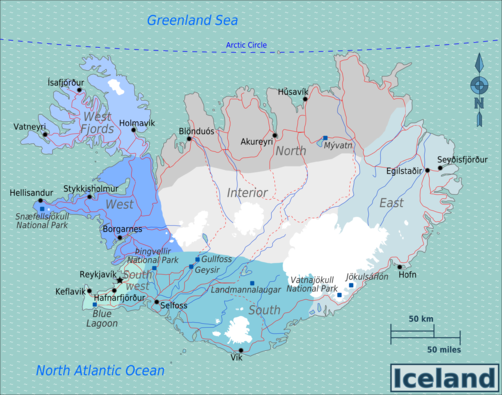

Cities and towns
- 64.15 -21.88 1 Reykjavík (REYG-ya-veeg) — the capital of Iceland and the largest city
- 65.68 -18.1 2 Akureyri (Ahk-oo-rey-rih) — capital of the North and the largest town outside the Southwest
- 65.27 -14.4 3 Egilsstaðir (AY-yill-stath-ihr) — main town in the East, has some of the best weather Iceland has to offer
- 64.07 -21.95 4 Hafnarfjörður (HAP-nar-FYERTH-er) — cozy town on the outskirts of the capital region
- 64.25 -15.22 5 Höfn (HEP'n) — main town on the southeastern coast
- 66.04 -17.34 6 Húsavík (HOOS-ah-veek) — one of the world's most reliable whale watching sites during the summer
- 66.07 -23.14 7 Ísafjörður (EES-ah-FYERTH-er) — largest town of the Westfjords of Iceland
- 63.93 -21 8 Selfoss (SEL-fos) — south Iceland's largest town, hub of the main agricultural region
- 65.075 -22.725 9 Stykkishólmur (STICK-is-hole-mur) — main town on the Snæfellsnes peninsula, gateway to the islands of Breiðafjörður
Other destinations
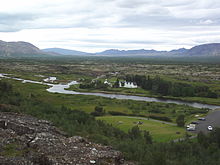
It's a shame most visitors don't stray far from the capital as some of the most memorable sights in Iceland are farther afield. There are many excursions offered by tour companies, readily available from any of the main centres such as Reykjavík and Akureyri . They will fly you around and take you out to the glaciers and to the big volcanoes for a reasonable price. However, the cheapest option is to drive around with a rental car since none of these sites have entry fees.
National parks
- 64.26 -21.13 1 Þingvellir National Park (pronounced "THING-vet-lihr") — A UNESCO World Heritage site . 30 to 50 km (19 to 31 mi) east of Reykjavík. Interesting for a number of reasons: it is the original site of the longest running parliament in the world (the name literally means 'parliamentary fields'), and it's where the North-American and European continental shelf plates are being torn apart.
- 64.5 -17 2 Vatnajökull National Park (VAT-nah-yer-CUDDLE) — Iceland's newest national park is Europe's largest national park at 12,000 km 2 (4,600 sq mi) , covering about 12% of the surface of Iceland. The park is home to Iceland's highest mountain, Hvannadalshnúkur, largest glacier, Vatnajökull, the Jökulsárlón ice lagoon, and Europe's largest waterfall in terms of volume discharge, Dettifoss.
- 64.81 -23.77 3 Snæfellsjökull National Park (SNY-fetls-yer-CUDDLE) — Located on the tip of the Snæfellsnes Peninsula in western Iceland, this park is home to the ice-covered volcanic crater that was the setting for Jules Verne's book Journey to the Center of the Earth .
Other attractions
- 63.879199 -22.445523 1 Blue Lagoon (Icelandic: Bláa Lónið ) (BLAU-ah LONE-eeth) – famous outdoor pool and health centre. The spa is in Grindavík on the Reykjanes Peninsula, south-western Iceland. It is situated approximately 13 km (8 mi) from the Keflavík International Airport and 39 km (24 mi) from Reykjavík. This geothermal spa in the middle of a lava field with its milky blue water is quite surreal. The hot water is sourced from the outlet of the nearby geothermal plant which extracts most of the heat energy and reduces the superheated water to a temperature that humans enjoy.
- 65.600278 -16.985 2 Mývatn (MEE-fatn) — a lake region near Akureyri in the North of Iceland, Mývatn has an unearthly appearance owing to special types of volcanic craters throughout the lake. There are plenty of activities in this area: Smajfall (desert where sulphuric steam comes out of the ground) and Dimmuborgir (aka the Black City and the Gates of Hell).
- 64.070278 -16.211667 6 Jökulsárlón (the Jökulsár Lagoon) — the majestic glacial lagoon in southeast Iceland located near Höfn on Route 1. Breiðamerkurjökull glacier retreated quickly from 1920 to 1965 leaving this breathtaking lagoon, which is up to 190 m deep. Ice breaks off from the glacier keeping the lagoon stocked with icebergs all year round.
- 63.988611 -19.063889 7 Landmannalaugar — a region of outstanding natural beauty reachable by bus (or 4x4) from Reykjavík. Situated in the Interior, it gives a taste of the uninhabited highlands at Iceland’s core.
Iceland is an island nation in the North Atlantic Ocean. Iceland is one of the Nordic countries , and therefore culturally part of Europe .
Because it is so close to the Arctic Circle, the amount of daylight varies dramatically by season. The sun sets briefly each night in June, but it doesn't get fully dark before it comes back up again. It is a beautiful sight and one definitely not to be missed, but it can make it hard to sleep. It is easy to lose track of time when the sun is still high in the sky at 23:00 (the time zone amplifies this: wall clock time is 1–1½ hr ahead of sun time). In the March and September equinoxes, days and nights are of about equal length, as elsewhere in the world. If you go in December, it's almost 20 hours of darkness.
Summer is definitely the best time to go, even though that time can be more crowded. Early or late winter, however, can be surprisingly good times to visit. In late January, daylight is from about 10:00 to 16:00, prices are lower than in the high season, and the snow-blanketed landscape is eerily beautiful. Some sites are, however, inaccessible in the winter. No matter when you go though, the weather is never hot , though Icelanders bemoan their glaciers shrinking due to climate change. Be prepared for rainy days in fall, and for it to be windy everywhere during any season.
Icelanders are proud of their independence from external influences and strive for political neutrality. An exception to this is their NATO membership, and even there, they are the only nation in NATO which is not required to have a military contribution. Indeed, Iceland does not have a military. This streak of independence is also used to justify them not being a member of the European Union even though there are many voices within who advocate for this. Iceland is a member of the European Economic Area though – which allows for EU and other EEA citizens to freely immigrate to and work in Iceland.
Geothermal power is widely tapped for either power generation, or directly for the hot water that can be used for household heating or swimming pools, and spas. The abundance of geothermally heated swimming pool water has made swimming hugely popular. Most communities have a heated swimming pool and swimming as a sport is a required part of the school curriculum. People rarely swim at the beach because the water is cold, and the underwater currents often make for treacherous swimming.
- Tourism information .
Iceland is geologically a young land mass; it was formed 20 million years ago by volcanic eruptions on the mid-Atlantic ridge.
The first people to settle on Iceland were Vikings and sailors from Norway and Denmark . The first known settlement was Reykjavík, with remnants from AD 871. In AD 930 the settlers founded the Alþing, the world's oldest surviving parliament. Iceland was a bridgehead for Viking expeditions to Greenland and Newfoundland . The settlements that resulted from these expeditions became extinct, though.
In 1264 the parliament of Iceland made an agreement with the Norwegian king, to become his subjects in return for regular sailing to the island. Norway and Denmark were unified in the so-called Kalmar Union in the late 14th century. Iceland remained in the Kalmar Union until it was disbanded in 1814 and Denmark took control. In 1918, Iceland became a sovereign state within Denmark's realm. During the Second World War , one month after Germany's occupation of Denmark, British forces peacefully occupied Iceland. The United States took over the occupation in 1941, while they were still neutral in the war. In 1944, Iceland declared its independence from Denmark, and the Alþing again became a sovereign legislature.
Iceland had little immigration from the Viking Age until lately. The greatest single influx of foreigners was the Allied occupation during World War II , when British and American soldiers outnumbered Iceland's adult men. Many of them had families on Iceland. Since the 1990s, the EEA and Schengen agreements and later economic booms have resulted in a significant number of migrant workers, some of which have chosen to stay.
The economy of Iceland is mainly based on fisheries and aluminium smelters. Electricity and heating in Iceland come from hydroelectric power and geothermal plants.
Iceland had a booming bank sector in the early 2000s, which was hit hard by the 2008 financial crisis. Through austerity, devaluation and change of government, Iceland recovered from the recession, and is again one of Europe's strongest economies, with tourism now being a major pillar of Iceland's economy.

Norse people were the first to settle Iceland in the 9th century AD. Tradition holds that the first permanent settler was Ingólfur Arnarson, a Norwegian Viking who made his home where Reykjavík now stands. It is thought that Irish monks had temporarily inhabited the island some years prior to this. Icelandic retains many features from Old Nordic at the time of first settlement and many Icelanders can retrace their lineage to one of the early settlers on at least one side.
Immigrants in Iceland now make up well over 10% of the population, giving Iceland a larger proportion of immigrants than Norway and Sweden. Tourism has steadily grown in the early 21st century, leading to a situation where in 2022, the number of tourist received during the year exceeded four times the local population. A lot of the tourism industry is supported by immigrants. Most immigrants are from Eastern Europe and South East Asia, and they typically speak English and little to no Icelandic. This has created friction amongst Icelanders, who feel like they should be able to go to restaurants (for example) and be able to use Icelandic rather than being forced to speak English.
For names, Icelanders use the old Norse patronymic system. This means that Icelanders are typically having a last name of <father's name> prefixing "son" or "sen" if a male, and "dóttir" if a female. Thus the practice of women, after marriage, taking the last names of their spouse makes no sense in Iceland, and is not followed. A family of four – father, mother, son and daughter – will all have different last names. This is why Icelanders always address each other by their first name no matter how formal the situation. Their phone books are also ordered by first names, followed by the last names, with their occupations also listed for disambiguation purposes. In modern Iceland, it is not rare to use a matronymic for the last name instead – particularly in the case of single mothers, or fathers who do not want to be involved.
Despite its name, Iceland has mild winters for a country at its latitude – owing to the warming effect of the Atlantic Gulf Stream – especially in comparison with the Russian climate. Coastal, south-western parts of Iceland enjoy a maritime temperate climate; its winters are often compared to those of the Pacific Northwest in the U.S.A., although the winter winds can be bitter. However, Iceland's rapidly changing weather has given rise to the local saying: 'If you don't like the weather, wait five minutes!' It's the kind of place where it's not unusual to get rained on and sunburned at the same time. Some Icelanders believe that if the winter is hard and long then the summer will be good and warm. The summers are usually cool and more temperate than elsewhere at the same latitude (the effect of the ocean again), averaging at 12°C (54°F). 20–25°C is considered quite warm.
Holidays and festivals
- Christmas follows the dates of the Western church. Stores are traditionally closed on Christmas Eve (24 December), Christmas day (25 December), New year's eve (31 December) and New year's day (1 January). The entire country, including all public transportation, restaurants (except a few in hotels), convenience stores and supermarkets, pretty much shuts down on those days. Icelanders have 13 jule lads. Historically, the jule lads were pranksters who redeemed themselves by giving children presents. Each jule lad has its own day, with the first one coming to town on 12 December. Epiphany (Icelandic: Þrettándinn) is celebrated with bonfires and firework displays. On this day, Icelanders play the roles of elves and hidden people.
- Bolludagur — Held on a Monday, 7 weeks prior to Easter. A festival in which Icelanders eat puffed buns filled with jam and whipped cream. Traditionally, children are allowed to spank their parents before they leave their bed and are given a puffed bun instead.
- Sprengidagur — Held on a Tuesday, 7 weeks prior to Easter. A festival during which Icelanders are expected to eat salted meat and yellow peas.
- Öskudagur/Ash Wednesday — Held on a Wednesday, seven weeks prior to Easter. On this day, children dress in costumes and sing for candy. This is the Icelandic equivalent of the US Halloween.
- Sjómannadagurinn (Seamen's day) is held on the first Sunday in June. A national holiday when Icelanders go to the nearest harbor to celebrate with seamen.
- Þjóðhátíðardagurinn (Icelandic National day) is held on 17 June. Stores are traditionally closed on this day. The celebrations typically start with a parade and speeches, followed by less formal celebrations.
- Verslunarmannahelgi (Workers weekend) is held on the first weekend of August. This is typically the largest holiday in Iceland. Shops are traditionally closed. Icelanders flock to outdoor festivals held across the country.
Iceland uses GMT, the same time zone as the United Kingdom , Ireland and Portugal . However, unlike those countries, Iceland does not observe Daylight Saving Time, making it the only country in Western Europe not to do so.

The official language of Iceland is Icelandic ( íslenska ), which remains very similar to − although not quite the same as − 13th-century Norse (see Vikings and the Old Norse ).
It is a Germanic language closely related to Faroese (with which it is mutually intelligible to some extent), Danish , Norwegian and Swedish , and more distantly to German , Dutch and English. Loanwords are shunned in Icelandic. For example, the word for computer is tölva , which literally means "number-prophetess".
English is widely spoken by the locals and with the possible exception of the elderly, almost everyone you meet will be fluent in the language. You may be able to get around using only English, but attempts at speaking Icelandic are always appreciated and will most certainly endear you to the locals, since very few people actually make the effort to learn Icelandic.
Although all Icelanders learn Danish at school from a young age, proficiency in the language tends to be poor. Most Icelanders do not feel that Danish is a useful language to learn, and often opt to just speak English whenever they visit Denmark given the high level of English proficiency there. People engaged in Nordic cooperation may know the language well, and tend to pronounce it much more comprehensibly than native speakers.
Iceland uses the metric system only. There is limited knowledge of imperial or US measurements.
In Iceland there is no concept of a ground floor as in the UK. Instead, the entrance level of a building is called the first floor ("jarðhæð"), like in the US. Levels are then counted 1, 2, 3, etc.
Foreign television programmes and films are almost always shown in their original language with subtitles. Only children's programmes are dubbed into Icelandic.
Iceland has ended all COVID-19 restrictions.
Visas and immigration
Iceland is a member of the Schengen Agreement . See Travelling around the Schengen Area for more information on how the scheme works, which countries are members and what the requirements are for your nationality. In summary:
- There are normally no immigration controls between countries that have signed and implemented the treaty.
- There are usually identity checks before boarding international flights or boats entering the Schengen Area. Sometimes there are temporary border controls at land borders.
- A visa granted for any Schengen member is valid in all other countries that have signed and implemented the treaty.
However, as Iceland is not part of the European Union , all travellers entering Iceland, including those from EU countries, are required to undergo customs inspections on entry.

Iceland is easily reached via air and the main international airport is Keflavík Airport ( KEF IATA ), in the south-west of the country about 40 km (25 mi) from Reykjavík and serves around 30,000 passengers per day in high season. The airport itself is spartan; if you have a lengthy layover you should bring books or other forms of entertainment. Better yet, make sure you can leave the sterile area and explore the country a bit.
Passengers arriving from outside Iceland (including from EU countries) whose final destination is Iceland or who have to recheck baggage will have to go through customs controls at the port of entry (usually at Keflavík), regardless of place of origin. There is a duty-free store in the arrivals baggage claim area where you can purchase duty-free products when in transit to the European mainland. Those coming from countries in the Schengen agreement don't need a separate visa and there are no immigration checks if arriving from other such countries. Airlines will still ask for some form of ID even on flights to/from other Schengen countries.
Passengers travelling on Icelandair between the Americas and Europe are entitled for a stopover of at least one night in Iceland, without additional airfare charges. Icelandair allows up to 7 nights on each leg of the trip.
An airport transfer bus service (called the FlyBus ) runs between the airport and Reykjavík BSÍ Bus terminal (kr 3000 one way, 45 minutes; kr 5500 return, as of May 2019). For kr 4000 one way (kr 7000 return; as of May 2019) you can purchase a Flybus+ trip which includes drop-off (and pick-up, if requested the day before) at a select list of hotels in the Greater Reykjavík Area. Even if you're not staying at one of these hotels they might be within walking distance of where you want to go, so depending on your destination using the Flybus+ option you may avoid a taxi ride.
Another great option is to take the bus which stops at the Blue Lagoon either to or from the airport, then continues every half hour or so to Reykjavík. ( Netbus is the cheapest option.)
A metered taxi from the airport to Reykjavík costs about kr 16,000 (as of May 2019).
The following airlines fly to Keflavík:
- Nonstop flights on national carrier Icelandair are available at the best value from the US and Canada, with gateways in New York City (JFK), Seattle , Boston , Halifax , Minneapolis / St. Paul , Toronto , Denver and Orlando (Sanford). Destinations beyond Iceland include most major European cities (i.e. Amsterdam, Bergen, Berlin, Copenhagen, Frankfurt, Glasgow, Helsinki, London, Oslo, Madrid, Manchester, Milan, Munich, Paris, Stockholm, Düsseldorf, and Stavanger), with Icelandair's hub-and-spoke network connecting via Keflavík in Iceland. (Some destinations are seasonal.)
- Delta Air Lines operates between New York City ( JFK ) and Keflavík.
- EasyJet , offers low-cost flights from the UK: London , Manchester Airport , Edinburgh and Bristol , and to Switzerland: Geneva.
- eurowings , has seasonal flights from Cologne .
- WizzAir has cheap flights from the Baltics
- SAS offers direct flights from Oslo , with connections to Stockholm and the rest of Scandinavia.
- Norwegian offers direct flights from Oslo .
- British Airways flies from Heathrow Airport in London .
- Play has taken up WOWAir's mantle as the budget Icelandic carrier, connecting to a number of European and American East coast cities.
Scheduled service to Greenland and Faroe Islands is provided by Icelandair and Atlantic Airways .
Smyril Line sail once or twice a week from Hirtshals in Denmark, via Torshavn in the Faeroe Islands (where a stop-over can be made), to Seyðisfjörður on the east coast of Iceland with their ferry Norröna. This costs more than flying, but check the different language versions of the Smyril website (.fo, .dk, .co.uk, .de, and .is) for the best deals. Smyril no longer sail to Shetland or the Scottish mainland.
But at Seyðisfjörður the journey is only half-done: there's no car hire there so you have to catch an occasional bus to Egilsstaðir , then another to Akureyri , then another to Reykjavík . This takes at least two days, is more expensive than a domestic flight, and isn't compatible with much sight-seeing along the way. However, as Norröna is a car ferry it's possible to travel from mainland Europe to Iceland with your personal car and use that to travel the country and do some sight seeing on the way. See Seyðisfjörður for more on the practicalities.
Aircraft in Iceland are like buses or trains elsewhere - they're the main form of internal travel other than the roads. Be warned though, that the ride can be a bit bumpy if you're entering one of the fjords like Akureyri.
Domestic flights from Reykjavik operate from Reykjavik Airport , a different airport located closer to the namesake town. Scheduled service to nearby destinations, including Greenland and Faroe Islands, is provided by Icelandair, Atlantic Airways and Eagle Air .

A car offers the most flexibility for travel around Iceland. Numerous agencies rent vehicles, and ferries allow individuals to bring their own car with them. Rental prices are high (try to book as far in advance as you can) - expect to pay at least 4000 kr per day for a two wheel drive vehicle, and upwards of 12,000 kr per day for a four-wheel-drive vehicle; these prices include basic car insurance, but additional insurance may be purchased to protect against damage from gravel or other common mishaps.
A four-wheel-drive car is needed only in the interior, which is open only in the summer. Renting cars in advance is often cheaper than doing so on-location. Off-road driving is strictly forbidden in Iceland and punishable with fines in the range of 300,000–500,000 kr. Icelandic nature is sensitive and does not recover easily from tire tracks.
Driving in Iceland is on the right side of the road. Headlights and seat belts for all passengers must be on at all times, even on buses. If you are in an accident and not wearing a seat belt, you are considered to be uninsured. There is a single main highway, Route 1-Ring Road , which encircles the country. Because of Iceland's ever-changing weather, one should keep extra food and know where guesthouses and hotels are located in case of a road closure.
Most mountain roads are closed until the end of June, or even longer because of wet and muddy conditions which make them totally impassable. When these roads are opened for traffic, many of them can be passed only by four-wheel-drive vehicles. The roads requiring four-wheel-drive (and possibly snow tires) are route numbers with an "F" prefix, e.g. F128. Some roads that were previously signed with an F have since been upgraded and assigned a number without an F. In general you can trust those designations in both cases.
The general speed limit on Icelandic rural roads is 90 km/h (56 mph) on paved surface and 70 km/h (43 mph) on gravel, in urban areas the general speed limit is 50 km/h (31 mph) . Driving on gravel can be a challenge, and loss of control on cliff-side roads can easily be fatal. Speed cameras are posted around the country, and fines are 5,000–70,000 kr. The blood alcohol limit is 0.05%, with a minimum fine of 100,000 kr – don't drink and drive.
Drivers in Iceland should familiarise themselves with road signs and be prepared for Iceland's unique driving conditions. The roads in Iceland are of a medium to low quality, typically made from slightly rough black basalt. There are two signs in particular that foreigners should pay attention to. First, "malbik endar" means that the road changes from a paved road to a gravel road. Slow down before these changes, for one can lose control easily. Also "einbreið brú" means that a one-lane bridge is approaching. Arrive at the bridge slowly and assess the situation. If another car has arrived at the bridge first allow them the right of way.
If you are travelling by road a great site to check is the Iceland Meteorological Office who have an excellent set of pages including the Icelandic Road Administration [ dead link ] on all of the main roads.
The Route 1 road that encircles the island nation is a staple for tourists who wishes to see the diverse geological features of Iceland, from waterfalls, icebergs, fjords, to volcanoes.

Scheduled trips between Icelandic towns are operated by Strætó bs. Tours to attractions are provided by scheduled buses from various companies, including Reykjavík Excursions (who also operate the FlyBus ), Trex , Sterna Travel , NetBus and SBA-NORÐURLEIÐ . Long distance bus travel can cost several thousand kronur and is sometimes more expensive than flying. For example, a one way trip from Reykjavík to Akureyri costs 10,340 kr, while flying costs 8,925 kr (as of May 2019). It is possible to go from the eastern part of the country to the western one by bus in one day, but there are only a few services per day. All public transport services are listed on PublicTransport.is .
Some tours to the interior, in special 4x4 buses, can be a cheaper and more relaxing alternative to driving and serve most major locations (e.g. Landmannalaugar, Thorsmork, Askja). Tours to the interior are scheduled only for the summer months.
Golden Circle day tours are available from Reykjavík from many tour operators which will take you round the Gulfoss waterfall, geysers, the crater and the Mid-Atlantic rift/place of Iceland's first Parliament. Although you don't get much time at each stop, the guide will tell you about Iceland's history and some general information. Cheaper tours (~€55) will be a full-coach whereas more expensive tours (~€80) will be small minibuses or vans. The currency for booking tours can vary from euros, to dollar to krona, so double-check before booking.
The capital area bus system, run by Strætó bs. , is an inefficient and expensive mess that can not be relied on. A single fare costs 490 kr (as of March 2022). Bus drivers do not give back change, so if all you have on you is a 500-kr bill, do not expect to get the difference back. The bus system takes either payments through the phone, using their own app or by paying in cash. Sets of tickets are only available through the app. (as of March 2022) If you pay with cash, you will only get a ticket if you ask for one. Tickets from the bus driver and tickets in the app are both valid for 75 minutes.
Buses to the countryside stop running at midnight, but in the capital they run for longer, see Southwest-Iceland for info on that. Some buses even stop earlier, some as early as 18:00. Buses start running at 09:30 to 10:00 on Sundays. Fares to zones 2 and upwards (extending all the way to Höfn and Egilsstaðir) are higher, although all of Reykjavík, Garðabær, Hafnarfjörður, Mosfellsbær, Álftanes and Seltjarnarnes fall within zone one, where the regular fare of 490 kr applies.
Cycling is a good way to experience Iceland, and provides a very different experience to other means of transport. You should bring your own touring bike, as buying a bike locally can be expensive. Traffic in and out of Reykjavík is heavy, otherwise, it's OK. You can cycle safely on the Ring Road, or take the bike on the buses serving the Ring Road (they are equipped with bicycle racks) and do side trips. However, if going self-supported, considering the weather and conditions, it is strongly advisable to have a previous touring experience.
When cycling in the winter, use studded tyres and dress yourself up in lightweight but warm layers. Bicycle maintenance is typically not a concern, brake pads for example tend to last for 12 months or more, depending on the quality of the brakes.
For trips outside of a town or a city, bring food with you. Icelandic towns can be 100–200 km apart. Food that cooks within 10–15 minutes is preferred. Foraging blueberries and herbs is possible, but do not rely solely on that as a food source.
More information and routes can be found on Cycling Iceland .
Hitchhiking is a cheap way of getting around in Iceland. The country is among the safest in the world, people are quite friendly and the percentage of drivers who do give rides is high, especially in the off-season. Nearly everybody speaks English and most drivers are interested in conversations. However, low traffic in areas outside Reykjavík makes hitchhiking in Iceland an endurance challenge. Even on the main ring-road the frequency of cars is often less than one car per hour in the east.
Avoid hitching after nightfall, especially on Friday and Saturday night. Alcohol consumption is high and alcohol-related accidents are not uncommon.
Hitchhiking into the interior is tough, but everything works if you have enough time – calculating in days, not in hours. For longer distances or less tourist areas be prepared with some food, water and a tent or similar. The weather can be awful and sometimes spoils the fun of this way of travelling.
The HitchWiki website has some advice for hitchhikers.
Check Samferda.is for carpooling options.

- The Gullfoss waterfall is quite spectacular.
- Geysir , the namesake of all geysers, and its neighbour Strokkur which erupts every five minutes or so.
- Þingvellir National Park , a beautiful landscape of water-cut lava fields, which is historically important as the site of Iceland's parliament from 930 AD.
- Vatnajökull glacier is in Southeast Iceland and is Europe's largest glacier.
- Jökulsárlón , the largest glacier lake in Iceland, is located off Route 1 and part of Vatnajökull glacier.
- In the darker months (September to April), there are frequently stunning views of the Aurora Borealis , a.k.a. Northern Lights anywhere away from city lights. Three conditions need to be true for viewing the northern lights from any given spot: (1) It needs to be dark. Yhe extremely short nights in summers greatly reduce the chance to view the northern lights. Similar impacts come from light pollution from city / street lights (2) The skies need to be free of cloud cover and (3) There needs to be solar activity that sends the charged particles barrelling towards the earth. The magnitude of the visible displays is dependent on chance and can vary over the viewing period as the solar activity and cloud cover changes. There are weather sites that track the chances of seeing the aurora on a given night for a given location, and you can use those ratings to guide you in how late you plan to stay up to see the lights.

- The geothermal spa Blue Lagoon , although being an artificial hot spring, is a very popular sight and activity located between the capital and the main airport. Mývatn Nature Baths is another choice, but it is smaller and in the Eastern part of the country. There also are a lot of local hotpots around the country, but not all of them are safe.
- Iceland offers many hiking opportunities. Should you choose to walk outside of walking paths, strong walking boots which support your ankles are recommended as the terrain is usually craggy lava rock or springy moss with hidden holes!
- Iceland is not well known for skiing or big ski areas but the town of Akureyri in the north has a great little ski area and the mountains of the Troll Peninsula offer world class terrain for ski touring , ski mountaineering and heli-skiing.
- Ice climbing is great with world class frozen waterfalls and plenty of glaciers.
- Glacier hiking is one of Iceland´s most popular tourist things to do, with the area of Skaftafell in the south-east being the centre of the activity. There are also other ways to explore the glaciers.
- Whale watching is available all year from Reykjavík and during the summer from Husavik.
The local currency is the Icelandic króna , denoted by the abbreviation " kr " (ISO code: ISK ).
Coins of Iceland are issued in denominations of 1, 5, 10, 50 and 100 krónur. Banknotes of Iceland are issued in denominations of 500, 1,000, 2,000, 5,000 and 10,000 kr.
You will get a better rate of exchange if you buy and sell your króna in Iceland. The best exchange rates can usually be found at banks in Reykjavik. Just about every establishment in Iceland will accept a credit card, including taxis, gas stations, souvenir stands, and even the most remote guest house, so it is not necessary to carry large amounts of Icelandic currency.
Getting to Iceland can be done fairly cheaply: Icelandair has excellent offers, and Keflavík International Airport is served also by some low-cost airlines.
However, as soon as you step off the plane the situation changes quite drastically – Iceland is generally a very expensive place to visit, due in part to the high import duties and the 25.5% VAT rate. Retail goods can be 3–4 times more expensive than in North America, while grocery prices are at least on par with the most expensive cities. You should budget at least as much money as you would for a trip to Norway or Switzerland.
Useful discount card schemes exist for tourists, the most significant being Reykjavík City Card, operated by the City of Reykjavík.
When shopping for food or other basic necessities, look for the Bónus, Netto or Krónan shops, as they offer considerably lower prices than the others. The centre of Reykjavík is also home to several second-hand stores like those of the Red Cross and the Salvation Army, which can come in handy for buying cheap warm layers.
Expect to spend 700–1200 kr on a pint of beer or glass of wine, 1900–2400 kr on a pizza for one person, 350–900 kr on a coffee or espresso drink and 550 kr on a city bus ride.
Cigarettes cost around 2000 kr for a packet of 30. By law, they must not be visible in shops; however, most gas stations, supermarkets and newsagents sell them.
In Iceland tipping is not practised. In rare cases an attempt to leave a tip may be seen as insulting, so instead consider offering verbal praise for a job well done. Some Icelandic companies have started having a tipping jar next to the cash register but these are generally ignored.
Typical Icelandic products that make good souvenirs include:
- Icelandic wool products. Icelandic sheep are a unique breed that produce a soft and durable wool, and Icelandic woollen goods (hats, gloves, etc.) are soft and warm; don't just buy them for other people if you plan to visit the interior.
- Arts and crafts. Iceland has a huge number of great little craft shops that sell everything from musical baskets and wonderful weird porcelain sculptures to paintings, glasswork and jewellery. The National Galleries tend to carry the same artist's work in the gift shops rather than the usual mass-marketed products found in so many other museums.
- Local music. There is a plethora of interesting local music CDs (beyond just Björk and Sigur Rós) worth hunting for. Obscurities worth picking up include Eberg, Hera, Retro Stefson, FM Belfast, Worm is Green, Múm, Singapore Sling, and Bellatrix. Note that many of these CDs may be available back home as imports for much lower prices. CDs tend to cost 1500–2000 kr.
With the exception of alcohol, accommodations and consumables, you can claim your tax refund at the Arion Bank in the arrivals hall opposite to the car rentals at Keflavik Airport. Only purchases with at least 6000 kr on a single receipt will be eligible for tax refund. Be sure to have your original receipts and the tax free form filled out by the store with you.

Traditional Icelandic cuisine tends to be bland and simple due to the limited range of available ingredients as a result of the harsh climate. It is based on staples that use lamb or fish in some form or other. However, technological advances and imports have led to a rather cosmopolitan modern Icelandic cuisine. Modern Scandinavian or New Nordic cuisine has found its way to Iceland, and Reykjavík is home to a number of well-regarded fine dining restaurants. A vegetarian diet is tricky to maintain in Iceland, but there are several vegetarian restaurants in Reykjavík, and vegetarian dishes are widely available at other restaurants.
Distinctively Icelandic foods include:
- harðfiskur , dried fish pieces eaten as a snack with butter (also good with coleslaw)
- skyr , a yoghurt-like cheese available in flavoured and unflavoured varieties all over the country. Low in fat and high in protein.
- hangikjöt , smoked lamb
- smoked lamb sausage
- svið , singed sheep's head
- Slátur , consists of lifrarpylsa , a sausage made from the offal of sheep, and blóðmör which is similar to lifrapylsa but also has sheep's blood mixed into it.
- Rúgbrauð , translated into English as "thunder bread", this is a type of rye bread that is baked underground making use of geothermal heat. Sweeter than regular rye breads.
Iceland is famous for its whale meat, and is one of the few places in the world where it is possible to eat minke whale. Whaling has long been a tradition in Iceland, though it has become a controversial issue. However, most restaurants that cater to tourists sell whale meat, and if you are feeling a little more adventurous some places will serve grated puffin with it if you ask.
During the Þorri season (late January-Early February), many Icelanders enjoy Þorramatur , a selection of traditional Icelandic cuisine which usually contains the following: hákarl (putrefied shark cubes), Sviðasulta (brawn [head cheese] made from svið ), lundabaggi (sheep's fat) and hrútspungar (pickled ram's testicles). Þorramatur is usually served at gatherings known as Þorrablót . If you are invited to a Þorrablót , do not be afraid to (politely) refuse some of the more unpalatable delicacies, as many Icelanders choose to do so as well. Don't worry about going hungry, though, as many of the more "normal" foods mentioned above are almost always available too. If you're uncertain which is which, do not be afraid to ask the caterers for assistance.
A similar event to Þorrablót is Þorláksmessa , celebrated on 23 December each year. During this day you might find yourself invited to skötuveislur , where cured skate is served. As with Þorrablót , you can politely refuse to partake in the skate (another type of fish is usually served alongside it for the less adventurous). A word of warning, though: the pungent smell that accompanies the cooking of cured skate is very strong and sticks to hair and clothing very easily. Do not wear formal (expensive) clothing at these gatherings, especially not clothing you intend to wear during Christmas.

Any Icelander's first choice of fast food is usually the pylsa or hot dog. It uses a lamb sausage and is usually served with a choice of fried onions, fresh onions, ketchup, mustard and remoulade. It is cheap compared with other fast food staples at around 350 kr, and is sold in every one of the small convenience stores/eateries/video rentals/sweet shops that litter Icelandic towns. At least in Reykjavik, you can also encounter food trucks and carts selling piping hot lamb meat soup ( kjötsúpa ). They also have a vegetarian alternative – the same soup minus the meat.
Food prices are particularly high in Iceland – the following sample prices were accurate as of summer 2016:
- 350–500 kr for a hotdog
- 1000–2000 kr for a hamburger.
- 3000–6000 kr for a three-course meal in a restaurant.

Tap water is safe to drink in Iceland and it is one of the countries with the cleanest water in the world. Coffee is easy to find and is comparable to what is found throughout Europe. Juices are generally imported and made from concentrate.
Alcoholic drinks are very expensive compared to the UK and US; an example, half a litre of Viking beer in a bar will cost approximately kr 900. Liquor can be purchased at licensed bars, restaurants, or Vínbúðin , the state monopoly (locally known as Ríkið: "the state") liquor bought there is much cheaper than at bars, there you pay 350 kr for the same beer you paid 900 kr for at the bar. The local Icelandic drinks such as Brennivín ("burning wine") contain a fairly high alcohol content, so pace yourself while at the bars.
The local beer brands are:
- Egils : Lite, Gull, Pilsner, Premium, El Grillo
- Vífillfell : Thule, Gull, Lite, Víking
- Bruggsmiðjan [ dead link ] : Kaldi
- Ölvisholt Brewery [ dead link ] : Skjálfti
- Ölgerð Reykjavíkur : Gullfoss
For visitors arriving by air, there is a duty free store for arriving passengers where they can buy cheap alcohol (at least cheap compared to Iceland). To find the duty free store just follow the Icelanders. No Icelander in their right mind will pass the duty free store upon arrival!
Be sure to not exceed the allowance which is 1 litre strong alcohol and 1 litre light wine (less than 22%) or 1 litre strong and 6 litres of beer. The strong alcohol can be exchanged for either 1 litre light wine or 6 litre beer.
The drinking age in Iceland is 18 for all alcoholic beverages, but the buying age is 20 .
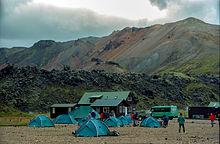
If you're visiting in summertime you won't regret bringing an eye mask with you. During the height of summer there is no actual darkness and in the north, the sun might just dip for a few minutes below the horizon.
For travel during the high season (July and August), and even in September, reserving a month or more in advance can help ensure that you find suitable and affordable accommodation. Reserving later can put you at risk of having to take more costly accommodation.
The hotels are usually fairly basic around the island but you can usually get a room even in August just by phoning them up and reserving it before you get there. They are clean and well maintained, light and airy with nothing at all that could even remotely be considered 'dingy'. They are expensive though.
Fosshotels is a chain of 12 hotels located throughout Iceland, close to the island's most treasured nature spots and major cities of Iceland. The most popular hotel is Fosshotel Nupar, located in by the National Park Skaftafell. The accommodation in Fosshotel hotels is diverse and Scandinavian breakfast buffet is always included. Fosshotels are part of Hotels of Iceland . Berjaya Iceland Hotels include the Edda summer hotels and the Berjaya Iceland hotels. Berjaya Iceland Hotels are upscale, Scandinavian-style hotels located in most major cities of Iceland. Most notable is the Nordica on the outskirts of central Reykjavík.
Guesthouses are between hotels and hostels in prices and services. At some times if travelling in groups the guesthouses can be cheaper than the hostels. Guesthouses will usually have more space than a hostel with a shared bathroom that is cleaner and less crowded. Icelandic Farm Holidays : the members are farmers who offer accommodation to travellers in their homes, guesthouses, country-hotels and cottages. The association was founded in 1980 and from 1990 Icelandic Farm Holidays has been a fully licensed tour operator and a travel agent. The accommodation is diverse; made up beds in four different categories, with or without private bathroom, sleeping bag accommodation, cottages and camping. Some of the farms offer also various recreation; horse riding, fishing, hunting, sailing, swimming, glacier tours, golf, etc. You can get their brochure from tourist information centres or find it on their website. It is very informative and lists all farms, the services they provide, at what time of the year and contact information. It is best to call in advance to book, especially in the summer.
Iceland has many hostels throughout the entire country. Thirty-seven of them belong to Hostelling International Iceland and it is best it to buy the international membership card (if you do not have it already), if you are staying for four or more nights at HI hostels in Iceland or abroad within the next 12 months. Bring your bedlinen or sleeping bag to avoid extra costs.
If you're travelling on a budget, camping is your best bet. There are sites located throughout the country, especially at places you'd want to visit. They range from fully-equipped (hot showers, washing machines, cooking facilities) to farmers' fields with a cold-water tap. Expect to pay kr 1200-2000 per person per night. If you intend to camp in Iceland you must be prepared for the cold, 3-season sleeping bags are essential and an inner. Thick pyjamas and a warm hat are also recommended! A bedding roll is also useful as you may end up sleeping on very rough ground. Don't wait until last minute to find a place to camp. Campers and mobile homes have become immensely popular among Icelanders and they take up a lot of space. You could arrive at a large camping ground that's so filled up with campers and mobile homes that you'll have no place to pitch your tent. It is however, not allowed to camp or park a mobile home anywhere other than these campsites!
Trekkers will need to use some of the mountain huts , either government or privately-run. These range from dormitory accommodation to fully-staffed facilities. Booking ahead is likely to be necessary at popular times of year (and they may be accessible only in summertime).
Don't bother attempting to sleep in Keflavík Airport overnight. It's far better to find a hotel in Keflavík or Reykjavík before arrival. If there are no flights to be serviced in the middle of the night (which is most often the case) the airport is closed for a few hours at night and you might have to stand outside in the rain and wind.
Iceland has eight universities, the oldest and most important of which is the University of Iceland . Public universities in Iceland are heavily subsidised by the government, and hence charge very little in tuition fees. The University of Iceland, for instance, charges only kr 75,000 annually in tuition fees for international students. However, be sure to factor in Iceland's high cost of living when planning your finances. Courses are generally taught in Icelandic, though some courses for exchange students are taught in English. The universities also conduct classes for foreigners to learn Icelandic.
Citizens of Nordic Countries (Greenland, Faroe Islands, Denmark, Norway, Sweden, Åland, Finland), EU/EEA countries and Switzerland are free to take up work opportunities in Iceland.
If you're not from a Nordic/EU/EEA country, getting a work permit can be difficult . Iceland has a relatively strict immigration policy and the government isn't too keen on letting foreigners take away jobs from Icelandic citizens. There also aren't too many positions where foreigners have an edge. However, with a booming tourist industry since the 2010s, there are quite some immigrants in the workforce.
A great deal of emphasis is placed on family ties, personal relationships, and connections. Try to find and use such connections.
Non EU/EEA/EFTA citizens who do not need a visa to visit Iceland can apply for a long-term visa for remote workers ( digital nomads ) and live in the country for a limited time (90–180 days) with spouse and under-age children, provided also these fulfil the visa-free condition. They must, however, prove that they make 1,000,000 kr monthly (1.3 million if including a cohabiting partner). Holders of a digital nomad visa will not be issued a national ID number. The visa does not allow you to get locally employed.
Beware of offers for contracted work in Iceland. Your wage levels may be lower than average and your rights may be affected. Iceland is a highly unionised society with over 90% of the workforce in labour unions.
A great resource is the Directorate of Labour [ dead link ] website.
Iceland is one of the places in the world with the least criminality, so there is almost no chance of getting robbed or harassed. Isolated incidents have, however, been reported, especially in Reykjavík, so it pays to take the usual precautions. Use common sense when sampling the night life.
For severe weather, volcanic eruptions, etc., check alerts from Icelandic weather institution . Keep your phone on, as some alerts are sent as SMS to all mobile phones in the affected area.
Authorities
The emergency phone number is 112 , as in most of Europe. The police are generally polite, professional and honest, and people often comment that they are very helpful and courteous.
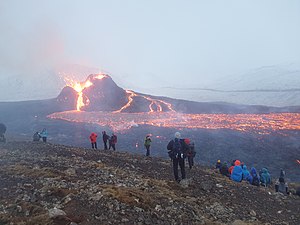
Sure, Iceland's beauty may lie in its scenery and weather, but don't let that tempt you too much. Do not walk on glaciers without proper training and equipment, do not approach a glacier front, do not approach waves on the coast, and do not approach a large waterfall. Every year, many tourists get injured and killed by doing all of this. By being more aware of your location, your surroundings, and the dangers of Iceland's harsh nature, you can prevent a fatal incident. Glaciers and waterfalls can be enjoyed with appropriate skills, on a guided tour, or where safe areas are signposted.
Be prepared for sudden shifts in the weather . Weather in Iceland is unpredictable and its winters can be frigid. Do not walk out in the open in windy weather in the winter: you will become exhausted very quickly. You should make it a point to keep up to date with the country's weather and road conditions daily.
Don't go on long hikes even in summer without somebody who knows how to cope with the dangers.
Natural disasters
Iceland is a volcanically active country . On average, the country experiences a volcanic eruption every four years. If there is one during your stay, pay attention to local news and government warnings. Sure, it may be tempting to look at a volcanic eruption from a distance, but the eruptions can be explosive and violent. Furthermore, volcanic gas can be toxic and even lethal.
Since Iceland is situated on two shifting tectonic plates, earthquakes are quite common in Iceland. On average, the country experiences 500 earthquakes per year. Many earthquakes are small and are not that noticeable. Know this one thing: whenever there's a big earthquake, a volcanic eruption will follow.

Driving in Iceland can be a dangerous experience. Wandering livestock, harsh weather conditions, foggy conditions, and a largely unpaved road network can make things challenging.
About a third of the country's road network is paved and many roads outside the capital are impassible during the winters (October to April). During the summers, roads can become muddy.
If you have no experience with driving in isolated areas with harsh weather conditions or knowledge of Icelandic roads, it is strongly recommended that you do not drive outside of Reykjavik . Outside the capital, help is limited, and if you do not know what you're doing, you can easily get lost or stranded.
If you absolutely must drive outside the capital, a useful resource to check out is Vegagerdin [ dead link ] . Also, consider informing a trusted local about your plans.
The Icelandic Narcotics Police has a very strict policy on drugs; minimum fine for possession of under 1 gram (3/100 of an ounce) of any illegal substance can result in a fine of over 70,000 kr.
Stay healthy
The medical facilities in Iceland are good and subsidised for those with a European Health Insurance Card ( EHIC ) and passport. Scandinavian citizens must show a valid passport to get subsidised medical costs.
Should EU citizens not have the necessary documents then they will be charged for the full cost of the medical treatment. Citizens outside of EU should check if their travel insurance covers medical treatment.
Infectious diseases aren't a problem in Iceland. Inoculations aren't required except if you are arriving from countries that suffer from infectious diseases like cholera.
The biggest threat to your health is likely to be accidental injury or bad weather. Always make sure you have more than adequately warm and waterproof clothing . Selection of appropriate clothing is especially important in Iceland and can even be a matter of life and death. Exercise extra caution in geothermal areas: What may appear to be solid ground can sometimes be not so solid, breaking from underneath your feet with you falling into potentially deadly boiling water.
The water quality in Iceland is excellent and tap water is always drinkable. The hot water coming from tap smells a bit like sulphur, because it is heated by geothermal energy, but it is also safe to drink.
The hygiene in public kitchens is very good, and food poisoning rarely happens to tourists.
- It is not uncommon for an Icelander to ask a foreigner about their opinion of Iceland. The standard question is: "How do you like Iceland?" You don't have to excessively praise the country to be on an Icelander's good side; just be polite. Do not refer to the Icelandic horse as a pony.
- As this is one of the least populated countries in the world, don't be surprised if people in town have heard about your stay.
- There is a sense of community and belonging in Iceland. It's not uncommon for people in small towns and villages to know each other on a personal level, and Icelandic parents are intimately involved in the life choices of their children.
- Icelanders have a near-obsessive fascination with genealogy and charting family history is a popular pastime activity. The Icelanders even have an online database called Íslendingabók , which contains genealogical information about all Icelanders.
- As is the case in all of the Nordic countries , Iceland is an egalitarian country . Everyone, regardless of their vocation, is treated equally. Acting like you're a VIP will be frowned upon and will get you nowhere.
- As is the case in all of the Nordic countries , modesty is a virtue . Bragging and showing off are frowned upon and are widely associated with uncouth behaviour.
- Some Icelanders claim to believe in the hidden people — called huldufólk — and a few even claim to have seen them. They are analogous to elves but are often considered separate. There is even a museum in Reykjavík devoted to the hidden people. This is an ancient Icelandic belief and most Icelanders respect the tradition. Skepticism thus can appear rude.
- It is customary for one to take one's shoes off after entering private homes. In case your hosts do not mind, they will say so.
- Punctuality is not as important in Iceland as it is in many other northern European countries. People may often not appear until 15 minutes later than the stated time, and even much later than that for parties or other social gatherings.
- When speaking English, Icelanders may use the word fuck more often than expected by Anglophones. This is because brusque opinions are commonly expressed and should not be taken badly and also, the Icelandic equivalent of this word is not as strong a swear word as in English.
Sensitive issues
- The Great Recession is a highly emotive, polarising issue. During the Great Recession, the country's banking system collapsed, the country's stock market crashed, and ordinary people lost a great deal of purchasing power.
- Iceland is one of only a few countries with an active whaling industry, and if you choose to assert an anti-whaling position expect some Icelanders to have strong pro-whaling opinions, be well prepared to argue the issue and do not expect to win the argument. Icelandic opposition to the practice of whaling comes from the inhumane way the animals are killed. It takes two to three harpoons to kill the whale, and it takes about 15 mins to die. But Icelanders will not be willing to listen to foreigners tell them what to do. Most whale meat is exported from Iceland and is in general not available for purchase locally.
- Although Lutheranism is the state religion and nominally adhered to by the majority of Icelanders, contemporary Iceland is for the most part rather secular, and only a minority of Icelanders go to church regularly. Nevertheless, even non-religious Icelanders tend to be proud of their churches. Freedom of religion is generally respected so long as you do not proselytise or inconvenience others with your religious beliefs.
In case of emergency call 112 from any phone.
Such calls are free and will be answered by an emergency services operator who will ask you which services you need (police, fire, ambulance, coastguard, rescue teams, civil protection and protection against child abuse) and for your location.
Phone numbers for non-urgent calls to these services differ to where you are situated in the country. Calls for non-urgent medical services in the capital region should be made on 1770 .
Directory enquiries (number lookup) of Icelandic phone numbers are provided by the Icelandic telecom, in the telephone number 1818 .
The Icelandic country code is 354. When calling Iceland from overseas, dial your international access code (with mobile phones, you can use "+" instead) followed by subscriber number; Iceland does not use area codes. Calling from Iceland, the international access code is 00, as in most of Europe.
Payphones are not common, due to widespread use of mobile phones.
Costs for calls from a landline phone are based on a dial-up fee along with a fee for each minute. The dial up fee for all domestic phones is typically 3 kr, each minute to landlines costs 10 kr and each minute to GSM costs around 21 kr (as of December 2014).
Mobile phones are heavily used. The main networks are Icelandic Telecom, Vodafone and Nova. All of them have 4G services, which have equal coverage, covering most of the country. 2G will shut down in 2024 and 3G in 2025. 5G will include the same frequencies as in mainland Europe, the 3.6GHz band started being populated in 2020.
Given that the call is from domestic numbers, there is no charge for calls that you receive on your handset.
Pay as you go (prepaid) plans are available from all three networks. Credit the phone up with a top-up card, at an ATM or at the website of your telecommunications company; there is no contract and no bills. Some operators also offer packages which mix texts, phone calls and data at affordable rates. These packages can come with your initial top-up or deducted from your balance. Additionally, if you have a SIM from another EU/EEA country, you can use your SIM in Iceland under "roam like home" terms subject to your home provider's EU roaming policy.
If you have an unlocked GSM-compatible handset (check band compatibility), you can purchase a SIM card from phone outlets.
Costs for calls from a mobile are based on a dial-up fee along with a fee for each minute. The dial-up fee for all domestic numbers is typically 15 kr, each minute to all domestic phones costs 25 kr and each text message 15 kr, although Vodafone and Nova also sell prepaid plans with unlimited voice included. The cost for Internet access is 12 kr per megabyte (as of May 2019).
Internet hot spots can be found at restaurants, cafés and airports. For the customers of those places, the Internet is free of charge.
A large portion of Iceland has 3G coverage. 3G and 4G data services should roam seamlessly onto Icelandic networks. USB data cards that offer connectivity to 3G or 4G are available from the Icelandic telecommunications companies.
- Has custom banner
- Has caution box
- Has map markers
- Articles with dead external links
- Nordic countries
- All destination articles
- Usable countries
- Usable articles
- Country articles
- Has Geo parameter
- Pages using the Kartographer extension
Navigation menu

From waterfalls and wildlife to the contrast of icy glaciers and dramatic volcanoes, there are countless reasons to visit Iceland .
Planning a trip to the Nordic country? Our travel guide contains up-to-date, personal information on everything from what to see , to when to visit , where to stay , and what to eat !
- General information
- What to see
- How to get there
- Getting around
- Where to stay
- Where to eat
Why visit Iceland?
Iceland's 40,000 square miles (103,000 square km) are home to all the natural wonders one can imagine: waterfalls , geysers , volcanoes , glaciers , natural hot springs , and even bird and whale watching . Its complicated climate and rugged geography mean that its beauty has remained largely untouched by humans for centuries.
The country's immense wealth of nature contrasts with the tranquillity of its towns and cities, where even Reykjavik has fewer than 130,000 inhabitants. This, in turn, has made Iceland the perfect place to delve into ancient Viking legends and Nordic traditions , as in its quiet towns, time seems to have stopped centuries ago.
Tourism in Iceland has increased exponentially in recent years, and it has become the ideal destination for travellers wanting to immerse themselves in Scandinavian history , venture into untouched nature, and enjoy unique experiences such as bathing in the Blue Lagoon while it snows, admiring the northern lights and even feeling like Jon Snow trekking on the Vatnajökull Glacier , which was one of the filming locations for Game of Thrones .
Where to start?
The gateway to the wonders of Iceland is Reykjavik , the country's capital. As well as discovering its culture, museums, and cuisine , you can enjoy a variety of excursions and activities nearby, as many of Iceland's main tourist attractions are located not too far away, such as the Golden Circle or Snaefellsnes .
Looking for a place to stay?
Booking your accommodation in advance is the best way to get great discounts. Our detailed guide on where to stay in Iceland will help you decide the best areas to look for hotels or apartments, and our hotel search engine will find you the best deals!
top activities
Reykjavik Airport Shuttle Have a stressfree trip, and save money and time , by booking a shuttle bus transfer between Reykjavik and the city's airport.
Isafjordur Fjord Whale Watching Are you a wildlife fanatic? If so, this whale-watching tour in Isafjordur , Iceland could be the perfect day out for you. You'll have a blast!
Prepare yourself for an adrenaline rush like no other with Mega Zipline , Iceland's longest and fastest zipline. It will be thrilling!
Whale Watching in Akureyri If you love wildlife, don't miss this incredible whale watching cruise in Akureyri. Spend three hours searching for the majestic creatures in Eyjafjörður.
Shuttle Bus to the DC3 Plane Wreck Get up close to one of Iceland's most visited spots by hopping on our shuttle bus to the DC3 Plane Wreck on Sólheimasandur Beach .
Sky Lagoon is Reykjavik's latest geothermal lagoon . Here you can admire an exceptional view of the North Atlantic while enjoying a relaxing thermal bath.
Icelandic Lava Show in Vík Immerse yourself in the natural phenomena of the Land of Ice and Fire enjoying the Icelandic Lava Show. Learn all about volcanoes in Vík!
Reykjavik Tourist Bus The Reykjavik Hop-On Hop-Off Tourist Bus is a great way to explore the Icelandic capital and discover its important monuments at your own pace.
Northern Lights Tour Enjoy an unforgettable day with this tour which takes you to see the Northern Lights, one of the most spectacular natural sights in the world .
Perlan Museum Ticket With your ticket to the Perlan Museum , you can discover the origins of Iceland and visit its impressive planetarium - a must if you're in Reykjavik !
Jökulsárlón Glacier Kayak Tour Explore the glacial lagoon Jökulsárlón with this fantastic kayak tour. Discover one of the most fascinating places in Iceland.
Landmannalaugar Day Trip Vibrantly colourful mountains, hot springs and volcanic landscapes: discover the incredible Icelandic Highlands on this day trip to Landmannalaugar.
Waterfalls and South Coast Tour Explore the South Coast of Iceland and discover spectacular volcanic landscapes and waterfalls sure to leave you breathless. Unmissable!
Golden Circle Tour Geysir Hot Springs, Gullfoss Waterfall, Thingvellir National Park... Discover the incredible natural landscapes of Iceland on this tour of the Golden Circle.
Godafoss Waterfall & Lake Mývatn Shore Excursion If you're arriving at Akureyri by cruise ship, an excursion to Godafoss Waterfall and Lake Mývatn is a must on any route through northern Iceland!
Reykjavik City Card Get the Reykjavík City Card and explore the most iconic places of Iceland's capital: museums, thermal pools and even a ferry ride!
Askja Volcano Day Trip Delve into the Icelandic wilderness on this day trip to the Askja Volcano: marvel at the stunning natural landscapes and bathe in steaming hot springs.
Secret Lagoon Ticket Relax in a natural pool surrounded by spectacular landscapes: spend a day at the Secret Lagoon in Fludir and make the most of Iceland's hot springs.
Mývatn Thermal Baths Do you want to enjoy a relaxing day at a spa? The Mývatn thermal baths are a must in Iceland. You'll soak in warm waters as you admire the volcanic landscape.
South Coast Tour: Glaciers and Waterfalls Discover the most spectacular landscapes in the country on this south coast tour, where you'll see waterfalls, volcanic plains and the Jökulsárlón glacier lake.
Isafjordur Kayak Tour Discover the natural beauty of the Westfjords form a new perspective on this unforgettable kayak tour around Isafjordur Bay .
Blue Lagoon Tour The Blue Lagoon is one of the most visited places in Iceland. You'll soon realise why when you bathe in its volcanic waters on this tour from Reykjavik!
Blue Lagoon & Northern Lights Tour Relax at the famous Blue Lagoon and see the incredible Northern Lights, one of the most spectacular natural phenomena in the world, on this tour from Reykjavik.
Jökulsárlón Glacier Lagoon Tour A glacer lagoon, awe-inspiring waterfalls and a traditional village: explore the icy landscapes of southern Iceland on this day trip from Reykjavik .
Katla Ice Cave Tour Head deep into the ice cave of Iceland's Kötlujökull glacier , located on the spectacular Katla volcano. Enjoy this unique activity with a guide.
Whale Watching in Húsavík Be captivated by the incredible Icelandic scenery and its wonderful marine life on this whale watching experience in Húsavík .
Black Sand Beach Horse Riding Tour Enjoy a unique experience with this Black Sand Beach Horse Riding Tour. You'll experience a perfect day surrounded by Vikurjfara's most fascinating nature.
Enjoy one of the most spectacular natural phenomena in the world with this Northern Lights tour from Akureyri, a must if you are in Iceland!
Northern Lights Private Tour On this private Northern Lights tour in Akureyri, you'll go in search of this unique phenomenon with an exclusive guide – a once-in-a-lifetime experience!
Diamond Circle Tour Travel through the north of Iceland and discover spectacular locations such as the Godafoss Waterfall and Reykjadalur with this Diamond Circle Tour .
Explore the Sólheimajökull glacier on this kayak tour ! You'll admire the stunning Icelandic nature as you paddle through its icy waters.
Vatnajökull Glacier Tour Enter the blue ice cave of the Vatnajökull glacier and find out how it was formed. This is a must-see location if you're in Iceland!
Reykjavik Fishing Trip Enjoy the unique experience of fishing off the coast of Reykjavik on this angling trip: climb aboard a boat and indulge in a delicious lunch too!
Snaefellsnes Day Trip The Snæfellsjökull National Park is famous for its impressive landscapes . Discover them on this day trip from Reykjavik!
South Iceland Quad Bike Tour Explore a beautiful part of Iceland in a unique way with our South Iceland Quad Bike Tour. You'll see black sandy beaches, volcanoes and abandoned planes!
Godafoss Waterfall Guided Tour Enjoy one of Iceland's most impressive waterfalls while exploring its volcanic landscape with this Godafoss Waterfall Guided Tour from Akureyri.
Vík Zipline On this zipline activity in Vík , you'll have the chance to fly over an impressive river canyon . What an exciting adventure!
Whale Watching by Speedboat Hop aboard a speedboat with us and go on a whale-watching activity in Húsavík Bay . We'll see these incredible marine animals and the famous Icelandic puffins .
Hvammsvík Hot Springs This Hvammsvík hot springs tour is perfect if you're in Reykjavík and are looking for a less touristy place to relax in the Icelandic nature .
Lava Tunnel Tour Delve into a volcanic lava tube on this tour of the caves of Raufarhólshellir, one of the longest lava tunnels in Iceland, on this tour from Reykjavik.
Sólheimajökull Glacier Hike Have you ever dreamt of hiking on a glacier in Iceland ? Dare to embark on this unforgettable hike to the Sólheimajökull glacier .
Hiking in the Westfjords Grab your walking shoes and immerse yourself in the ruggedly beautiful landscapes of the Westfjords on this guided hike from Isafjordur .
Reykjanes Day Trip Mesmerising lakes, active volcanoes and the rift between the Eurasian and North American tectonic plates: all this and more awaits you on Reykjanes Peninsula.
Iceland Volcano Helicopter Tour Marvel at Iceland's latest volcanic eruption on this helicopter tour from Reykjavik, a once-in-a-lifetime chance to see an active volcano up close!
Látrabjarg & Raudasandur Day Trip Experience a day full of unforgettable landscapes with a trip to the Látrajarg cliffs and Raudasandur beach. You'll also get to meet the friendly puffins.
Golden Circle & Horse Riding Tour Immerse yourself in the rugged natural landscapes of Iceland's famed Golden Circle on this day trip from Reykjavik and enjoy a horseback riding tour!
Blue Mountains + Leidarendi Cave Quad Tour Enjoy the winter scenery with this quad bike tour through the Blue Mountains of Iceland and explore the depths of a lava cave!
Want to experience something unique? Enjoy flying over one of the most breathtaking landscapes in the south of Iceland on this paragliding activity in Vik!
Godafoss & Lake Mývatn Day Trip Explore the craters of North Iceland and gaze upon one of the most stunning waterfalls in Europe on our Godafoss & Lake Mývatn day trip .
Whale Watching in Hauganes Discover the wildlife of northern Iceland on this whale watching boat trip in Hauganes. You'll be captivated by the incredible animals here!
Explore the captivating highlands of Iceland with a journey to Kerlingaföll and a visit to the geothermal wonders ofHveradalir on this trip from Reykjavík .
Falljökull & Fjallsjökull Glaciers Hike & Boat Trip Discover two breathtaking spots and walk along a glacier tongueon our Falljökull & Fjallsjökull Glaciers Hike & Boat Trip.
Solheimajokull Ice Climbing & Glacier Hike Fasten your harness and crampons and join us on this ice climbing and hiking activity on the Sólheimajökull glacier – a unique and thrilling experience!
On this tour, experience the crystal clear waters of the Silfra fissure as you snorkel between 2 continents and relax at the Laugarvatn Fontana spa .
Silfra Snorkelling & Northern Lights Tour On this activity, we'll snorkel in the Silfra Fissure then head to the Thingvellir National Park to hopefully see the Northern Lights!
On this tour of Isafjordur , you'll enjoy a day of sports like kayaking and cycling . The stunning natural scenery will leave you breathless!
Helicopter Ride over Skaftafell or Lakagigar Take a helicopter tour over the landscapes of Skaftafell or Lakagigar , immersing yourself in the natural wonders of Iceland's most beautiful national parks .
Patreksfjördur & Tálknafjödur Fjords Hike Discover two of Iceland's most breathtaking fjords and see incredible views on this Patreksfjördur and Tálknafjödur Fjords Hike !
Raudasandur Day Trip Visit one of Iceland's best beaches on this Raudasandur Day Trip . You'll see breathtaking Icelandic scenery and walk along Raudasandur's famous red sand!
Dynjandi, Arnarfjördur & Bíldudalur Day Trip Explore Dynjandi, Arnarfördur, Bíldudalur and many more incredible places in the Westfjords on this day trip. You'll have an unforgettable day!
Lake Mývatn Day Trip Explore a beautiful lake and its surroundings on this Lake Mývatn Day Trip . You'll venture to a volcanic region in northern Iceland!
Discover the secrets of Europe's second-largest glacier , on this tour of Lagjökull glacier ice cave . An unforgettable experience!
Whales of Iceland Ticket Immerse yourself in Iceland's aquatic world with this ticket to the Whales of Iceland exhibition . You'll discover all kinds of whales!
Northern Lights Tour + Whale Watching This activity combines the main attractions of northern Iceland in winter: seeing the Northern Lights and going whale watching in the Eyjafjord!
Whale Watching by Speedboat Enjoy the unique experience of whale watching on a speedboat tour of Faxaflói Bay off the coast of Reykjavik. Get up close to the incredible creatures!
Day Trip to the Arctic Coast Want to see Iceland's famous black sand beaches and visit the villages of Siglufjörður and Hauganés ? Join us on this trip to the Arctic coast and Tröllaskagi.
Make the most of your stay in Akureyri and hike the Askja volcano . We'll admire the beautiful scenery of the wildest nature in the north of Iceland !
Dettifoss, Húsavík, Lake Mývatn & Ásbyrgi Day Trip Visit incredible natural areas on our Dettifoss, Húsavík, Lake Mývatn & Ásbyrgi day trip - one of the most famous routes in northern Iceland .
Private Tour of Reykjavik With this private tour of Reykjavik you will have a guide exclusively at your disposal, so you can discover the main monuments of the Icelandic capital .
On this rafting tour along the Hvita River , you'll get your adrenaline pumping surrounded by a breathtaking natural setting - rafting down a glacial river!
Silfra Snorkeling Tour On this trip to Thingvellir National Park , you'll enjoy one of the most incredible experiences in Iceland: snorkelling in the Silfra Fissure .
Northern Lights Centre + Aurora Borealis Tour Come and have an unforgettable experience on this Aurora Borealis tour in Reykjavik . In addition, you can visit the Northern Lights Centre .
Seljalandsfoss & Skógafoss Waterfalls + Sólheimajökull Glacier The Seljalandsfoss and Skógafoss waterfalls and the Sólheimajökull glacier await you on this tour from Reykjavík, three must-see places in southern Iceland!
Geothermal Hot Springs Helicopter Tour in Hengill Join us and discover the geothermal area of Hengill from a totally unique perspective on this helicopter tour from Reykjavik .
Deildartunguhver & Vidgelmir Cave Tour On this tour to Deildartunguhver Spring & Vidgelmir Cave, we'll discover the largest lava grotto in Iceland and the fastest-flowing hot springs in Europe!
Eco Boat Whale Watching Have an incredible whale watching experience in the most ecologically responsible way on this carbon-neutral tour in Húsavík .
Whale Watching Sail the coast of Iceland, and marvel at the whales of the North Atlantic in their natural habitat, seeing these impressive mammals up close .
On this jeep tour through the winding Icelandic roads of the Westfjords , we'll take you to the cliffs of Látrabjarg and the iconic beach of Raudasandur .
Silfra Snorkelling Experience Can you imagine snorkelling between two continents? Dive into the Silfra fissure and swim between the North American and Eurasian tectonic plates.
Whale & Dolphin Watching under the Midnight Sun Can you imagine anything more magical than seeing whales and dolphins swimming in the waters around Iceland under the incredible light of the midnight sun?
Skaftafell Ice Cave Tour & Glacier Hike Enter a world of ice and snow: discover the wonder of Iceland's mesmerising blue ice cave and hike over the enormous Vatnajökull Glacier . Unforgettable!
Reykjavik Christmas Tour Get into the Christmas spirit on our Reykjavik Christmas tour . Iceland's capital is filled with craft stalls, towering trees and twinkling lights.
Vatnajökull Glacier Hike Enjoy hiking on top of Vatnajökull glacier, the largest glacier in Iceland . This incredible natural location is sure to take your breath away!
Silfra Snorkelling & Golden Circle Tour Snorkel between two continents at Silfra and explore the breathtaking landscapes of Iceland on this unmissable tour of the Golden Circle from Reykjavik .
Puffin Watching in Reykjavik Puffin watching is a must-do activity on your trip to Reykjavik . Cruise around the ruggedly beautiful Icelandic islands in search of the birds.
Mýrdalsjökull Glacier Snowmobile Tour Enjoy an unforgettable experience on this snowmobile tour around the Mýrdalsjökull glacier . You'll discover one of the most amazing spots on southern Iceland.
Northern Lights & Laugarvatn Fontana Spa Tour Experience two of Iceland's most popular attractions: enjoy its goethermal waters at the Laugarvatn Fontana Spa and see the magical Northern Lights!
Snowmobile around Lake Mývatn Enjoy an adventure-filled day in eastern Iceland on this thrilling snowmobile ride around Lake Mývatn as you take in breathtaking volcanic landscapes !
Golden Circle and Northern Lights Tour This tour combines the famous Golden Circle and an excursion that will take you to see the stunning Northern Lights , discovering Iceland's main attractions.
South Iceland Snowmobile Tour Feel like an explorer touring southern Iceland's glaciers on a snowmobile , discovering the island's most incredible waterfalls on an unforgettable adventure!
Whale Watching by Sailboat Sail around the coastline of northern Iceland by schooner in search of magnificent sea creatures on this whale watching sailboat trip from Husavik .
Why is our Iceland travel guide the best?
Introducing Iceland is a guide written by travellers for travellers , and contains personalized advice to help you make the most of your trip to the country. This guide will help you discover the main tourist attractions , what the typical dishes are, the best areas to stay , and our Top 10 recommendations .
The practical information in this Iceland Guide was collected in January 2023 . If you find any errors or have any comments, please feel free to contact us .

Our travel guides
- top attractions
- where to stay
- and much more
- Search Please fill out this field.
- Manage Your Subscription
- Give a Gift Subscription
- Newsletters
- Sweepstakes
- Destinations
25 Best Things to Do in Iceland, Glacier Lagoons and Volcano Treks Included
Experts recommend how to explore the Nordic country.
:max_bytes(150000):strip_icc():format(webp)/vanessa-wilkins-1b9202b10956475e99e5385912316608.jpg)
There are few places in the world quite as magical as the country of Iceland. From natural wonders like Gullfoss Waterfall and the Northern Lights to the buzzing culinary scene and fascinating history and culture of this Nordic island, Iceland has much to offer travelers.
skynesher/Getty Images
If you’re planning a trip to the land of fire and ice, it can be challenging to narrow down what sights and activities to put on your itinerary. I experienced this myself when I planned a hot springs tour around the country a couple of years ago; this time, I turned to the pros for advice. Travel + Leisure spoke with three local experts to gather their thoughts on the best of Iceland. Davíð Logi Gunnarsson, head guide of Nordic Luxury , shared his favorite museums, food and drink, and outdoor activities to check out; Dofri Hermannsson, expert hiking guide and owner of Reykjavik Erupts , shared top hikes to tackle and small businesses to frequent; and Aggi Sverrisson, executive chef at Moss Restaurant at the Retreat, offered restaurant and bar recommendations for every type of occasion. Without further ado, here are 25 of the best things to do in Iceland.
The National Gallery of Iceland
Grady Coppell/Getty Images
The National Gallery of Iceland is located in the heart of downtown Reykjavik and has more than 14,000 pieces in its expansive collection. The gallery features 19th-, 20th-, and 21st-century works celebrating and preserving Icelandic culture, and there is a large variety of international art as well. “From traditional to contemporary works, [The National Gallery of Iceland] offers a captivating glimpse into the nation’s creative heritage,” says Sverrisson.
The Akureyri Art Museum
The Akureyri Art Museum is located in the center of Iceland’s second-largest city, and its collection focuses solely on visual arts. Showcasing work from both local and international artists, the museum serves as a cultural hub for the artistic community in North Iceland. Explore the museum at your own pace or visit on a Thursday, when guided tours are available.
Bjarnarhöfn Shark Museum
Martin Zwick/REDA&CO/Universal Images Group via Getty Images
Fermented shark is one of Iceland’s most unique culinary traditions, and you can take a deep dive into the connection between Iceland and Greenland sharks at the Bjarnarhöfn Shark Museum . Located in West Iceland on the Snæfellsnes Peninsula, this museum highlights the destination's long history of shark fishing, the fermentation process, and the importance of these predators to Icelandic culture. You can even try fermented shark yourself here.
National Museum of Iceland
Spencer Platt/Getty Images
This museum showcases paintings, statues, and other artifacts from Iceland’s storied past. It’s located within walking distance from Reykjavik's center and is the perfect way to spend a rainy day or lazy afternoon in the city.
“A local favorite, this restaurant is tucked away on the western edge of Reykjavik and is surrounded by the sea in a nature reserve,” says Gunnarsson. “It’s cozy, and the menu emphasizes locally sourced ingredients while drawing inspiration from the simplicity of Italian cuisine.” While the restaurant is great to visit any time of year, winter can bring the backdrop of a lifetime, when you might see the Northern Lights right from your table.
Moss Restaurant
Courtesy of Moss Restaurant
Moss is a fine-dining restaurant located inside The Retreat at the Blue Lagoon in Grindavík. The restaurant's innovative tasting menu features the best of Icelandic meat and produce, and it was awarded its first Michelin star earlier this year. With breathtaking views of the mystical Blue Lagoon, a meal at Moss makes for an unparalleled culinary experience.
Monkeys is the perfect place to kick off a lively night out in Reykjavik. Located near the popular Laugavegur street, the eclectic Nikkei restaurant boasts bright and colorful decor that complements the exotic dishes and spectacular cocktails it serves. “The Peruvian Japanese-inspired menu showcases a large selection of small dishes and tasting menus bursting with flavors that celebrate the palate,” says Gunnarsson.
Pakkhús Restaurant
For some of the best seafood in the country, head to Pakkhus Restaurant in Höfn. Set in a converted warehouse along the harbor, the unpresuming restaurant features a top-class menu focused on fresh and locally sourced ingredients. Sverrisson notes that the restaurant’s specialties include unique langoustine creations, so make sure to add one or two fresh lobster dishes to your order.
Kaffibarinn
One of the oldest bars in the city, Kaffibarinn is a staple of Reykjavik’s nightlife scene. During the day Kaffibarinn operates as a coffee shop, but at night tourists and locals alike flock here for the high-energy DJ sets, the hip atmosphere, and of course to dance all night long. “This is the place to see and be seen,” Gunnarsson says.
Accoridng to Sverrisson, Port 9 is "A pioneer in Icelandic wine culture.” Tucked away on a quiet residential street in Reykjavik, the intimate wine bar has an unbeatable selection of international wines, plus small bites to nibble on between pours. The inviting ambiance of the wine bar makes it the perfect spot for a date night or small group tasting.
Even though it’s located on the busy Laugavegur street, this cozy bar feels more sophisticated than your typical brewery. “[Kaldi] is popular with locals and offers a great selection of Icelandic microbrews,” says Gunnarsson. “This place is bustling every evening, so be early.”
Grotta Lighthouse
Rudolf Ernst/Getty Images
Escape the city lights with a leisurely hike from downtown Reykjavik to the Grotta Lighthouse on the Seltjarnarnes Peninsula. “On a summer evening, it is great to hike from Harpa Conference Hall towards the lighthouse,” says Hermannsson. Stunning sunsets are a treat in the summer, and in the winter months the clear skies are perfect for watching the Northern Lights.
James Hartshorn/Getty Images
If you have access to a car, Hermannsson recommends driving to the base of Mount Esja , which is located about 50 minutes outside of Reykjavik in the southwest region of Iceland. Arrive ready for a heart-pumping hike at this year-round spot. There are many different hikes to choose from, and signage along the way to keep you on the path that best suits your experience level. Once you reach the nearly 3,000-foot summit, you can take in the jaw-dropping views of the city, the bay, and beyond.
Litli-Hrútur Volcano
Sner/Getty Images
Hiking a volcano is one of the most thrilling adventures you can embark on in Iceland, and Litli-Hrutur is the newest eruption. This particular hike is no easy trek, and since conditions are ever-changing, make sure you’re adequately prepared if you want to make the journey. “For a full experience, hire a local expert guide who knows everything about the volcanic activity of the Reykjavik area," says Hermannsson. "It really makes the Earth come alive under your feet."
Landmannalaugar
Neurobite/Getty Images
“ This otherworldly landscape captivates even the most experienced hiker,” Gunnarsson says of Landmannalaugar. “Located in the highlands of Iceland, the colorful mountains, hot springs, and steam vents in this unique place provide an unforgettable landscape and a silence that only a few have experienced in nature.” The best time to visit is mid-June to mid-September, when the long summer days allow you to take in as much of the boundless beauty of the reserve as you can.
Þjórsárdalur
Scenic views take on a new meaning on this hike alongside Þjórsá, Iceland’s longest river. The breathtaking trek leads to Háifoss, one of the tallest and most dramatic waterfalls in Iceland. Along the way you’ll encounter much more natural beauty, including the Búrfell Forest and Fossalda mountain.
Kaffitar is a small coffee chain with four cafes located around Reykjavík. Founded in 1990 by Adalheidur Hedinsdottir, the company is now one of the leading coffee names in Iceland, in part thanks to its emphasis on nurturing relationships with the farmers who supply its coffee beans. “[Hedinsdottir's] specialty coffee and the original cafe she opened were a hit, and now she runs several cafes, still getting her beans directly from farmers in South America," says Hermannsson.
Skool Beans
Joshua Schumacher
Skool Beans is Iceland’s smallest micro-roaster. On the southern coast of Iceland inside a classic yellow school bus, you will find this unique café in the small town of Vík. “The rustic ambiance, as well as the exemplary coffee and chocolates, make for the best casual conversations with fellow travelers,” notes Gunnarsson.
Reykjavík Röst
What better way to start your morning than a cup of coffee with a great view? Located near the water on the Old Harbor, Sverrisson dubs Reykjavik Röst “one of the best coffee shops” in the city. “It offers all your standard coffee drinks, as well as maple sage lattes, keto coffee, and magic mushroom coffee. It also has a great selection of Icelandic cakes and traditional pastries, as well as amazing views.”
Blue Lagoon
Makito Umekita/Travel + Leisure
This geothermal spa has gained international fame as a modern wonder of the world. Located in a black lava field in Grindavik, visitors can soak in the milky-blue waters known for their healing properties due to the silica and sulfur found in the water. Just 15 minutes from the Keflavik Airport, it’s the perfect activity right after landing or just before leaving Iceland
Hallgrímskirkja
Irjaliina Paavonpera/Travel + Leisure
One of Reykjavík's most historic landmarks, this gorgeous church rests on top of a hill in the center of Reykjavik and stands out due to its height and distinctly shaped spire and side wings. Built to resemble basalt columns, the 244-foot church is the tallest in Iceland, and in addition to operating as a church it serves as an observation deck. “My favorite way to visit is to go up the bell tower and take in the panoramic views of the city from the observation windows,” says Gunnarsson.
Set on the coastline of Reykjavik, Sólfar (or Sun Voyager) is a striking sculpture meant to serve as an ode to the sun. Created by Jon Gunnar Arnason, the stainless steel sculpture was inspired by world expeditions and symbolizes light, hope, and the promises of undiscovered territory. Check out the artwork at sunset for a stunning view that will leave you just as inspired as Arnason was when he created this masterpiece.
imageBROKER/Robert Haasmann/Getty Images
“Awe-inspiring in its perfect conical shape, this ancient volcano sits like an island of greenery in a vast field of black sands and glacial streams,” says Gunnarsson. Standing more than 2,500 feet above the highlands of Southern Iceland, Mælifell is a monstrous volcano and an ode to Iceland’s otherworldly landscapes. It's a must-see for adventure seekers, but note that due to its remote location, Mælifell is only accessible in the summer months. Those who manage to make it to this natural wonder will marvel at its truly majestic setting.
Jökulsárlón Glacier Lagoon
patmeierphotography.com/Getty Images
Jökulsárlón is Iceland’s most famous glacier lagoon, with massive icebergs looming over Jökulsárlón lake. “This is one of Iceland’s most popular landmarks, and it's the deepest lake in the country,” notes Sverrisson. “It’s located on the south coast and offers awe-inspiring views of floating icebergs, black-sand beaches, seals, and so much more.”
Grjotagja Cave
Gannet77/Getty Images
This small lava cave is a hidden gem on Iceland’s famed Ring Road. Located near Lake Myvatn, the inconspicuous hideout is known for the bubbling geothermal hot springs found inside the cavern walls. The jagged rocks and turquoise waters make Grjotagja a hauntingly beautiful landmark to visit.
Related Articles

Your Guide to Reykjavik & Iceland
Find places, shops, restaurants and things to do, discount coupons, list of happy hours, browse our book 2025.
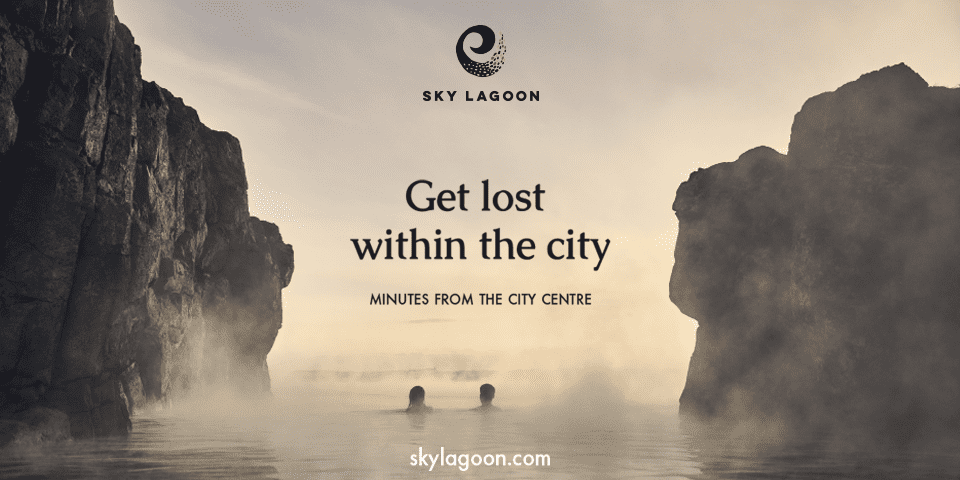
Pubs & Nightlife
Tours & activities, towns & places, accommodation, driving in iceland, search the map.

Ferðamálastofa Icelandic Tourist Board
Iceland is a safe place to visit, tourist numbers in july.
- Numbers of foreign visitors See the numbers
- Foreign service providers Rules that apply to service providers established abroad
- Icelandic Route Development Fund Grants Available for Airlines flying directly
- Do you offer trips or tours? Then you might need a license from us
News headlines

Winter conditions can be expected in the highlands

Volcanic activity has resumed on Reykjanes Peninsula

Foreign tourism service providers operating in Iceland

Apply for grant from NATA: Tourism development, Marketing or Travel Support

Receives its quality and environmental certification and securing gold in the environmental section

277 thousand departures of foreign travelers in July

212 thousand departures of foreign travelers in June

157 thousand departures of foreign travelers in May

Important Weather Advisory for Travelers in Iceland: June 3rd-6th, 2024 - Update

Eruption has started on the Reykjanes Peninsula
News from iceland, data and publications.
We manage various research projects and publish material about Icelandic tourism
Icelandic Tourism Dashboard
Find all the latest data from Tourism in Iceland right here, in the Tourism Dashboard.
The Tourist Site Protection Fund
The fund supports the development and protection of tourist destinations and tourist routes owned both by private entities and municipalities.
12 top places to visit in Iceland in 2024
Mar 12, 2024 • 8 min read

Iceland has lots to offer – here's our 12 favorite places to visit © evenfh / Shutterstock
Iceland appears on the must-do lists of many travelers – its charming cities and towns, other-worldly landscapes and astronomical phenomena keep the crowds coming back for more every year.
But how do you choose the highlights of your trip in a country packed with so many of them ? Don't worry, we've picked twelve incredible places, some of which are on the beaten path and some of which are not, but all of which might surprise you. Here are our favorite places to visit in Iceland in 2024.
1. Mosfellsbær
Best for a quiet escape near Reykjavík
Reykjavík’s friendly rural neighbor is Mosfellsbær . Its biggest attractions are the small mountains that surround the town, including Úlfarsfell, Mosfell, Helgafell and Reykjafell – all great for short hikes. Lake Hafravatn is a gem that locals flock to for swimming and kayaking fun. Time your visit to coincide with the popular vegetable market that carries the produce of local farmers, open every Saturday in late summer in the valley.
The valley is also host to Gljúfrasteinn , a museum dedicated to Nobel Prize laureate Halldór Laxness, and Laxnes farm, which offers horseback riding tours. Álafosskvos is a tiny art and design village with a long-standing yarn store and local craft stores full of beautifully made items you'll want to bring home.
Planning tip: You can visit Mosfellsbær year-round. Þingvellir National Park is a short drive away – avoid the crowds by visiting between September and May .
Best base on the Golden Circle
In rural South Iceland lies Flúðir, best known for its mushroom greenhouse. If mushrooms are your thing, the greenhouse’s bistro offers all things funghi-related. Continue your gastronomic adventure and try authentic Ethiopian food at Minilik . Nearby is the Secret Lagoon , known locally as Gamla Laugin, and Hrunalaug , a small natural pool with stacked stone walls in the peaceful countryside. Flúðir is on the Golden Circle with some of the country’s best-known attractions within reach – it’s the perfect base for exploring the region.
Planning tip: It’s best not to visit Flúðir in the summer. It's the height of the tourist season, and spring and autumn are more enjoyable.

3. Stokkseyri
Best kayaking tours near Reykjavík
This charming South Coast village attracts foodies from far and wide to its seafood restaurant Fjöruborðið – the lobster is especially popular. Kayaking in its narrow channels is a calm and fun activity, and the neighboring village of Eyrarbakki has beautifully restored timber houses and a heritage museum in a home that seems frozen in time. Nearby is Raufarhólshellir , one of the longest lava tubes in Iceland.
Planning tip: You can visit Stokkseyri and engage in most of the activities year-round, but service hours may change in winter, and kayaking depends on the weather.
Best base for glacial tours
In the kingdom of Vatnajökull , harbor town Höfn welcomes you with its lobster restaurants and stunning glacial views. This is a great base for exploring Europe’s largest glacier, from Jökulsárlón and other glacial lagoons with their floating icebergs to glacial hikes, snowmobile tours and ever-changing ice caves. Among local tour operators is the family-run company Glacier Journey .
Planning tip: You can visit year-round, but the ice-caving season is roughly from November through March. Glacial hikes are usually not possible at the height of summer. Always go with a guide and in good weather.
5. Borgarfjörður eystri
Best place for puffin-watching
The tiny village of Bakkagerði is surrounded by colorful mountains in Borgarfjörður eystri, one of the more remote Eastfjords. Getting there is an adventure in its own right as the road winds its way up and down a mountain pass. As you enter the village, time seems to slow down. Here you can relax and enjoy nature, go on hikes, explore on two wheels or treat yourself to a boat tour and watch puffins up close from the bird-watching house on Hafnarhólmi.
Planning tips: To see puffins, visit from mid-May to early August. Christmas-related events take place during Advent, and snow sports are possible during winter.

6. Hallormsstaðaskógur
Best for camping in the woods
Visit Iceland’s largest forest and be amazed by its size. The campsite in Atlavík , on the banks of Lake Lagarfljót, is one of the country’s best and most popular among local tourists. There are 40 km (25 miles) of walking paths around the forest, so you can lose yourself among the trees and then climb up and enjoy the view of the lake – perhaps even catch a glimpse of the vicious wyrm that is said to inhabit it. Egilsstaðir, East Iceland’s largest town, is only 30 minutes away, and some of the region’s biggest attractions, like Hengifoss waterfall , are also close by.
Planning tips: Visit between June and August for camping. A forest festival is held around Midsummer’s Day, and mid-August to mid-September is the berry-picking season. Enjoy autumn colors from late August through October.
Best place for whale watching
Visit Iceland’s whale-watching capital and enjoy the friendly atmosphere as you stroll around the harbor. Joining a whale-watching tour of Skjálfandi Bay with one of the local tour operators is a must, perhaps combined with a bird-watching tour or a visit to Flatey Island , which was inhabited until the 1960s.
Learn more about whales at the fascinating Whale Museum , enjoy a beer at Gamli Baukur and try the salted cod at Salka Restaurant . Afterward, soak in the geothermal waters at Geosea and take in the gorgeous view of Skjálfandi. Húsavík is on the Diamond Circle and Arctic Coast Way.
Planning tips: Whale watching is available from March to November but is most enjoyable during the summer months.
8. Hauganes
Best place for a special bathing experience
There’s more than meets the eye at this hamlet on the shore of Eyjafjörður in North Iceland. The hot tubs on the beach have become quite the attraction, and it’s also tempting to brave the frigid waves. Try the salted cod at Baccalá restaurant and bar – it's prepared by local company Ektafiskur. You can also catch your own fish on sea angling tours and go whale watching from Hauganes. In the nearby village of Árskógssandur, Kaldi beer is brewed, and the brewery also offers beer baths . The ferry to the idyllic island Hrísey goes from Árskógssandur.
Planning tips: Visit for the midnight sun in the summer and northern lights in winter. Sea tours are best enjoyed in the summer.

9. Siglufjörður
Best for snow sports
Although it's best known as the location for the crime series Trapped , Siglufjörður is not scary at all. It’s a peaceful fishing community that used to be isolated – trapped, if you will – between tall mountains but has now been connected to the neighboring town of Ólafsfjörður by a tunnel. It was one of Iceland’s bustling herring processing centers during the boom that reached its height in the mid-20 th century.
This remarkable history is documented in the Herring Era Museum . Today, Siglufjörður is one of North Iceland’s centers for snow sports – don't miss the popular Moroccan restaurant in town after a day on the slopes. Siglufjörður also has a beloved ski resort , and off-piste skiing is possible in the mountains of the Tröllaskagi peninsula.
Planning tips: Visit between January and March for cross-country and Alpine skiing at resorts. Off-piste skiing is usually possible through May.
10. Hólmavík
Best base for exploring Strandir
On the northern coast of the Westfjords lies the fishing village Hólmavík, which has made a name for itself with its Museum of Sorcery and Witchcraft . Diving into Iceland’s darker past, it tells tales of sorcerers and magic spells, witch burnings and other heinous acts. In a charming old house, Café Riis serves delicious pizzas and other treats.
The nearby town of Drangsnes has several beachside hot tubs that could easily tempt you to spend the rest of the day gazing at the incredible scenery. A bumpy – and slightly scary – gravel road continues onwards along the Strandir region to some of Iceland’s remotest communities in Árneshreppur. At the edge of the world, you can book a night at Hótel Djúpavík .
Planning tips: It’s best to visit in summer as the road to the remoter communities is often hazardous or closed in winter.
Best place for quiet contemplation
In the middle of Breiðafjörður Bay, between the Westfjords and Snæfellsnes Peninsula , is an island which seems to have been lost in time. Only a handful of people live there year-round, but in summer the village comes to life when part-time residents come and stay in the beautifully restored houses. Walk around Flatey among grazing sheep and busy seabirds (watch out for the Arctic terns), look out at the ocean and find inner calm. The ferry goes between Stykkishólmur and Brjánslækur .
Planning tips: It’s best to visit in summer when the weather is more stable for sailing and more services are open.
12. Húsafell
Best resort for diverse experiences
In the innermost part of Borgarfjörður in the West, almost at the foot of Langjökull glacier, is the forested paradise of Húsafell – its hotel, campground and cottages have made it very popular among local tourists. There are both easy and challenging walking paths, including to the spectacular waterfalls of Hraunfossar and Barnafoss. Glacial tours are available from Húsafell, and Víðgelmir , a massive lava cave, is just a few minutes away. You can soak in the on-site swimming pools or go on a hike to the more exclusive Canyon Baths .
Planning tips: Visit year-round. Summer is best for camping and hiking, and winter is best for viewing the northern lights.
This article was first published Apr 15, 2021 and updated Mar 12, 2024.
Explore related stories

Budget Travel
Jul 31, 2024 • 5 min read
Terrified of local tipping customs in Europe? Fear not. Follow our guide for the social norms on gratuity across the continent.

Jul 17, 2024 • 17 min read

Mar 30, 2024 • 4 min read

Mar 7, 2024 • 5 min read

Feb 6, 2024 • 7 min read

Jan 2, 2024 • 7 min read

Dec 1, 2023 • 6 min read

Nov 13, 2023 • 5 min read

Nov 3, 2023 • 4 min read

Jan 2, 2023 • 12 min read

23 Top-Rated Tourist Attractions in Iceland
Written by Anietra Hamper Updated Mar 14, 2023
Author Anietra Hamper has traveled throughout Iceland tackling outdoor adventures, from four-wheel driving over lava fields and fishing to taking in the waterfalls, hiking trails, and scenic drives.
Iceland, the island of fire and ice, has become one of the world's top travel destinations , not only for thrill-seeking adventurers but also for nature lovers looking for something different.
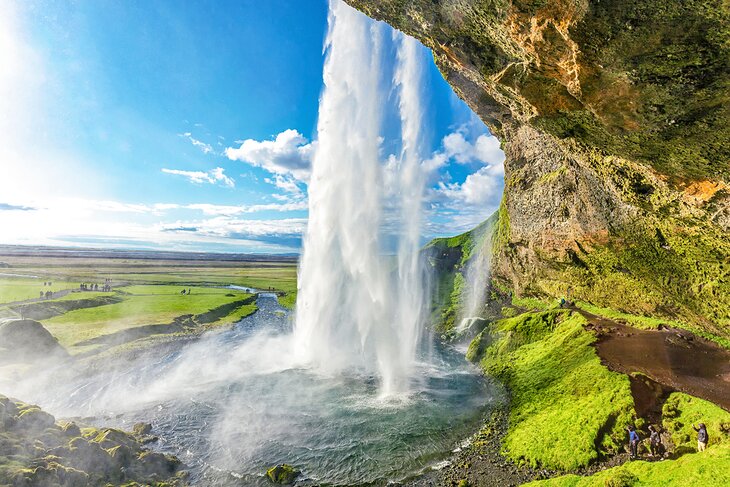
Here, you'll discover active volcanoes, geysers, hot springs, glaciers, ice fields, and fjords, for this sparsely populated country, resting at the edge of the Arctic Circle, sits atop one of the world's most volcanically active areas.
One way to explore Iceland is on your own with a rental car, from several days to a week, including a trip along the Ring Road that runs in a complete circle around the country.
Another way to plot your adventure in Iceland is with tours that can take you to the best options to see the northern lights; ATV trekking; and on day trips from Reykjavik to see some of Iceland's most stunning natural beauty, like the Blue Lagoon and waterfalls.
Find out more about the best places to visit with our list of the top attractions and things to do in Iceland.
Explore Reykjavik by Foot
Ride to the top of hallgrímskirkja, soak in the blue lagoon, grindavík, gullfoss waterfall, spot whales out of reykjavik, watch spectacular geysers, take in the northern lights, aurora borealis, hike in landmannalaugar nature reserve, maelifell volcano & myrdalsjökull glacier park, attend a concert at harpa, explore the skaftafell ice cave, vatnajökull national park, visit an active volcano at askja caldera, feel the spray of dettifoss waterfall, kirkjufell mountain, grundarfjördur, hiking at mount esja, walk the town of akureyri, bird-watching at lake myvatn & nature reserve, the pearl observatory (perlan), rev up adventure with an atv trek, float along a glacial lagoon, reynisfjara black sand beach, tour the raufarhólshellir lava tunnel, visit iceland's quirky museums, best time to visit iceland.
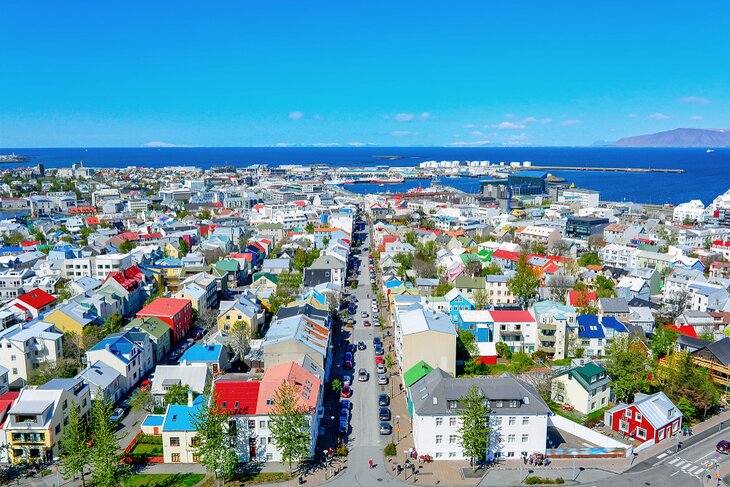
The best way to start your trip to Iceland is by sightseeing in the capital city of Reykjavik . This is a walkable city with many museums, restaurants, attractions, public art, and entertainment.
Take a stroll to see some of the iconic locations in the city, like Hallgrimskirkja church and the Sun Voyager sculpture, or relax in one of Reykjavik's 17 thermal pools. You will enjoy walking up and down the city streets and perhaps stop into one of the many artsy and boutique shops to buy a wool sweater or lava pottery.
You can also book a Reykjavik Food Walk Tour and nibble your way through Reykjavik's food scene enjoying local cheeses, or try an authentic Icelandic hot dog.
Some of the best resorts in Iceland are in Reykjavik, so you can base yourself in the city and take day trips. An extremely popular way to visit nearby areas is on a South Coast Full Day Tour by Minibus from Reykjavik.
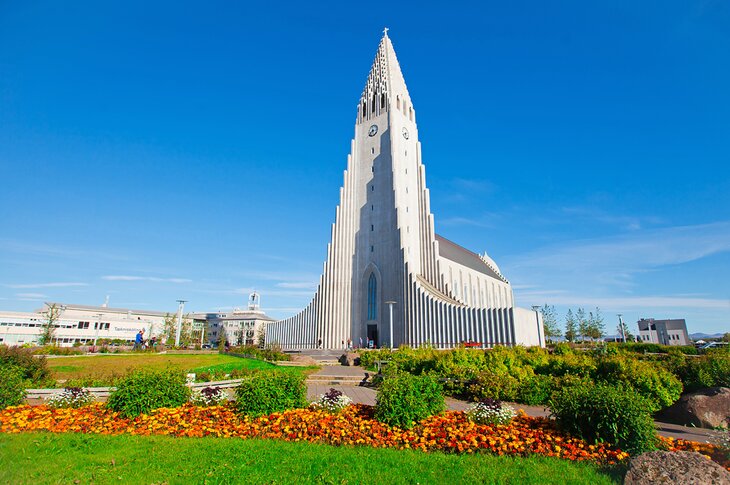
A Reykjavik modernist icon, this visually striking church is one of the city's top attractions, and when you see it, you'll understand why. Hallgrimskirkja is the tallest and most recognizable building in the country .
The Black Falls (a basalt rock formation), which is one of Iceland's natural wonders, inspired the architectural design. A climb to the top of the 73-meter-high tower is particularly rewarding. Here, you'll be treated to spectacular views across the city and surrounding landscape. At the front of the church is a statue of Icelander Leifur Eiriksson ("Leif the Lucky"), the first European to discover America around 1,000 CE. It seems he beat Christopher Columbus by around 500 years or so. For a small fee, you can take the elevator to the top and get the best panoramic view of Reykjavik.
Address: Hallgrímstorg 1 101, Reykjavik
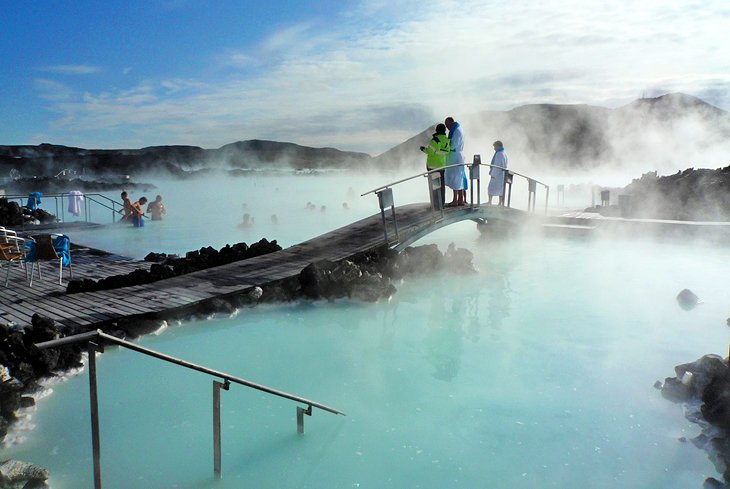
Just 40 minutes' drive from Reykjavík, the Blue Lagoon , the most iconic of geothermal spas, is a must-see tourist attraction. Here, you'll find natural bathing in pale blue water in the shadow of a power station.
An entire Blue Lagoon industry has grown around this attraction since it first became a hit with locals in 1976. The water from the underground hot springs reaches 37-39 degrees Celsius and is said to be highly beneficial for both health and skin. If the die-hard Icelanders are anything to go by, don't knock the theory. Aside from bathing in a unique setting, there's a shop selling skincare products, a range of spa treatments, and places to eat and drink. Don't visit Iceland without coming here.
Rub on a mask of natural mud in minerals from one of the tubs located on the edges of the lagoon. For the ultimate relaxing visit, you can stay at one of the two hotels at the Blue Lagoon and add on a day at the Retreat Spa.
It is easy to book a bus trip to the Blue Lagoon from Reykjavik, but if you want to add an extra element of Iceland adventure, you can book a day trip on an ATV that will have you drive there over lava rock paths and take you back by coach to your hotel.
Address: Norðurljósavegur 9, 240 Grindavík
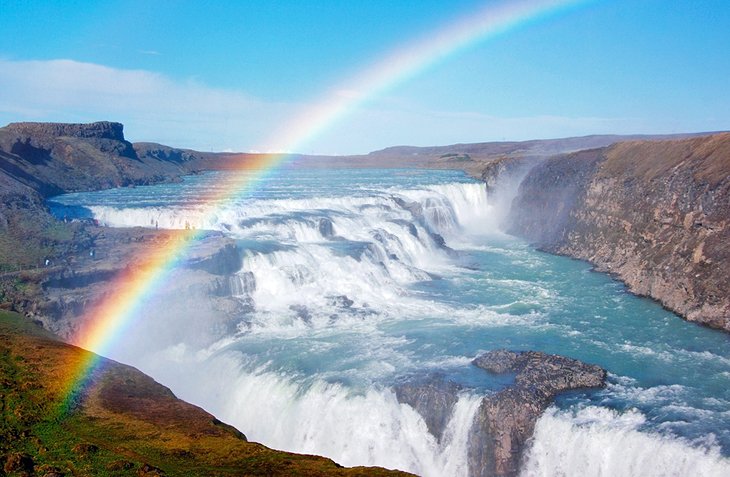
Magnificent Gullfoss Waterfall lies around 90 minutes west of Reykjavik and is one of the best waterfalls in Iceland . The river Hvítá plummets into a canyon, which forms three-step terraces, creating a powerful torrent. Gullfoss encompasses two cascades; the upper one drops 11 meters, while the lower one cascades about 21 meters.
Torrents of water flow over Gullfoss at an average rate of 109 cubic meters per second, although heavy floods have recorded an astonishing rate of nearly twenty times that. A word of warning: there are no rails or barriers, just a spine-tingling spectacle to enjoy amid surroundings as nature intended.
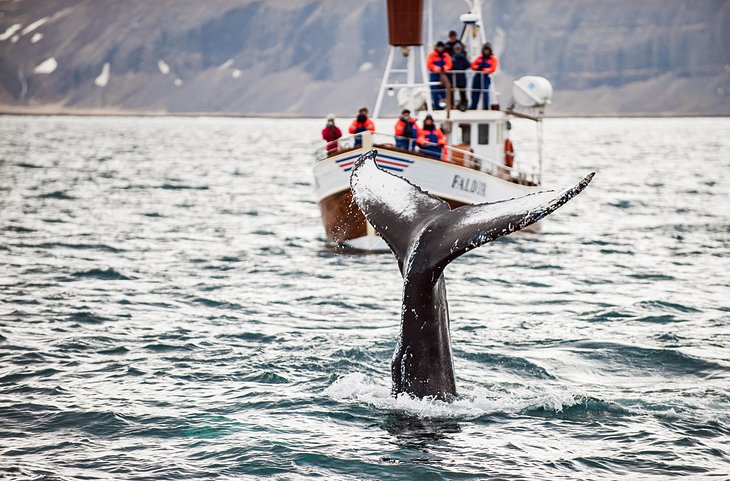
No matter what time of year you plan to travel to Iceland, whale watching happens year-round, although summer is the most popular time to see these gentle giants. During the warmer months, trips run day and night, including whale watching in the midnight sun.
Tour operators say there's an 80-95 percent chance of seeing these magnificent creatures, depending on the time of year. Best of all, surfacing often happens right near the boats, so you may well enjoy a ringside seat for one of nature's most awe-inspiring spectacles.
Other ocean-going tours are also available, such as bird-watching and island visits. Tours are convenient since there are several types available, and they depart from Reykjavik's Old Harbor. Stop for a dinner of fresh cod after you return in one of the many small, rustic restaurants located in the harbor area.
Address: Ægisgardur 5, Reykjavik's Old Harbor
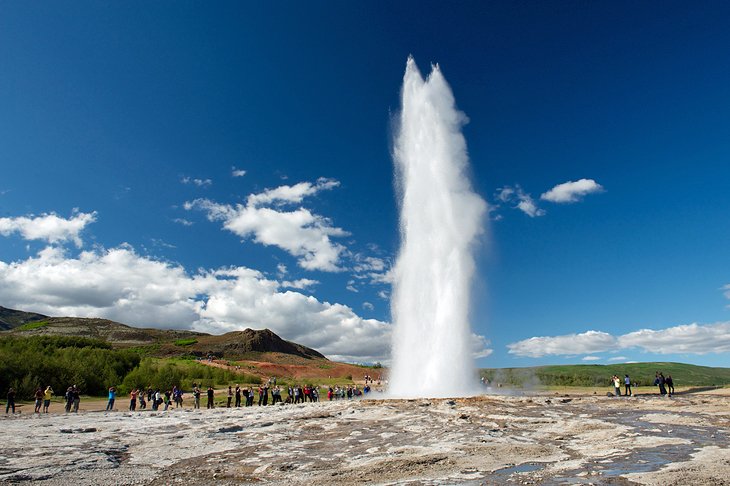
An easy 50-minute drive from Reykjavik , Strokkur Geysir (after which all geysers are named) is the most popular fountain geyser in the country and is famed throughout the world. This highly active hot spring area lies in the southwest of Iceland beside the Hvítá River and is a favorite stop along what's known as the Golden Circle.
Boiling mud pits and around 100 other smaller exploding geysers are waiting to be explored here. Every few minutes, Strokkur shoots water 30 meters into the air. Visit the Geysir Center for exhibits and informative presentations year-round.
A memorable experience is digging up Geysir or "hot spring" bread, rye bread that has been baking underground for 24 hours. Visitors can also help a chef boil eggs in a hot spring to accompany the bread. One popular day tour to the area is the Golden Circle Classic Day Trip from Reykjavik, which has several stops and can ensure you get the iconic geyser photo from your trip.
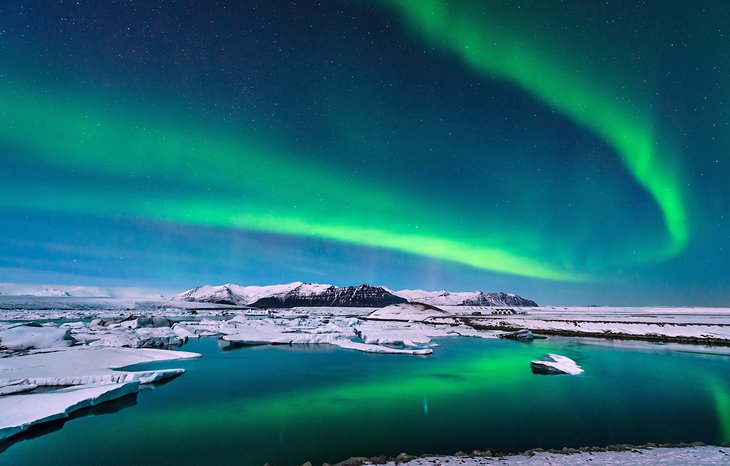
The northern lights, or Aurora Borealis, are among the most popular tourist attractions in Iceland. This is one of the best places in the world to see the northern lights .
Auroras are linked to solar wind, a flow of ions radiating from the sun. These particles become ensnared in the earth's magnetic field and collide with atmospheric molecules, causing bursts of energy, which appear as large circles around the poles. This spectacular natural light show is best admired in remote places and is particularly impressive at times of increased solar activity. Since the appearance of the northern lights is unpredictable, most hotels and lodging operators can provide you with nightly predictions before you go to bed and add you to an overnight call list.
They will call your room if the lights appear, as they may only be visible for a short window of time. For one of the most optimal opportunities to experience the northern lights, you can take a tour like the Northern Lights Night Tour from Reykjavik, which takes you to the remote countryside for the best chance to see this natural wonder.
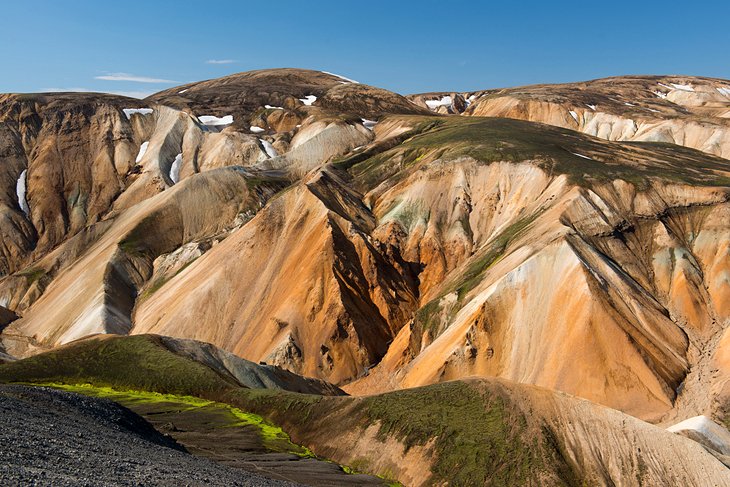
In the south of Iceland, 180 kilometers from Reykjavik, is Landmannalaugar National Park, one of Iceland's most popular tourist destinations. The main features of this mystical landscape are the multi-hued rhyolite mountains, Hekla volcano , and extensive lava fields.
Hiking and horse riding are popular things to do here, and hikes range from a couple of hours to several days. You can visit from June to late September, after which the road is closed. A mountain lodge ( Landmannalaugar Hut ) with basic facilities accommodates 75 people. Expect raw nature, rugged scenery, and utterly spectacular views.
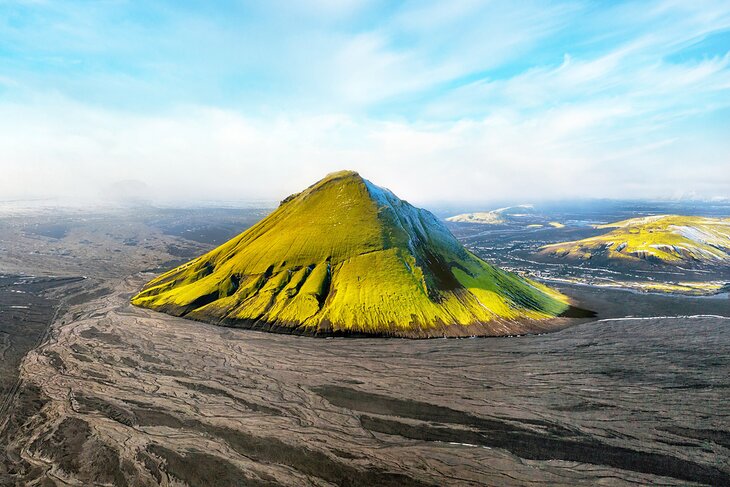
South of Landmannalaugar lies Myrdalsjökull Glacier Park, which for safety reasons can only be visited during summer. Large amounts of rain soak the area, particularly in winter, when roads can be severely damaged. Maelifell volcano is the undisputed jewel-in-the-crown of this wild, rugged glacial landscape.
The perfect cone shape gives Maelifell the look of a classic volcano, however during the warm season, a lavish green covering of moss gives it a surreal, otherworldly appearance. The park is full of volcanoes, hot springs , and other remarkable sites. To the west of Myrdalsjökull is a smaller glacier, Eyjafjallajökull (Island Mountain Glacier). A popular and thrilling way to explore is by snowmobile.
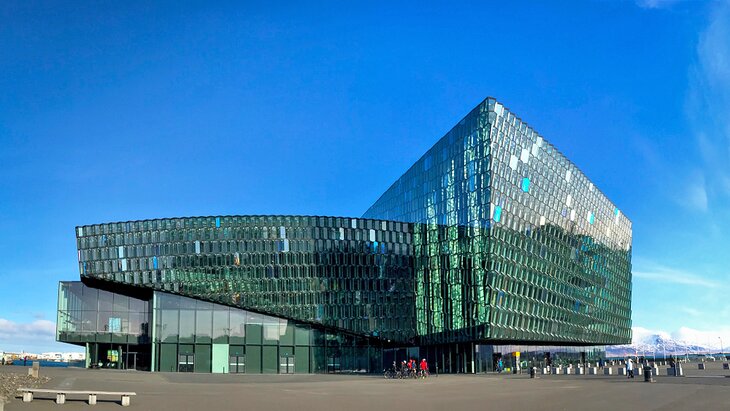
As you plan your time in Iceland, set aside an evening for a concert at the magnificent Harpa , Reykjavik's premier concert hall. If time or performance schedules do not fit your schedule, plan to at least stop by to admire the award-winning architecture of the building. Nighttime is one of the best times to see the array of colorful lights emanating from this honeycomb-shaped structure.
Harpa is a treasured landmark in Iceland, attracting international performances ranging from violinists and classical music to performing arts.
This venue makes for a great night out in the heart of the city. Enjoy dinner at one of Harpa's two restaurants and go for a stroll outside along the waterfront after the performance. The gift shop is a great place to pick up unique souvenirs, many made by local artists.
Address: Austurbakki 2, 101 Reykjavik
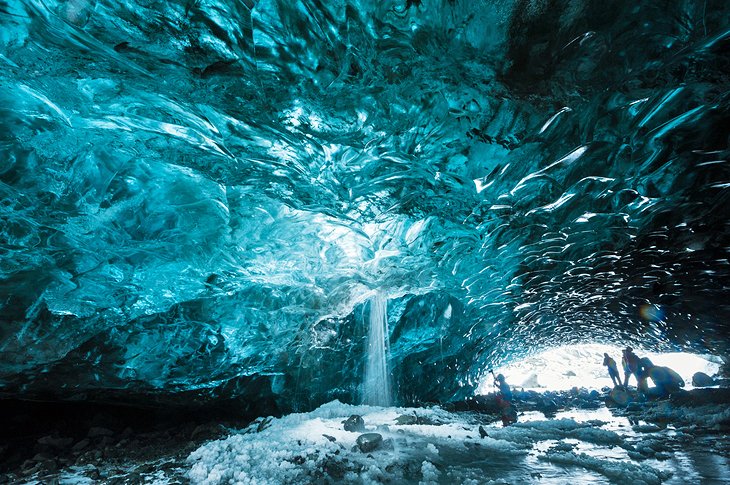
In the south of the country, Vatnajökull National Park is a land of glaciers and magnificent ice caves that attracts adventurers from across the globe. This vast national park (one of three in Iceland) is divided into four sections and consists of Vatnajökull glacier and its surroundings.
You'll find a number of visitor centers; those in Skaftafell Ice Cave and Höfn are open year-round, while Skriðuklaustur and Jökulsárgljúfur are closed in winter. The best time to visit Skaftafell Ice Cave is during winter after heavy rain has washed the top layer of the glacier away.
If seen at the right time, the cave is bathed in spectacular blue light. Group visits to all areas can be arranged off-season. If you are in good shape, you might consider doing a glacial trek with an experienced guide. The treks get you on the ice for an unforgettable experience to see glacial cracks and caves and even drink fresh water from small pools on the surface.
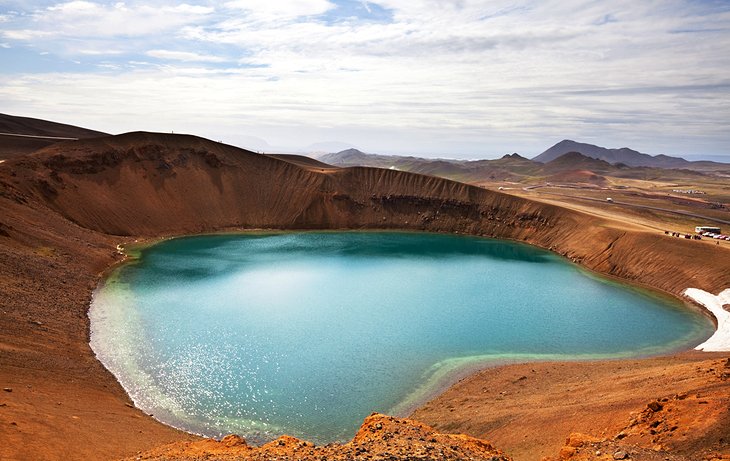
In the northern region of Vatnajökull National Park, the Askja caldera and the geothermal pool in the Dyngjufjöll Mountains are not for the faint-hearted. However, if you'd like to say you've taken a dip in a live volcano, then this is for you.
Askja is an impressive 50 square kilometers in size. The surrounding mountain range was formed during volcanic activity, and Askja was partly created by an eruption of burning ash that collapsed the roof of the central volcano's magma chamber.
The water in Viti , the geothermal pool and volcanic crater, is generally around 30 degrees Celsius. A word of warning, the banks can be very slippery, particularly in wet weather.
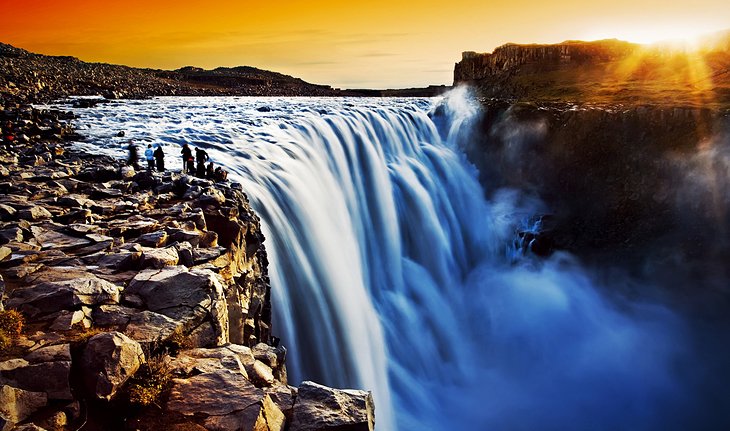
Dettifoss, in the north of Vatnajökull National Park, truly is a breathtaking example of the raw power of nature. Plunging 45 meters and with a width of 100 meters, it's said to be the most powerful waterfall in Europe.
Generally, it's best to approach on the east side of the River Jökulsa, where the road is better. Along easy paths from Dettifoss, Selfoss is a smaller waterfall around one kilometer upstream with a drop of around 10 meters. Below Dettifoss, the Hafragilsfoss waterfall tumbles 27 meters into a steep canyon. It's more advisable to drive than walk to Hafragilsfoss.
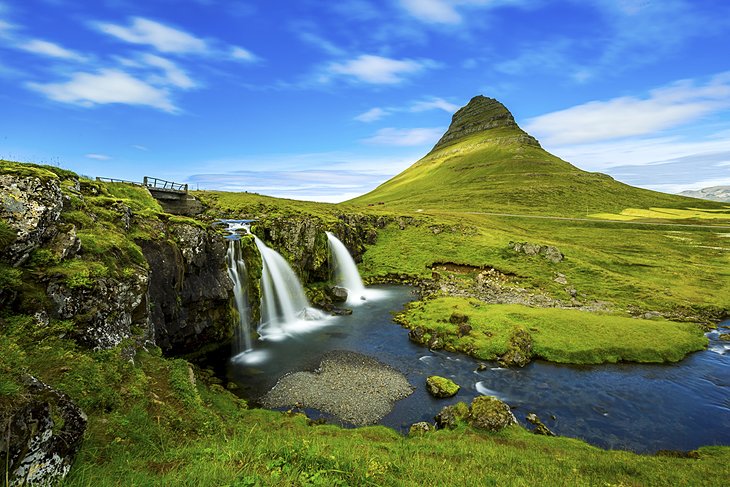
Around 2.5 hours' drive northwest of Reykjavik is the small town of Grundarfjördur, a charming fishing village centrally located on the north coast of the Snaefellsnes peninsula. The town lies in a picturesque fjord, surrounded by mountains, with Mt. Kirkjufell looming as a striking landmark.
Dotted about the surroundings, you'll discover small streams and waterfalls. During winter, Kirkjufell is a great place to watch the awe-inspiring northern lights . Eyrbyggja Heritage Centre holds exhibitions on Grundarfjördur's seafaring history and is the information center for the whole peninsula.
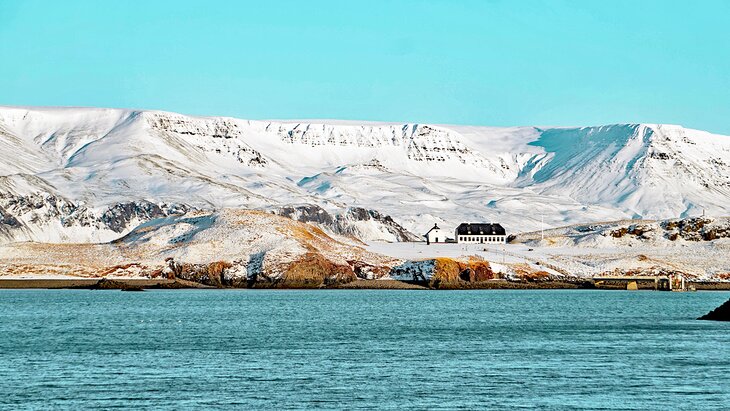
A 30-minute easterly drive from Reykjavik brings you to Mount Esja in Kjalarnes. The mountain is 914 meters high and very popular with hikers. Even for the inexperienced climber, it's a relatively easy hike. There are terrific views of Reykjavik and the surrounding landscape and ocean.
You can take several routes to the summit depending on your energy levels and how much time you have. You can get to the main starting point at Mount Esja by a 10-minute bus ride on public transportation that leaves out of the Hlemmur main station towards Artun. Check bus schedules and times before your visit.
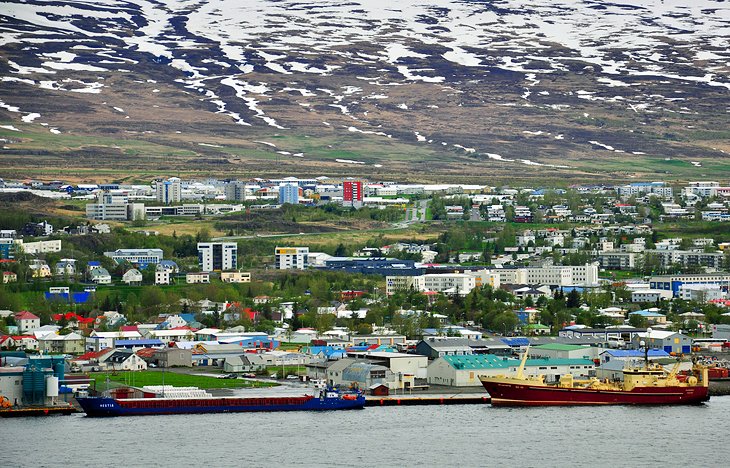
In the north of the country, Akureyri lies amid mountains on the longest fjord in Iceland about 40 kilometers south of the Arctic Circle. With a population of around 18,000, Akureyri's landscape and culture make it one of the best cities in Iceland . Summer days occasionally reach 25 degrees Celsius, and although winters bring heavy snowfall and cold weather, calm and still weather generally prevails.
Despite the town's isolation, cultural life and entertainment flourish here, and a wide range of shops offer brand-name products. The skiing area is the best in the country. Points of interest include the Akureyri Museum and the impressive Aviation Museum at Akureyri Airport .
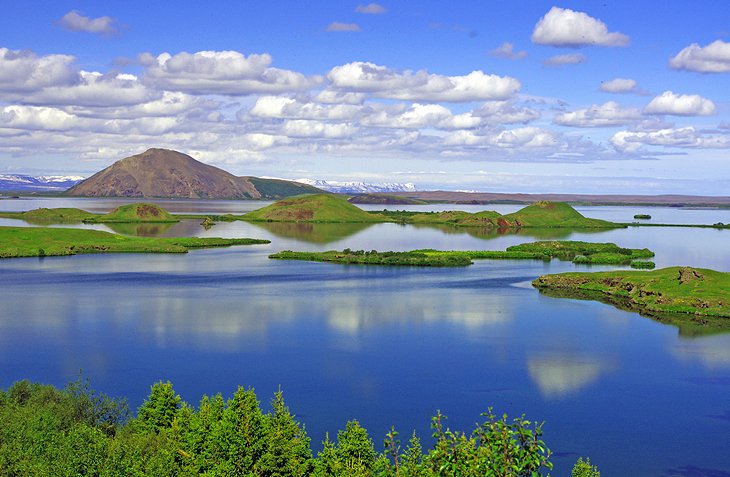
A little over an hour's easterly drive from Akureyri is Myvatn in northern Iceland. It is a lake district famous for its wealth of birdlife, rich fauna, and large shallow body of water. It's estimated that the area was formed around 2,500 years ago by a gigantic lava eruption.
Today, the surroundings are volcanically active, with an eruption occurring as recently as the mid-1980s. Bubbling clay pits, sulphuric fumes, and lava formations all form part of this unique landscape, which is still in flux.
One of the most interesting scenic features of Myvatn is the rootless vents formed by the volcanic eruption. While the landforms resemble craters, they did not have a lava flow, but the volcanic activity still resulted in their creation, adding to a stunning and unique appearance around the lake.
The name Myvatn literally means "midge-water," a reference to the prolific midges here, especially during summer, so be sure to pack some insect repellent. The area is also a bird-watcher's paradise.
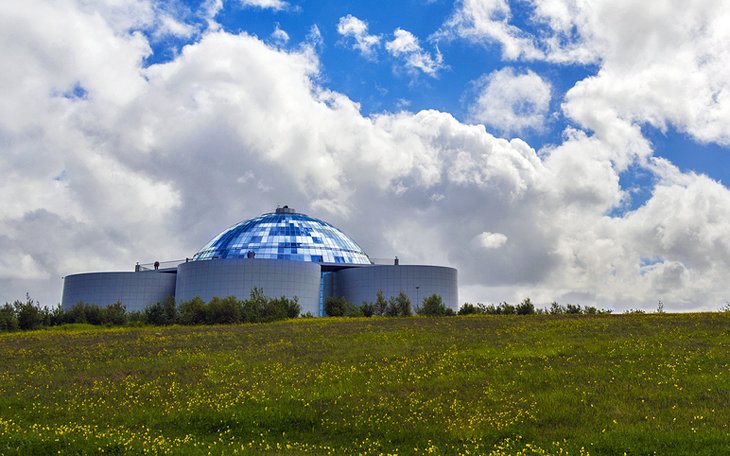
Originally the site of the city's gigantic thermal water tanks, " Perlan ," as it's known locally, is one of Reykjavik's landmark buildings. It occupies an enviable location on Öskjuhlíð hill, where there are in excess of 176,000 trees.
The hill is particularly pleasant, with bicycle trails and footpaths zigzagging up and down. The observatory affords stunning views over the city. Also on-site is a revolving restaurant , as well as gourmet and souvenir shops.
In addition, Perlan regularly hosts concerts and exhibitions in the Winter Garden. The observation deck is a real treat. The new planetarium is spectacular with a virtual trip of Iceland featuring the country's natural elements.
Address: Varmahlíð 1, 105 Reykjavík
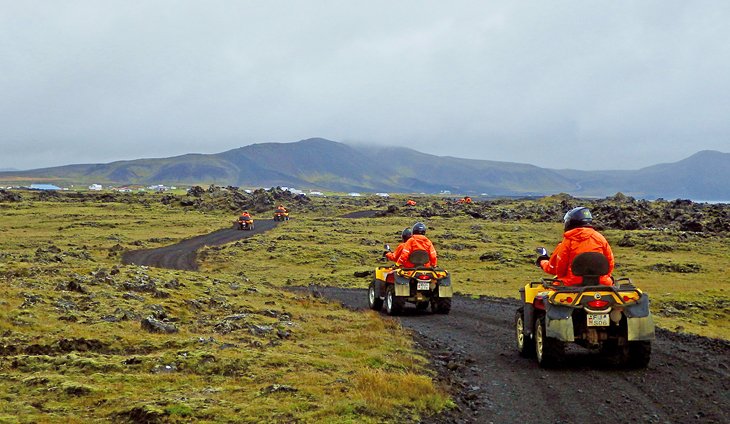
A popular thing to do and one of the most adventurous ways to experience Iceland is on the back of an ATV, trekking across rugged lava fields, riding up dormant volcanos, and passing pastures with roaming wild Icelandic ponies.
These are views of Iceland that you will never forget and one of the best ways to get up close to the country's most scenic natural environment. Tours like the two-Hour ATV Quad Tour from Reykjavik lets you experience ATV off-road adventure without a huge time commitment. Many tours depart from Reykjavik but they are available in most regions of the country.
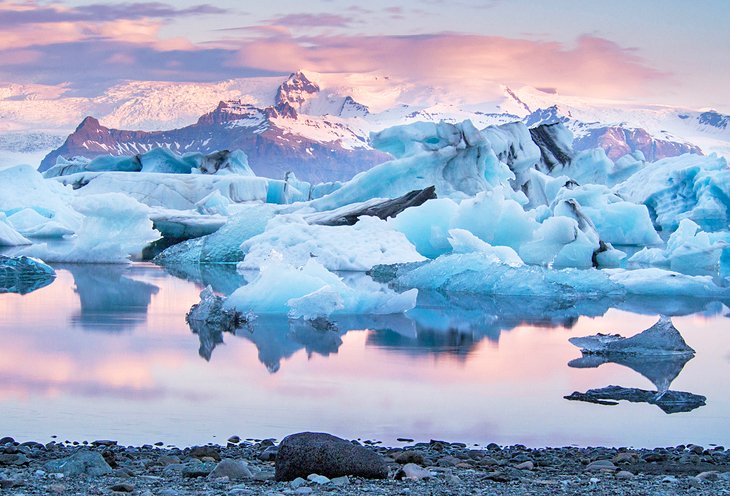
While Iceland is full of natural wonders, one of the most spectacular is the Jökulsárlón Glacier Lagoon. You will ride in a boat through large chunks of ice that have separated from the glacier.
The floating ice in the lagoon ranges from the size of small pebbles to the size of cars, but since you are floating in the lagoon with them, they are close enough to touch. Witness the blue hue of glacial cave formations and birds flying above in this natural environment.
The South Coast and Jökulsárlón Glacier Lagoon Day Tour from Reykjavik is a popular tour for visitors who want to set up a home base for their visit to Reykjavik and do a day trip to this top attraction. The tour also includes visits to two beautiful waterfalls and spectacular views of mountains and glacial rivers along the south coast.
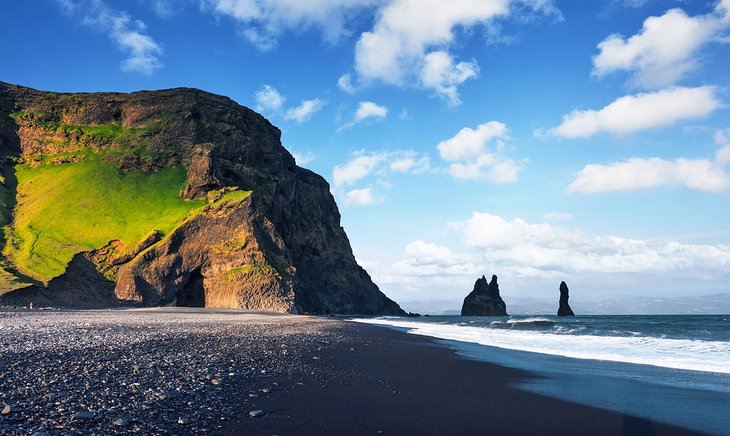
While Iceland has some stunning beaches, the Reynisfjara black-sand beach on the country's southern coast has an other-worldly appearance. This unique beach is known for its black sand and rocky sea stacks that protrude from the oftentimes ferocious waves coming in from the Atlantic Ocean.
The eerie yet stunning landscape of natural beauty at Reynisfjara beach is one of the reasons it was selected as a filming location for films like Star Wars. The lighting at this beach adds to its contrasting allure, which is why it is a must-visit for anyone who enjoys photography.
As with many natural locations in Iceland, Reynisfjara black-sand beach has dark folklore associated with it. Iceland legend says that the rocky basalt sea stacks were once trolls pulling seafaring ships to shore in the night, and they turned to stone during sunrise.
You are not likely to see any trolls during your visit, but you might see some of the thousands of seabirds, like puffins, guillemots, and fulmars, that nest in the columns.
The 2.5-hour drive to the beach is easy from Reykjavik, or you can take a guided trip along the southern coast that includes this as a stop if you want to spend more time at some of the other features on that side of the island.
Read More: Best Black Sand Beaches in the World
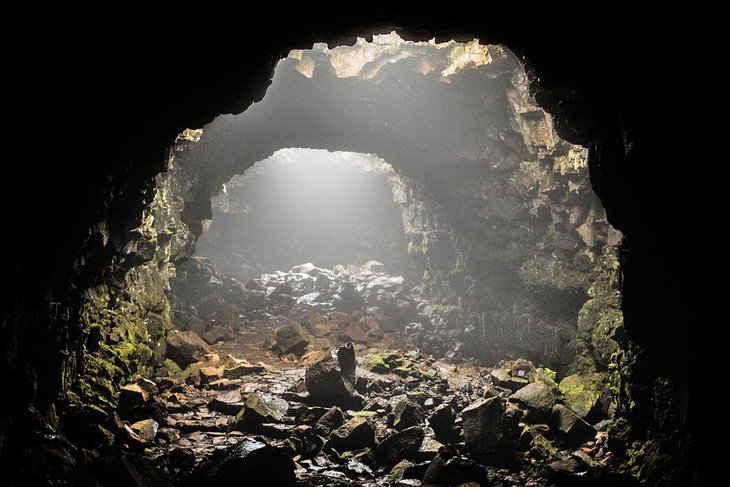
The land of fire and ice has so many intriguing natural elements that visiting is an exciting science lesson into how volcanos work. One way to find out is by visiting the Raufarhólshellir lava tunnel in southwest Iceland.
At 4,461 feet, it is one of the longest lava tubes in the country. You can take a guided tour through the cave to get up close to the stunning lava rock formations and colorful walls that have formed below the earth.
A tour through the tunnel will walk you through the path where lava flowed during a volcanic eruption of the Bláfjöll Mountain Range more than 5,000 years ago. These tunnels were formed as flowing magma hardened and thickened, creating a crust roof resulting in a lava tube.
Outside the lava tube, you will see stunning green moss covering lava rock and craters formed from the eruption. It is only about a half hour from Reykjavik, and you can visit year-round. If you visit in the winter, plan on wearing extra layers and sturdy boots for icy and wet conditions.
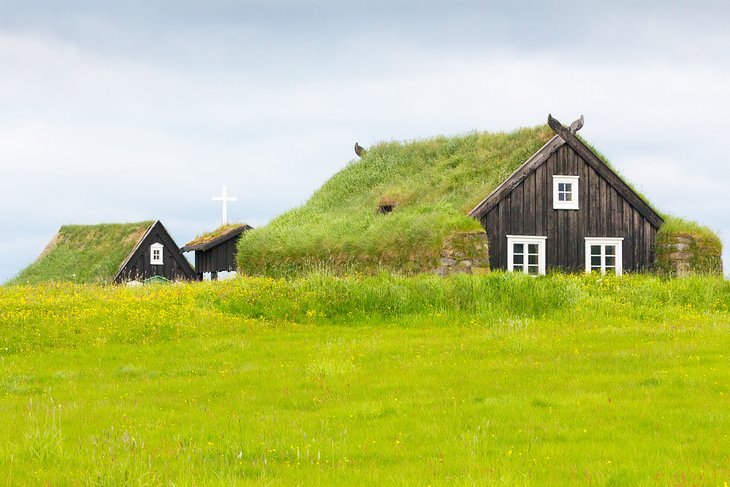
Iceland has an intriguing history of Vikings that settled on the island and folklore involving trolls and other creatures that still influence the culture today. One of the most interesting ways to learn about the varied tentacles of Icelandic culture is by visiting some of its museums. Some of them are seemingly mainstream, while others, sometimes found off the beaten path, explore some rather unusual finds.
In Reykjavik, the National Museum of Iceland is a good place to visit to explore Icelandic history and settlement. The Saga Museum also gives insight into the Viking heritage, with life-sized replicas of early settlers, offering a nice history lesson before you venture into some of the other types of museums.
Start your quirky museum visit with The Punk Museum on the back street of Reykjavik, which delves into Iceland's punk music scene that emerged in the 1970s. The Árbær Open Air Museum (within the Reykjavik City Museum) is another experience worth trying as you see more than 20 buildings that form a small early settlement village.
Not far from Reykjavik in Njarðvík is the Viking World Museum , which has an exact replica of a Viking ship that was discovered in Norway in the late 1800s and exhibitions detailing the Norse settlement.
One of the more unique museums in Iceland is the Sigurgeir's Bird Museum at Mývatn . The tiny museum features a collection of more than 300 preserved bird specimens representing over 180 species and an extensive collection of eggs.
The Library of Water in Stykkishólmur will give you insight into Iceland's natural environment, with dozens of columns holding water from ice caps. The Nonsense Museum in the Westfjords is a quirky stop to enjoy a large collection of random items, from sugar cubes to police hats that came from forces around the world.
For those who are interested in a deep dive into the history of Iceland's folklore, you should visit The Museum of Icelandic Witchcraft and Sorcery in the Westfjords in Hólmavík village. This museum gives insight into some of the tales and history on which Icelandic beliefs are based. This can be a tough visit for some, and parents should give it a preview before taking their children inside.
When it comes to Iceland, the scenery is naturally stunning year-round, but certain times of the year are better than others to catch some of its most sought-after attributes.
For most visitors, the best time to visit Iceland is in the summer . But, the best time can also depend on what you want to experience. Do you want to catch a glimpse of the northern lights, visit when there is the most hours of daylight, or navigate the Ring Road with no snow? Or, do you want to travel during the low season to get the best rates on hotels and airfare? All of these factors matter when determining the best time to go to Iceland for your specific travel priorities.
Each season in Iceland comes with unique opportunities for exploration and the natural experiences that the island is famous for, like the midnight sun, aurora borealis, and hot springs.
Summer : Summer is hands down one of the best times to go to Iceland. It is the season with the best weather conditions, comfortable temperatures, the best opportunities for sightseeing, and when the roads and hiking trails are open and dry.
You get a front-row seat to the midnight sun. From May through August there is complete sunlight at midnight . While 24 hours of daylight makes it tough to sleep during your trip, it gives you more time to experience all that there is to see and do in Iceland. Summer is a great time to see minke whales out of Reykjavik.
Fall: The fall season is a lovely time to visit Iceland, when temperatures are slightly cooler, the summer tourists are gone, and the weather conditions are still favorable to do things like trekking on a glacier and riding an ATV over lava fields.
Fall colors on the trees are pretty, especially if you are horseback riding or hiking on one of the mountain trails. As fall dips into November, your chances of seeing the northern lights increase, and roads may start to close due to weather conditions. It is also a nice time to visit the Blue Lagoon when there are not so many tourists.
Winter: Winter days in Iceland can have almost 19 hours of darkness. It has the most inclement weather, but the top reason for visiting in the winter months is the chance to see the elusive northern lights. Prices will be cheaper for accommodations, and you will have plenty of availability on tours since it is the off-season.
Winter is a great time to take advantage of the snowfall in Iceland, with excursions like exploring ice caves and snowmobiling. It can be a fun time to visit the Blue Lagoon and the local hot springs where you can warm up – that is, until you get out.
Spring: Early spring in Iceland may still have snow-covered roads, but the days are starting to get longer. You also still have a chance to catch the northern lights during your visit. This shoulder season may limit some winter activities as they come to an end, and some summer excursions may not be available yet.
Spring is a great time to go whale watching, with many kinds of tours available out of Reykjavik. Spring is when you can catch a glimpse of another of Iceland's famous animal residents, the puffin, the unusual-looking bird that is more active in the spring.

More on Iceland
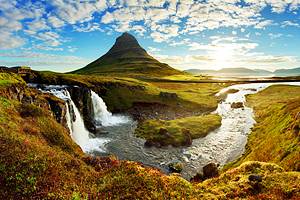
- Attractions & Activities
- Museums & Exhibitions
- Something for everyone
- Restaurants
- Accommodation
- Getting around Reykjavík
- Traveling to Reykjavik
- Trip ideas & Itineraries
- Convenient traveling
- Practical Information
- Hafnarfjörður
- Mosfellsbær
- Seltjarnarnes
- Reykjavik History
- About Visit Reykjavík
- Media center
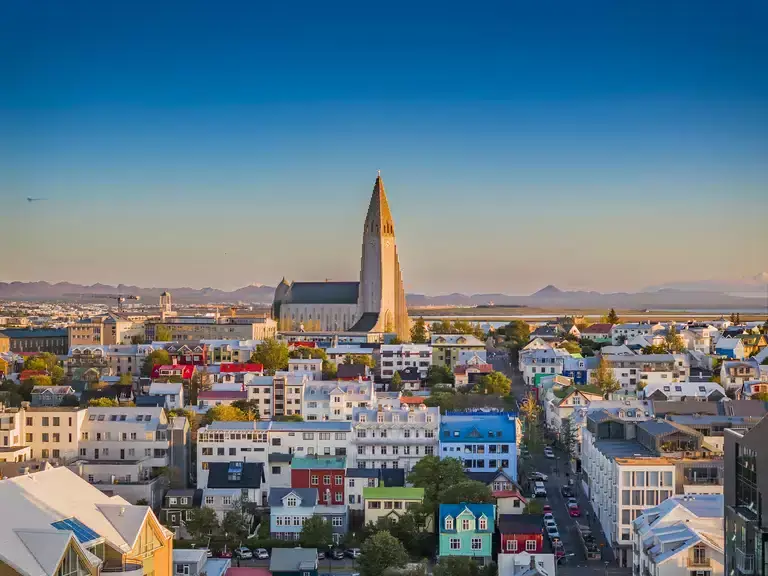
This is re ykjavík
Adventure in re ykjavík, art in re ykjavík, re ykjavík festival city, see & do.
- Accommodations
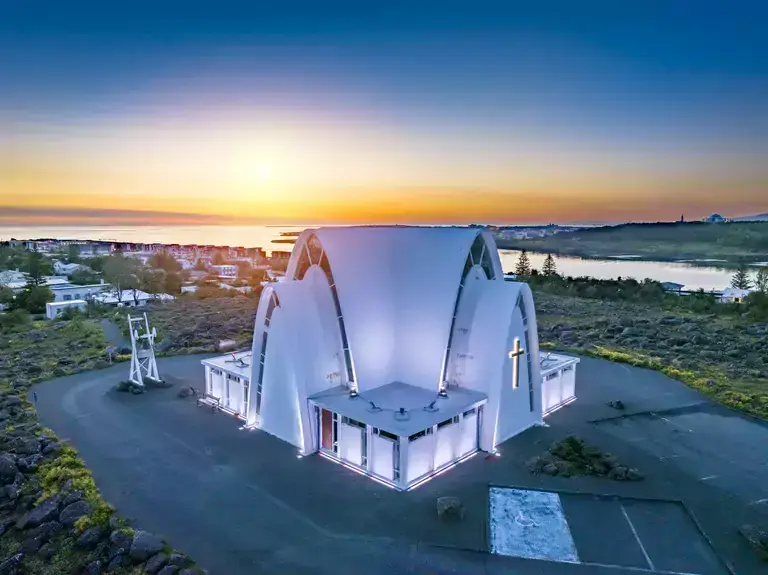
Discover hidden treasures in Reykjavík City Areas
Experience Reykjavík
Plan your trip – go with feeling, popular sights & landmarks, stories from reykjavík, #visitreykjavik.

The Ultimate 5-Day Iceland Itinerary: Must-See Sights and Hidden Gems
By: Author Amanda OBrien
Posted on Last updated: 01/09/2024
Many people dream of seeing the natural wonders that are dispersed around the nordic nation, Iceland. From bursts of green, orange and red twinkling in the sky, volcanic marvels and green fjords, Iceland captures the imaginations of adventurers from all scenes of the world.
Did you know that it would only take you 12-13 hours to drive around the entire country of Iceland? This essentially means travellers can see all parts of the country in a short number of days – as you will see in this 5 day itinerary Iceland.
This Iceland vacation itinerary will lead you around the awe-inspiring coastal cliffs and mythical mountains to discover the most iconic and cherished parts of Iceland.
Let’s explore what a 5-day itinerary for Iceland entails, and the wonders that you’ll unearth along the way. And be sure to check out my post on everything you need to know before visiting Iceland , to be well prepared.

5 Day Itinerary Iceland: How to Get to there and How to Get Around
If you are flying into Iceland from abroad, you’ll arrive at the Keflavík International Airport (KEF), located 50-minutes from Reykjavik. The capital city also has an airport, but it only services domestic flights or flights to Greenland.
⇒ Flights to Reykjavik
Keflavik Airport is also only about half an hour from the Blue Lagoon . This is why most visitors tend to visit the Blue Lagoon on the first or last day of their trips. In this 5 day itinerary Iceland, I have suggested visiting the Blue Lagoon on the last day of your vacation.
⇒ Don’t miss reading My Guide to the Blue Lagoon and is the Premium Package Worth it?

Getting from Keflavik Airport to Reykjavik
The airport shuttle service provides fly buses that will take you to Reykjavik. You can choose your hotel as a drop-off point or the central bus terminal (BSI terminal) in the city centre.
There are 2 companies that run airport buses . You can buy tickets for the Flybus onboard Icelandair flights. Grayline is the other company.
⇒ Save Money & Time – Book Your Transfer from Keflavik Airport to Reykjavik

Getting around Iceland
Without question, the best way to see Iceland is to Hire a Car. Not only will it save you a fortune it is the best way to see most of the sites in 3 days in Iceland. Most of the key sites are free eg the Golden Circle so if you have a car costs drop dramatically – especially if you are with a group. And do make sure to check the weather in Iceland for a road trip for the time of year that you will be visiting.
And if you are going to hire a car for your Iceland trip then the best option is to pick it up at Keflavik airport. This will save you the transfer cost between the airport and Reykjavik. This is one of my top travel tips for Iceland .

5 Day Iceland Travel Itinerary: Day 1: The Golden Circle Tour
The Golden Circle tour is Iceland’s most popular day trip. This is generally a full day tour which departs from Reykjavik around 8am and returns at 5pm. If your flight is arriving a bit later you can opt for an afternoon tour around the Golden Circle.
The core of the Golden Circle tour is the following 3 activities

Pingvellir National Park
Pronounced Thingvellir in English, the park is a UNESCO world heritage site and holds historical significance – it’s the location where Iceland’s first parliament was held.
Thingvellir National Park is located 40-minutes from Reykjavik and has several attractions. It’s geologically unique, where you can see a continental divide between the North American and Eurasian tectonic plates.

In the southern part of the park lies the largest natural lake in Iceland, the Thingvallavtn (Pingvallavatn). You can dive or go snorkelling here, or simply enjoy the scenery.
Geysir Thermal Area
After exploring the park, it’ll be a 40-minute drive to the Geysir thermal area. “Geysir” is a geyser in the geothermal area along the Golden Circle. Get your cameras ready to snap pictures of bubbling mud pots, springs shooting up boiling water and steaming air from the earth.

Along the way, before you arrive at the Geysir, you’ll pass by a lovely farm restaurant, the Efstidalur II, that provides some delicious foods.
Gullfoss Waterfalls
Just a quick 10-minute drive from Geysir is one of Iceland’s most iconic falls found in the Hvítá glacial river. It’s a wide, two-tiered waterfall that cascades down a 32-meter drop. For me this was the most stunning waterfall in Iceland.

There are several viewpoints where you can take pictures from. Be mindful that you should wear waterproof clothing and shoes when exploring these spectacular natural wonders.

Boutique Hotels in Reykjavik
Reykjavik has a fantastic boutique hotel scene with some great high end design options as well as some interesting concept hotels.
The classic Reykjavik boutique hotel is Hotel Borg . This was essentially Iceland’s first boutique hotel and is still modern in style and delivering on luxury. It also has a fantastic location on Austurvöllur Square, home to Reykjavik’s unique cathedral.
⇒ Read more Reviews on TripAdvisor ⇒ Book Now

101 Reykjavik is a member of the Design Hotels group and is all about sleek and minimalist black and white design. It features the work of local artists and a very stylish bar.

Normally I would never recommend staying at a hostel. However, Reykjavik has two unique hostel concepts and staying at these may give you more cash to enjoy Icelandic lobster.
Kex is the Icelandic word for biscuit. This really has nothing to do with anything but this is the perfect place to stay for solo travelers who like a bit of luxury. They have a fantastic bar and restaurant with live music and wine prices that are dirt cheap for Reykjavik.
They offer singles and doubles (as well as dorms – shudder) which are simple in design but still clean and stylish as this is Iceland.

The second hostel option is the Galaxy Luxury Pod Hotel . This is luxurious budget accommodation (I think that is an oxymoron but will continue). The only option here is a dorm room but instead of a bunk bed you will have your own enclosed pod. And there is a virtual reality gaming room.

If you’re looking to keep all of your cash for full on day trips and Icelandic lamb Air bnb have loads of properties in Reykjavik so this could be a great way to experience real Iceland.
Iceland Trip Itinerary Day 2: Bláfjöll Country Park and Reykjavik South Coast
Upon arriving in Bláfjöll Country Park, you’ll have a couple of hours to spend discovering one of Iceland’s secret natural gems, the Þríhnúkagígur volcano.
After the awe-inspiring venture, drive to the south coast of Reykjavik, where you’ll spot incredible natural attractions and awe-inspiring landscapes.

Bláfjöll Country Park
Begin your second day in Iceland by driving 20km to the east of Reykjavik, where you’ll arrive in Bláfjöll Country Park in the late morning. One of Iceland’s greatest natural phenomenons, an empty volcanic magma chamber of Þríhnúkagígur volcano, is found here.

The tour to the chambers or Inside the Volcano begins with a 3km hike, followed by a cable cart ride that descends 120m into the heart of the dormant volcano.

After the thrilling experience in the scarlet, orange volcano, drive to the small town of Hveragerði, nicknamed the earthquake town. There are supermarkets and a cafe here – the perfect place to grab some food for fueling your adventures.
Reykjavik South Coast
The scenic drive from Bláfjöll Country Park to the south coast will take you around 5 hours, depending on the weather. You’ll most likely arrive in the late evening.

Locals and international travellers are continuously blown away by the beauty that’s found along the south coast of Reykjavik.
Many travellers choose to explore the area in different ways. Embark on a group driving tour or drive around the area and find the beauty yourself. You’ll spot dried lava fields, breathtaking cliff sides and quaint fishing villages.
Check out my article on things to do on the Snaefellsnes Peninsula

If you’re travelling during winter, as the night starts to fall, take a drive to the edge of Jökulsárlón glacier lagoon . You might get lucky and see the celebrated Northern Lights.

If you’re interested in seeing the Northern Lights I highly recommend staying at Hotel Ranga in Hella. This is one of the two best Iceland Northern Lights hotel options to stay in – in my opinion.
⇒ Read Reviews of Hotel Ranga Iceland on TripAdvisor ⇒ Book Now
Iceland Travel Itinerary: Day 3: Egilsstadir & the East Fjords
On the third day of your itinerary for Iceland, you’ll be venturing out to the quintessential town of Egilsstadir. The 4-hour drive to the town will reward you an array of waterfall sightings, mountainous landscapes and jagged fjords.
Egilsstadir
The town of Egilsstadir is split by Iceland’s largest river, Lagarfljót. It’s in these waters that it’s believed the Loch Ness monster lived. Use this visit as an opportunity to discover the culture, food and folklore found in the east of Iceland.

These parts of Iceland are also the only regions where you’ll spot wild reindeer roaming around. The tree-covered grounds are also particularly rare on the island and a great place to go for a light stroll is at the Hallormsstaðaskógur National Forest .

The East Fjords
The east fjords are known globally for their wild beauty, and often the scene of Viking inspired movies and series. Charming fishing villages and glaciers surround the steep cliffs that are nestled along the coast. And they’re often complemented with thundering waterfalls and crystal clear bodies of water.
Boutique Hotels in Egilsstadir
Hotel 1001 Nott is a luxury family-owned hotel on a quiet lake about 4km from Egilsstadir. Every room has floor to ceiling windows and contemporary and modern design.

The restaurant at Hotel 1001 Nott also has floor to ceiling windows to take advantage of the beautiful vistas – and it is well known for its reindeer burgers.
Or why not stay at an Icelandic farmhouse? Hotel Eyvindara is another family-run hotel just 2 km from Egilsstadir. Many of their simple and modern rooms also have private balconies. Their restaurant serves a mix of Icelandic and international dishes.

Iceland Travel Itinerary: Day 4: Husavik & Akureyri
A leisurely drive of around 3 hours will take you from Egilsstadir to the coastal town Husavik, which is famous for whale-watching and for its role in the fantastic Eurovision Song Contest Film: The Story of Fire Saga .
Given that the main spectacle is the chance to watch whales breaching over the water, try to leave Eglisstadir as early as possible to reach Husavik, and then Akureyri.
Thousands of travellers are drawn to Husavik to catch the chance of spotting whales. On the traditional whale tour , you’ll also often encounter the harbour porpoise, the titanic blue whale and plenty of white-beaked dolphins.

Once you’ve gotten your thrill of seeing the sea life, visit the Exploration Museum and Whale Museum , to discover even more weird and wonderful facts about these sea creatures.

An hours drive from Husavik is Akureyri, the second largest town of Iceland which holds a vibrant, bustling population. And with a city this big, an exciting array of activities await you.
Consider doing something you’ve probably never done before, visit an arctic botanical garden. The garden encompasses every flower species native to Iceland, and fairy-like paths will lead you through the wonderful scenery. Entrance is free, a nice bonus.

End of the day by dining at Strikið , one of the best restaurants in the country. The classy establishment shows off views of the surrounding fjords. Those brave enough for the cold can choose to enjoy their meal of the terrain with even better views.
Spend the night in Akureyri before making your way back to Reykjavik.
Hotel Akureyri is a super cute and quirky boutique hotel with micro suites in downtown Akureyri. They have a mix of rooms that feature ocean views or sloping ceilings or private balconies.

Hotel Kea is located in the heart of Akureyri next to its famous church. Their 104 rooms have contemporary wooden floorboards and modern interior design. They also have an excellent in house restaurant Mulaberg Bistro & bar.

Reykjavik Itinerary: Day 5: Back to Reykjavik to Explore the City and/or visit the Blue Lagoon
After a good night’s rest in Akureyri, start your morning bright and early, and journey back to Reykjavik. The drive will take you approximately 5 hours. This will be your last day to experience the capital of Iceland.
Depending on the time of your flight, you may well be able to explore Reykjavik and visit the world-famous Blue Lagoon on your way to Keflavik airport.

If you are short on time I would recommend prioritizing a visit to the Blue Lagoon. Reykjavik is a very cute town with lots of atmosphere but the Blue Lagoon is a genuinely unique experience that you won’t encounter elsewhere.
City Life in Reykjavik
Start your day wandering along the streets and through the charming neighbourhood. Or venture to Reykjavik’s Old Harbor, which shows off the icy sea waters and views of Mount Esja in the background. Don’t miss the stunning Sun Voyager sculpture on the harbor.

There are plenty of museums that can be visited in the Icelandic capital. Choose between visiting the Saga Museum, the Maritime Museum or the National Museum of Iceland. A visit will most likely take you 1-2 hours, which leaves you with time to wander the lively streets.

Visit the tallest church in Iceland – the Hallgrimskirkja which has fantastic views over Reykjavik and if you’re a coffee-lover, pop into Reykjavik Roasters for a fantastic cup of coffee.

Blue Lagoon
After exploring Reykjavik, venture to the Blue Lagoon , which is one of the most popular things to do in Iceland. The man-made lagoon, which features milky blue waters, is supplied by warm waters from Svartsengi, the nearby geothermal power plant. Travellers enjoy taking dips in the water or venturing the spa and resort.

It’s recommended you book a ticket in advance to skip the queues to get into the Blue lagoon. This is a must-do during your 5 day Itinerary Iceland and a perfect way to finish your vacation.

Blue Lagoon is a 50-minute drive from the city centre. You can take Reykjanesbraut, Highway 42, through to Grindavíkurvegur, Highway 43, and then simply follow the signs to Blue Lagoon and then drive on to Keflavik airport once you’ve finished.

The Blue Lagoon is open from 8 am – 8 pm, and ticket prices will vary depending on the time.

Best Time to Visit Iceland
While it’s not a problem to visit Iceland all-year-round, different seasons provide different opportunities for travellers.

5 days in Iceland during summer is always going to be great for outdoor adventure tours and hikes through the wildlife. Summer will last from June to August, and it’s one of the most popular times for visiting the country.
However, the shorter days in the winter months will create a better opportunity to see the glorious Northern Lights. You can also spend more time visiting museums, cosying up by the fire and galavanting in the snowy forests. September to mid-April are the coldest months in Iceland.

Things to Know before you go to Iceland
⇒ If you have not hired a 4 WD car check in with your hotel on where you are going to make sure that your car will be ok. Quite a few roads are 4WD only and they show up quickly.
⇒ There is no need to buy a SIM card for Iceland. Indeed my UK provider Vodafone covered me under my normal UK plan.
⇒ Also, there is wifi virtually everywhere in Iceland and it is almost always free. This is from the hotels to the major tourist attractions.
⇒ You can save a lot of money by grabbing your lunch at a supermarket. The supermarkets in Iceland are great – loads of good quality produce.
⇒ Icelandic chocolate is also delicious. We also bought crisps, dips etc at the supermarket for pre-dinner snacks. A key item you must try whilst in Iceland is the national yoghurt Skyr .

⇒ Wine is very expensive in Iceland. However, there are several ways around this. Firstly when you arrive in Iceland and go to baggage claim there is a giant duty and tax-free store . Iceland is I believe the only place in the world to have shopping that is both tax and duty-free.
⇒ Virtually everywhere in Iceland accepts cards – even the toilets. This is much easier than dealing with cash. It is also quite easy to pay individually when you are in a group.

Get Ready to Embark on a 5 Day Trip to Iceland
The strikingly beautiful landscapes in Iceland will leave you breathless, no matter how many times you’ve explored the nordic country. Fortunately, the country is so small; it allows travellers the opportunity to discover all the magical destinations and natural wonders.
Perhaps 5 days may be too long for you. If so, be sure to check out my best Iceland Itinerary for 3 days , which includes many fantastic ventures.

Amanda O’Brien is the creator and editor of The Boutique Adventurer. She has visited 80 countries and is a member of the British Guild of Travel Writers as well as the IFTWTA. She is passionate about wine had has just completed Level 3 of the WSET. Born in Australia, she lives in London.
This site uses Akismet to reduce spam. Learn how your comment data is processed .
Like this post? Why Not Share It?
Thanks for Sharing!
About Iceland
Visa information, geography of iceland, general information, the northern lights, volcanic eruptions, sustainable travel, iceland academy, plan your trip, how to get there, accommodation, things to do, map your journey, getting around, carbon footprint, destinations, the regions, scenic routes, national parks, trip suggestions, towns & villages, inspiration, food and beverages, lbgt+ travel, explore iceland.
Read handpicked articles to get you inspired by Iceland

How to capture the Northern lights with a smartphone
Unlock the secrets to photographing the aurora with your smartphone. Discover practical tips for immortalizing nature's most mesmerizing light show.
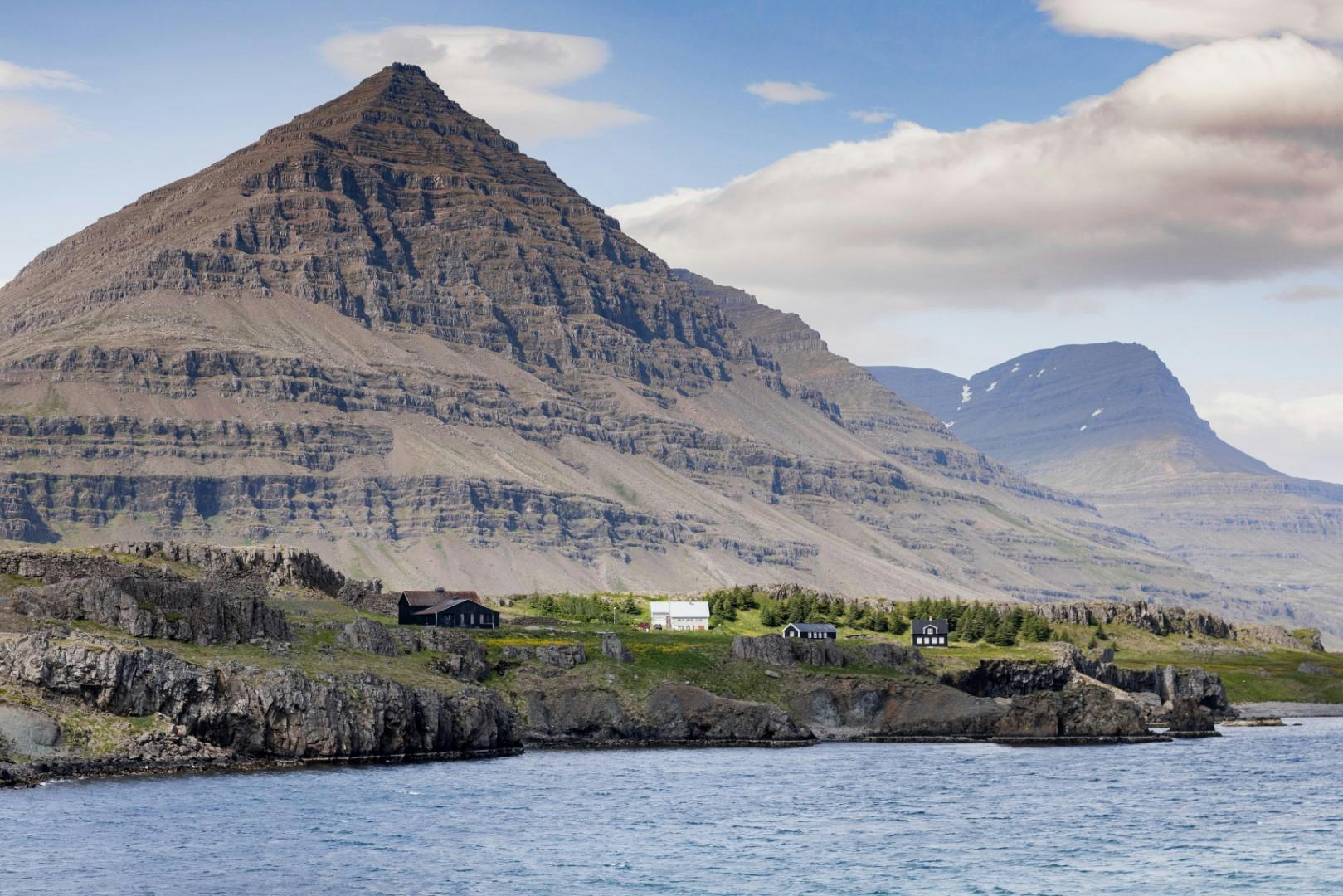
Around Iceland in 14 days
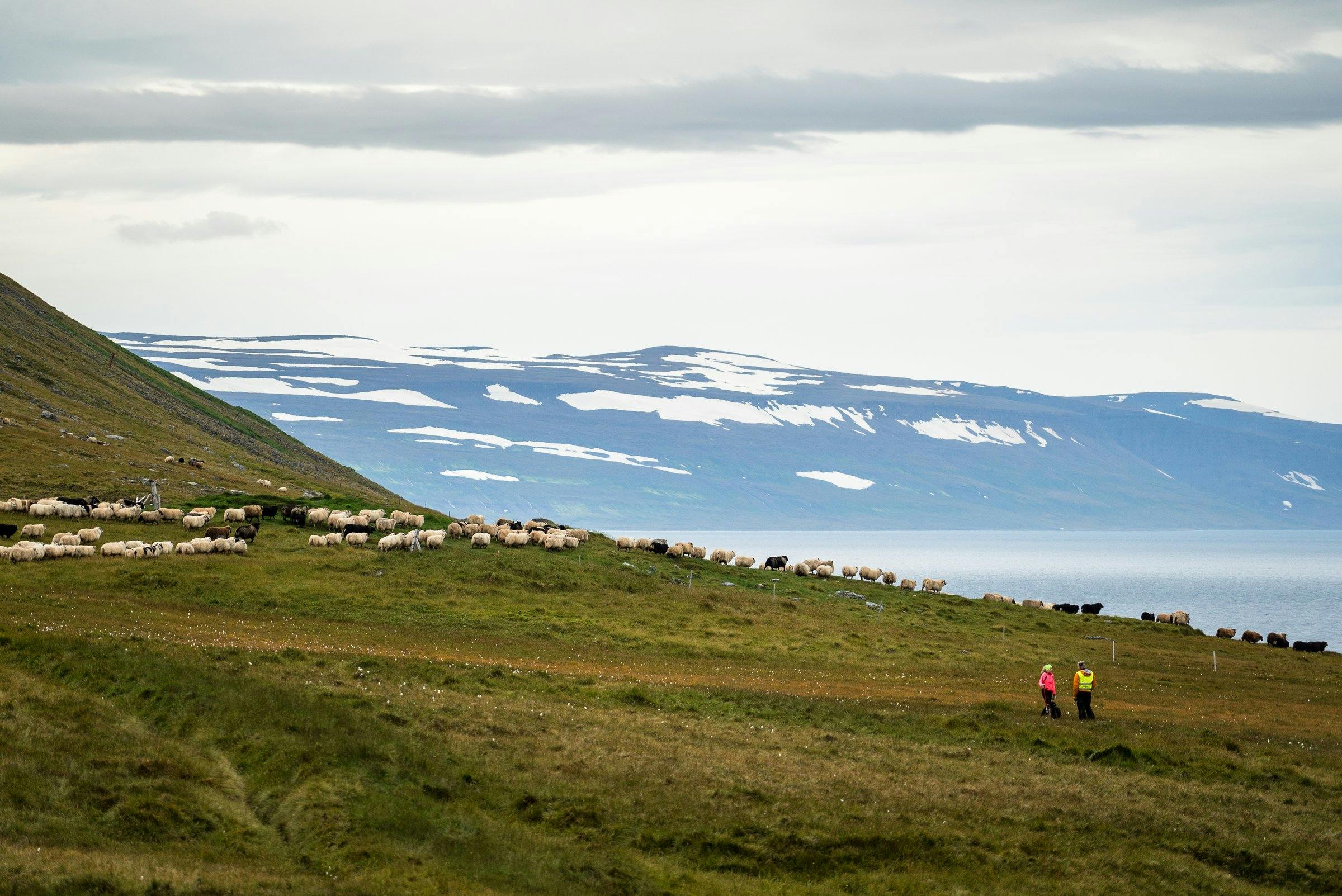
Sheep and horse roundups in Iceland
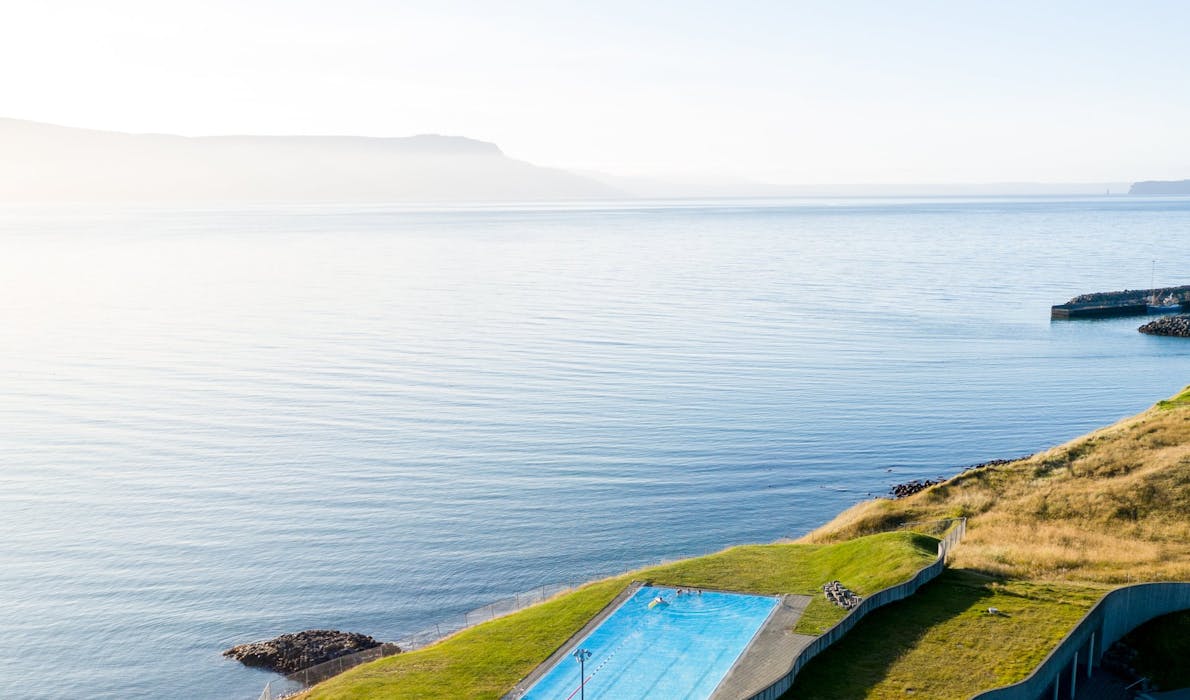
Minibreak North Iceland

Volcanic activity has resumed on Reykjanes Peninsula
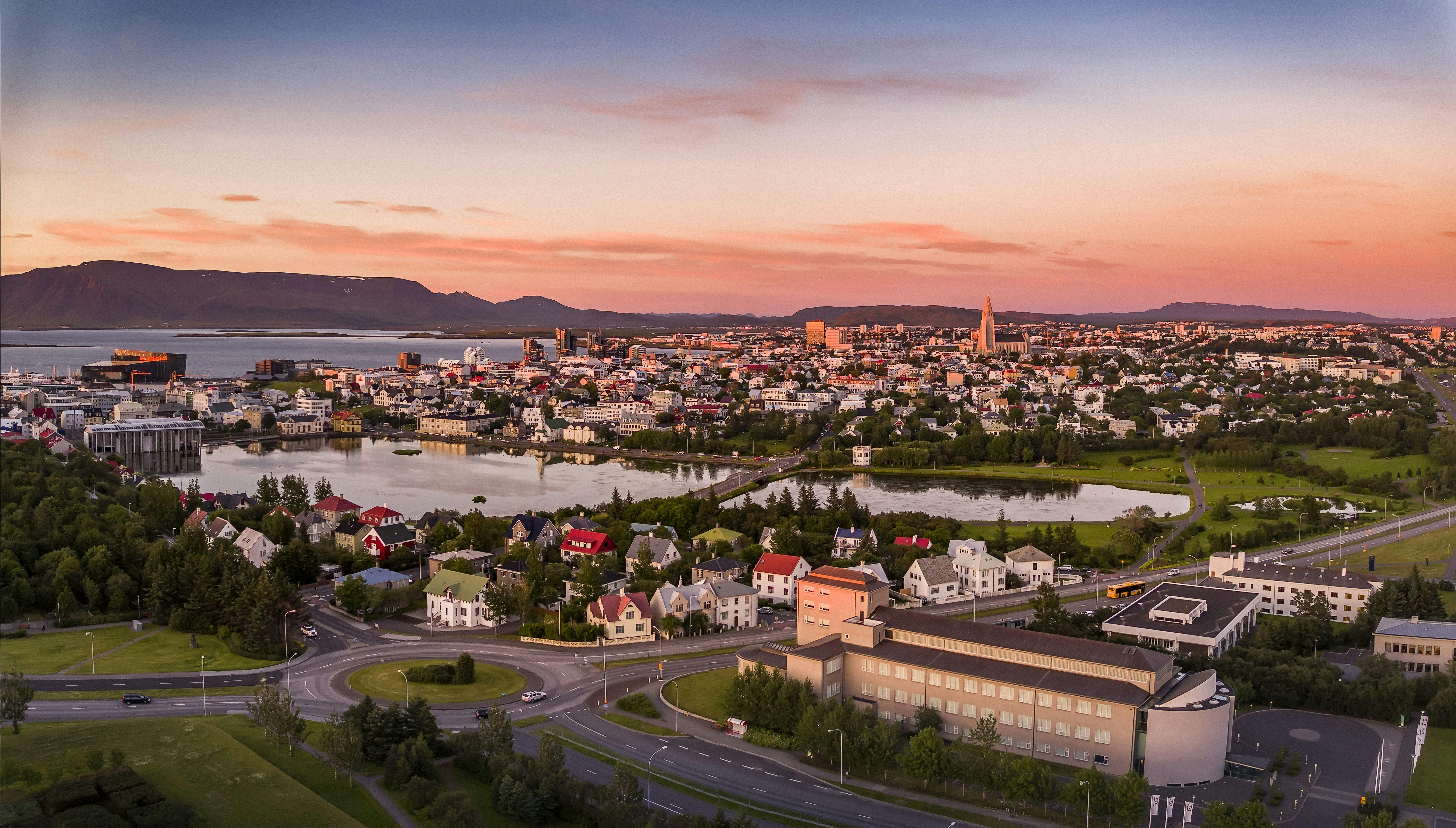
Reykjavík Weekend Getaway

How to Get to Iceland
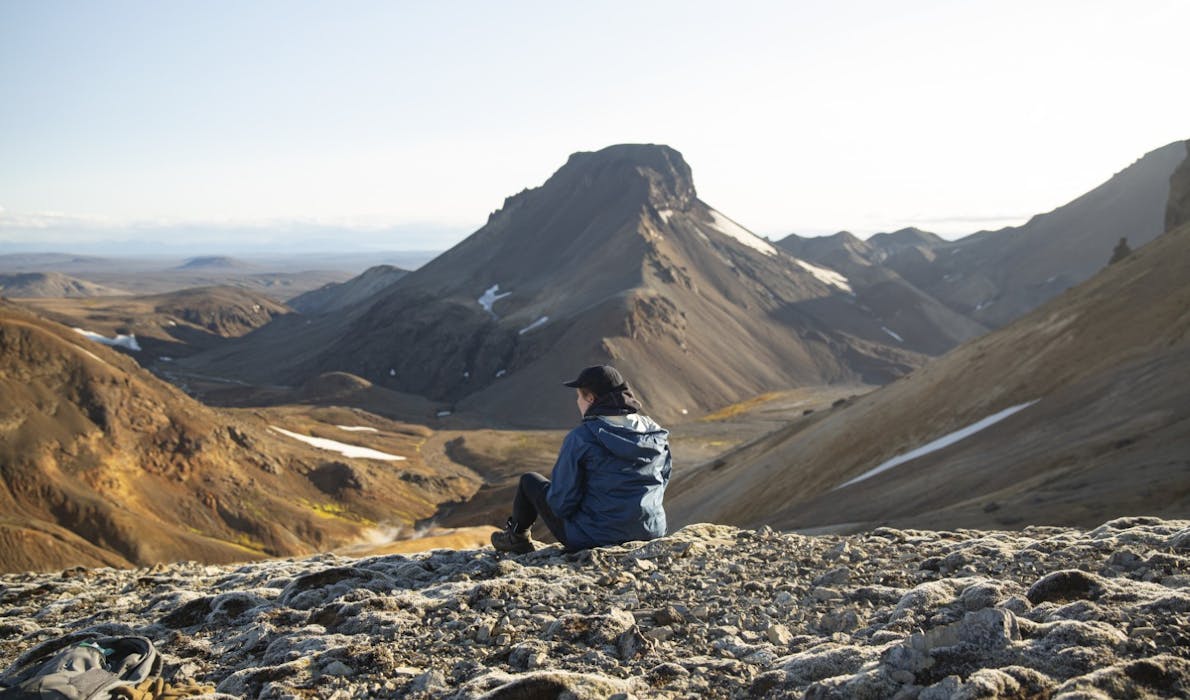
Planning a trip to Iceland
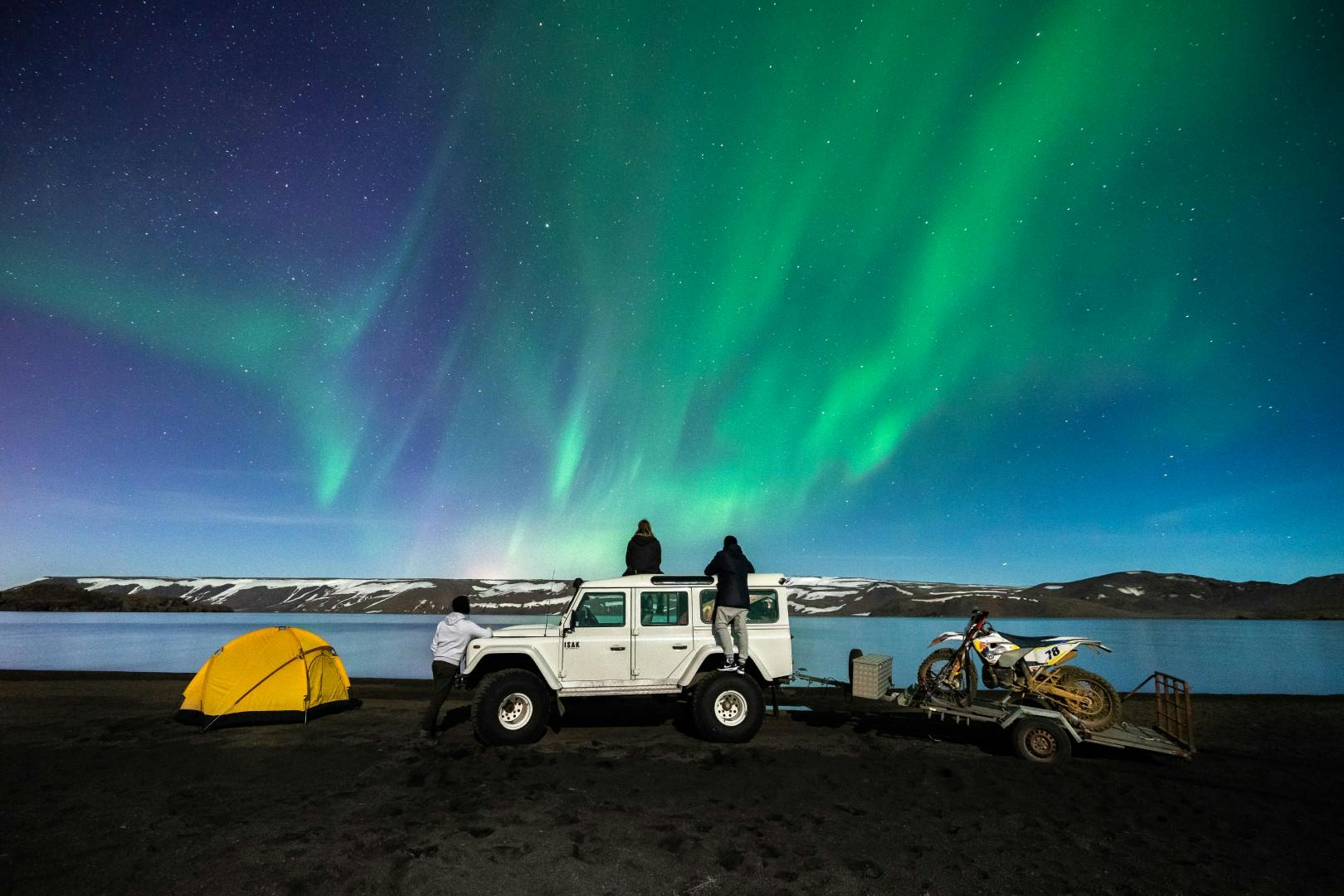
Camping in Iceland
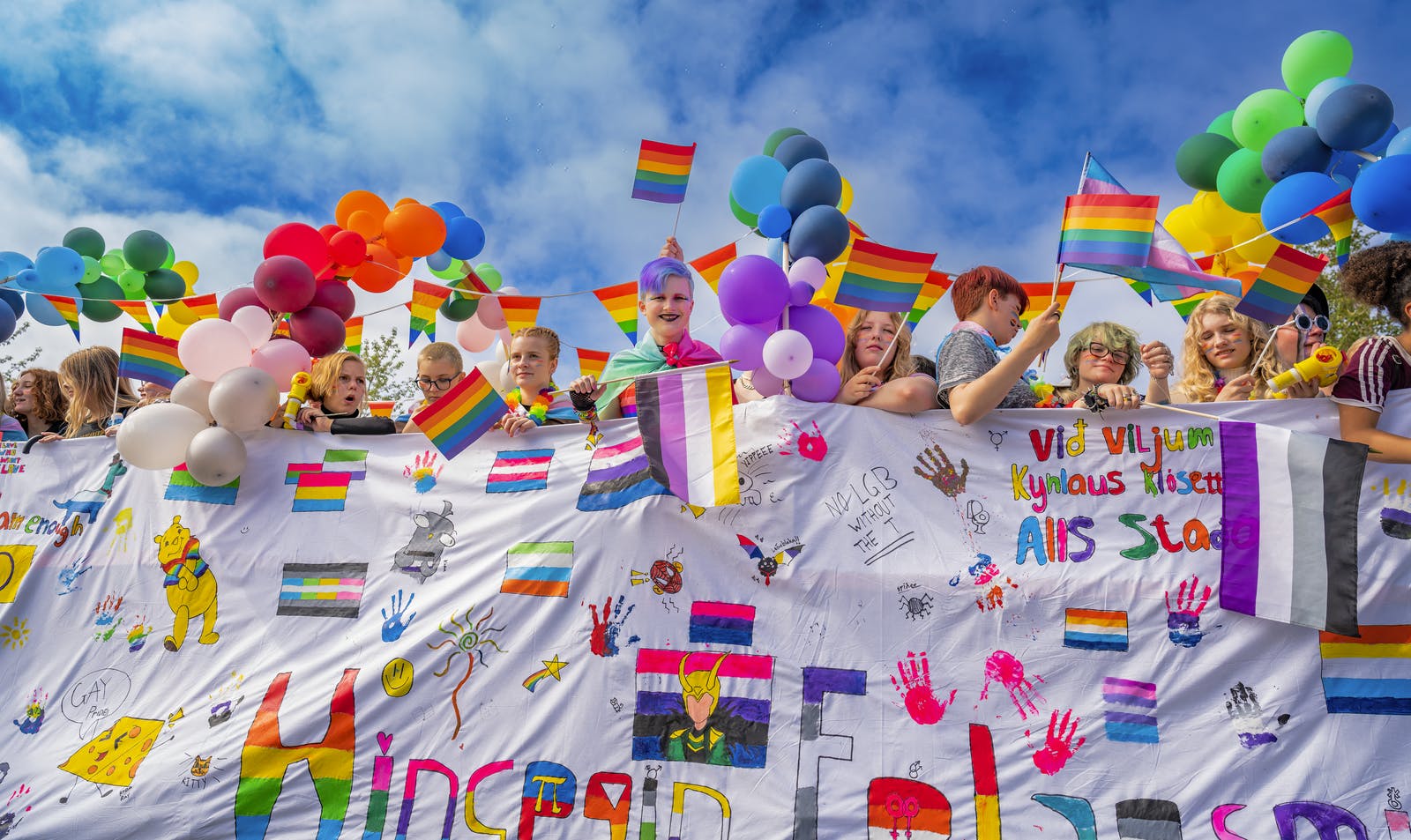
LGBT+ Travel in Iceland
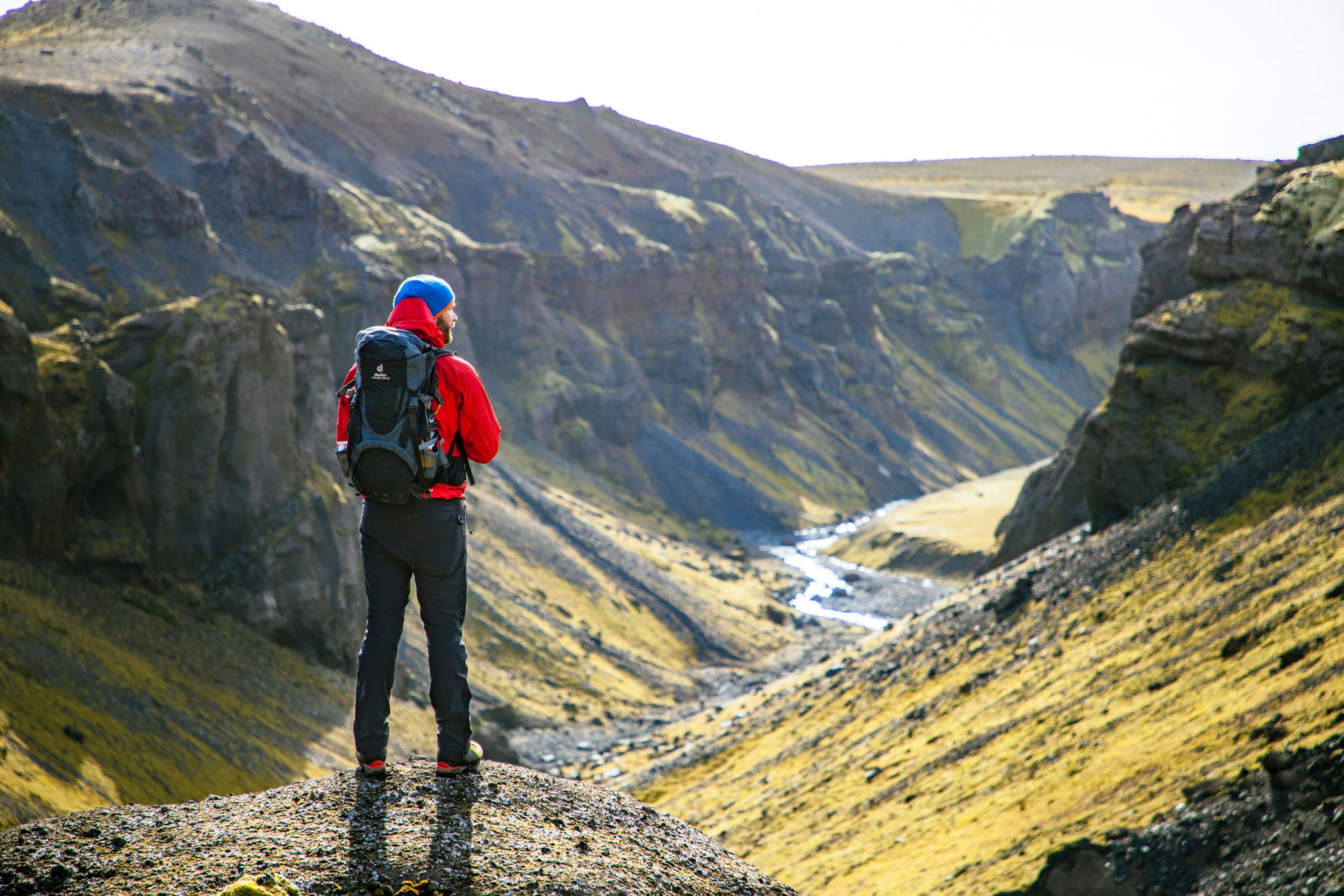
Hiking in Iceland

Quality of Life in Iceland: The Secrets to Know Before Visiting

Experience the 2026 Total Solar Eclipse in Iceland
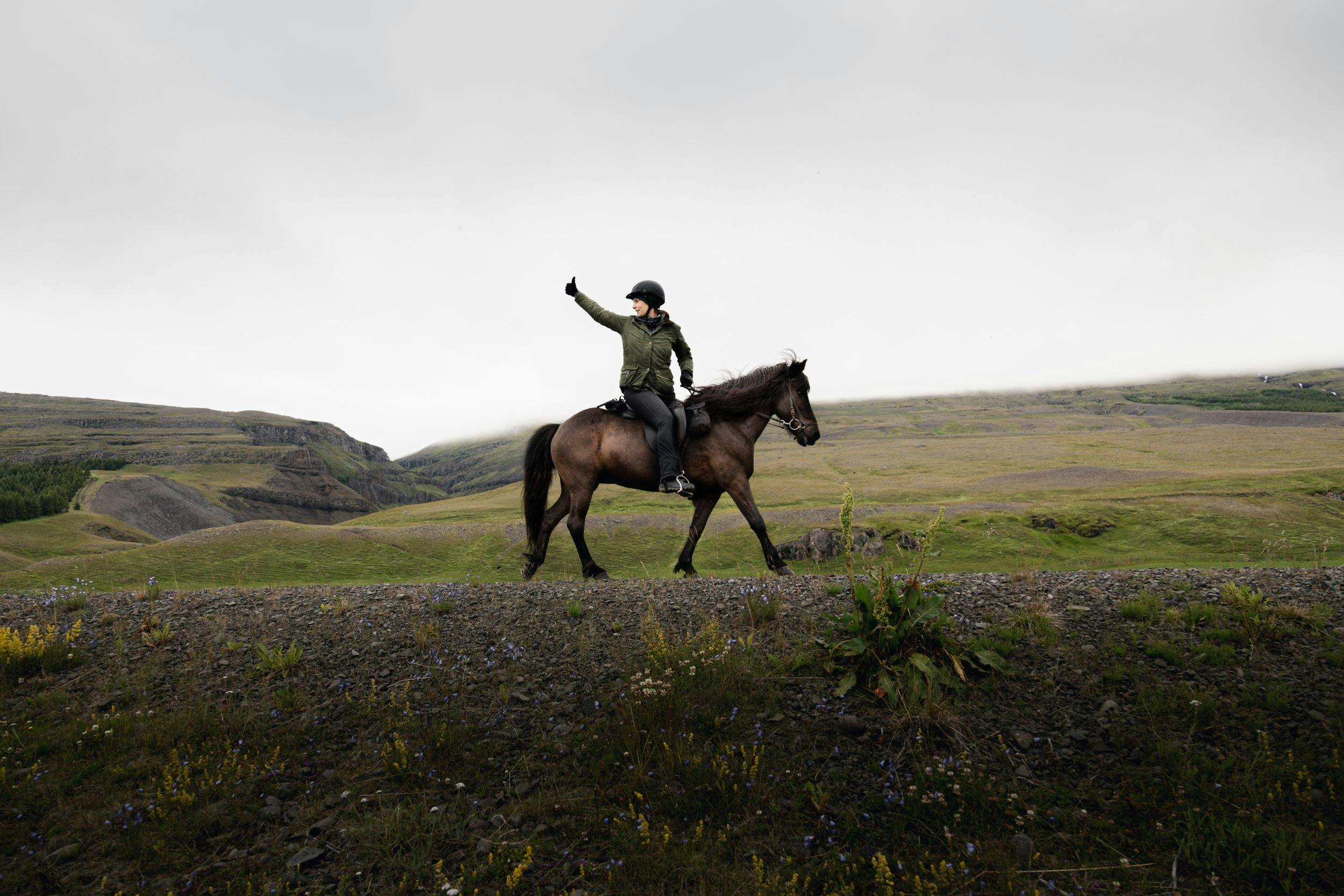
6 Unforgettable riding tours in Iceland
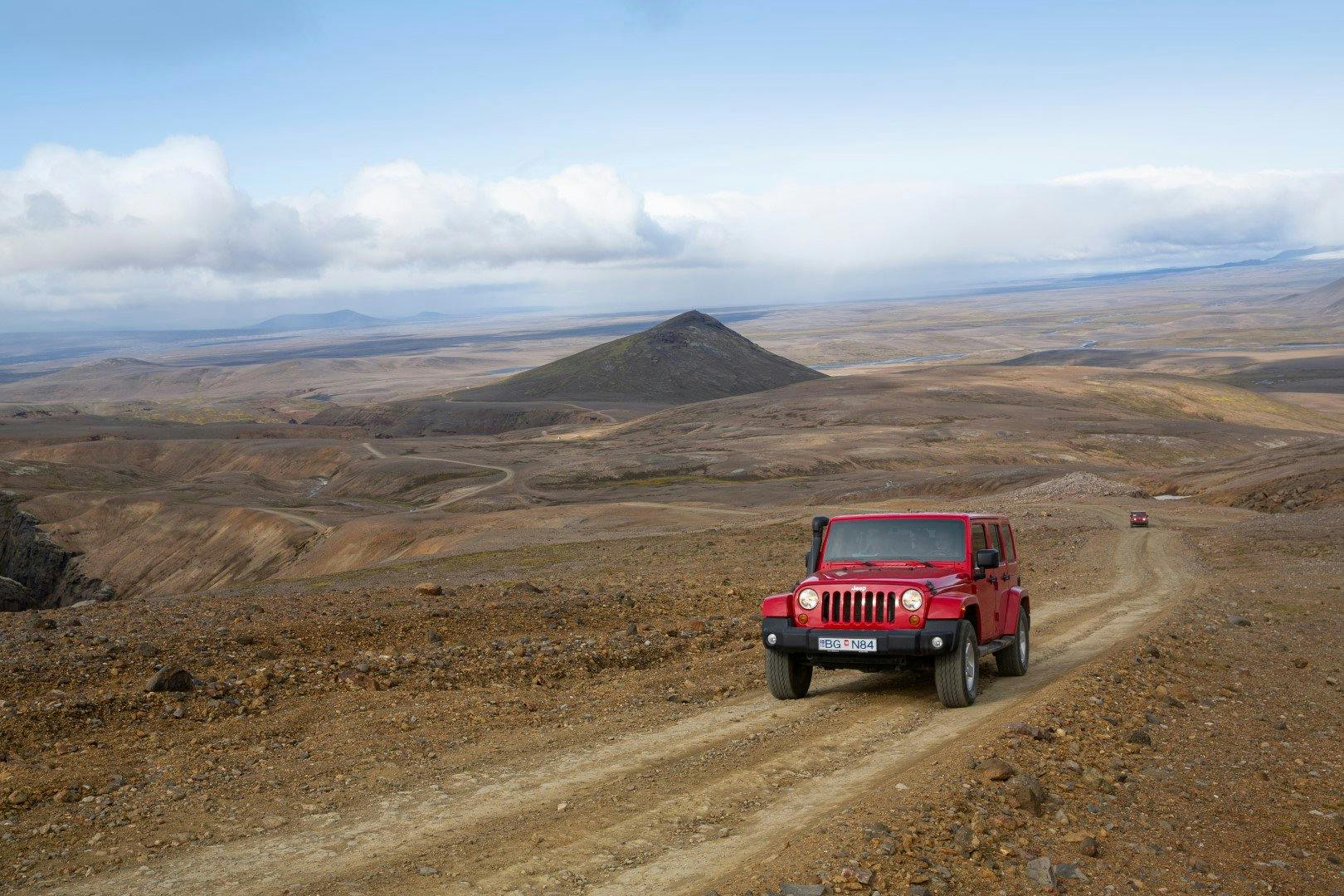
Getting Around Iceland: Transport for Independent Travelers
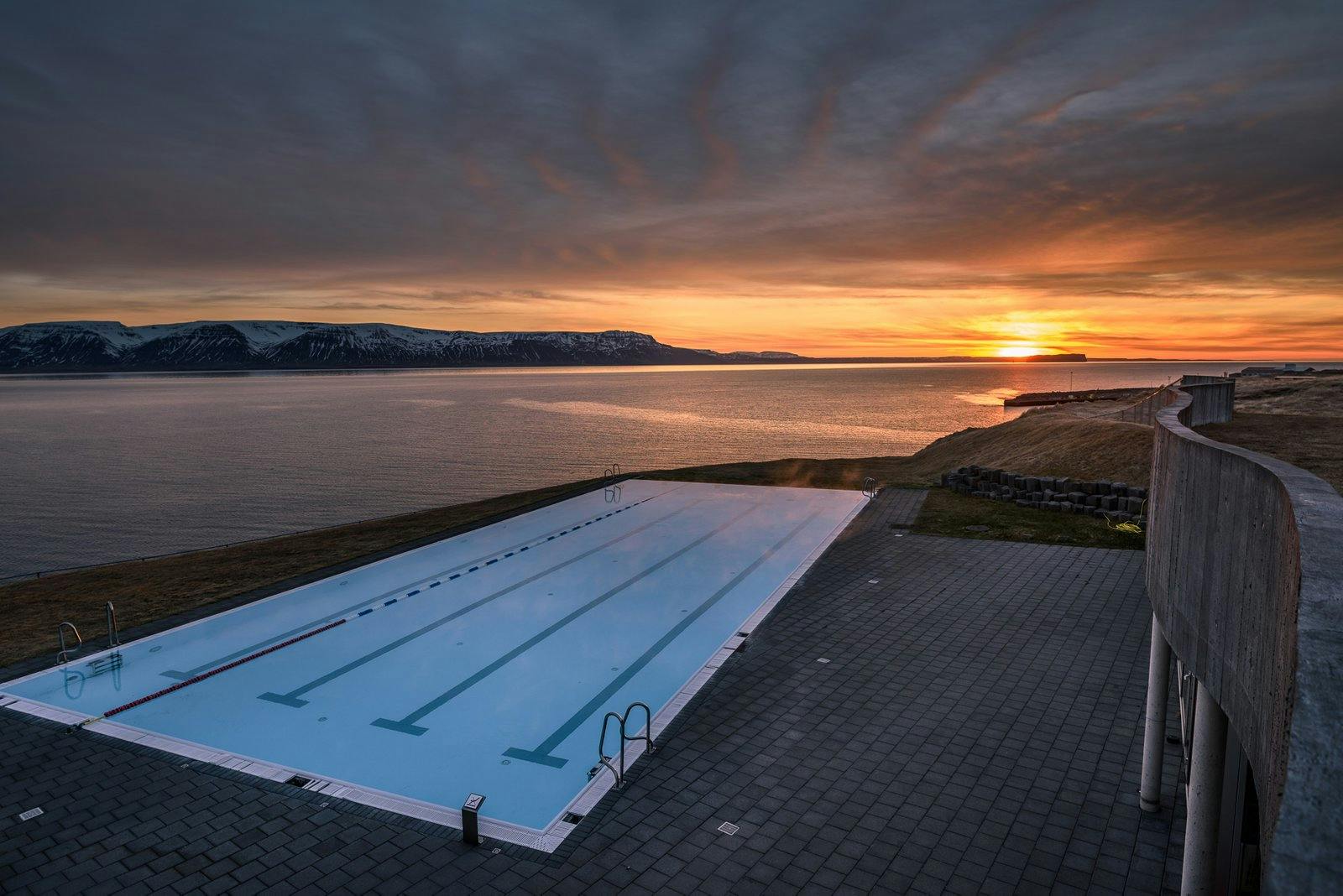
Swimming pool culture in Iceland

Incredible travel experiences money can indeed buy
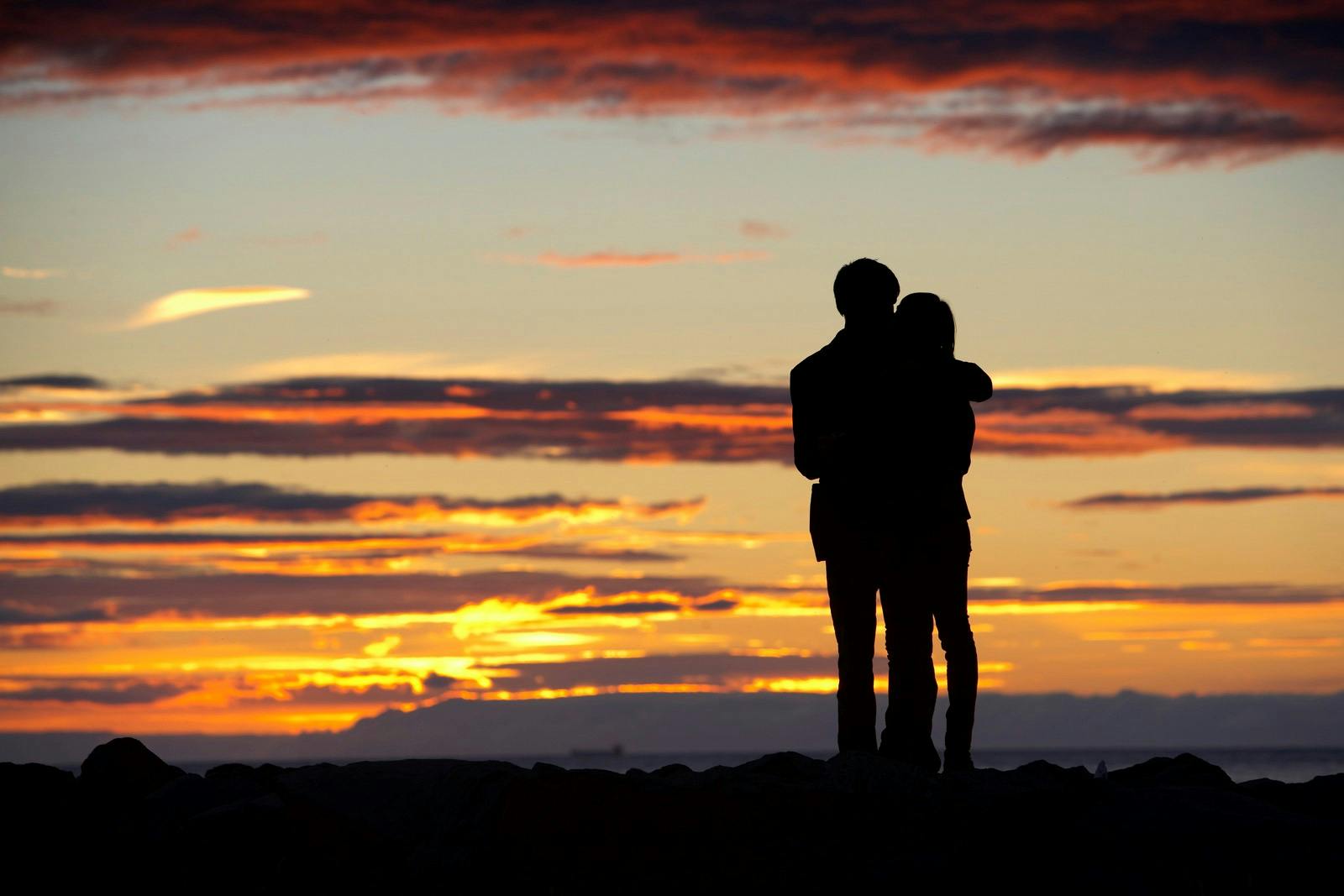
Iceland for lovebirds

The Volcanic Way - An Adventure Through Iceland in the Making
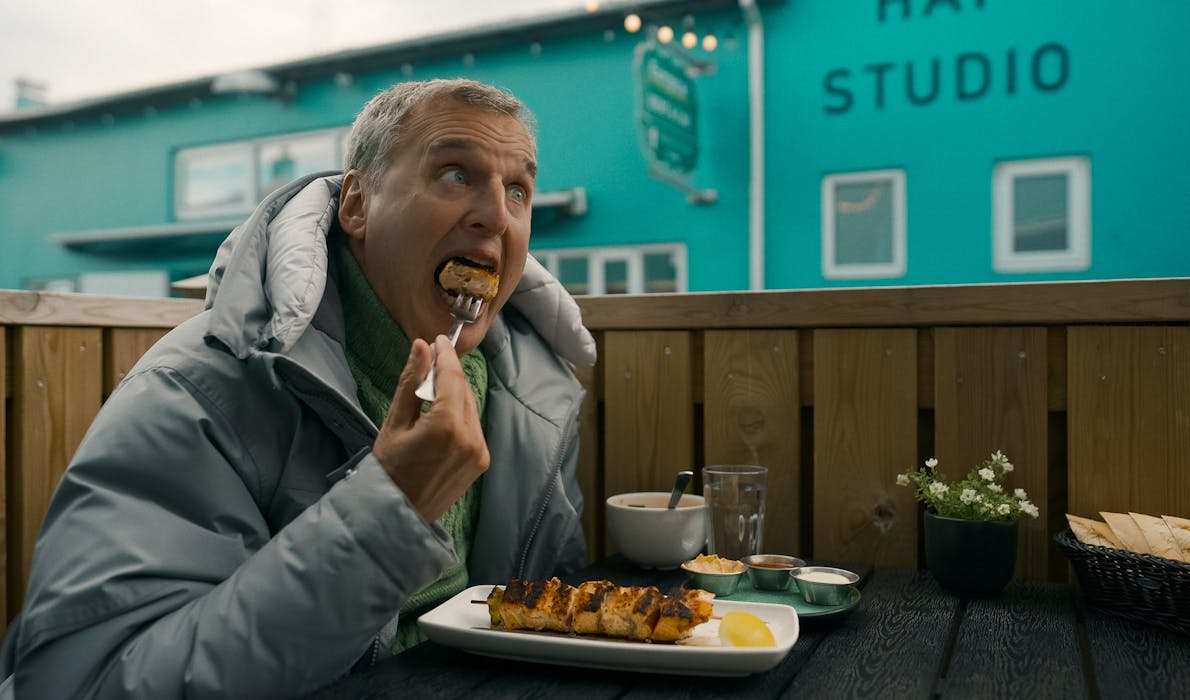
Somebody Feed Phil Foodtrail in Iceland
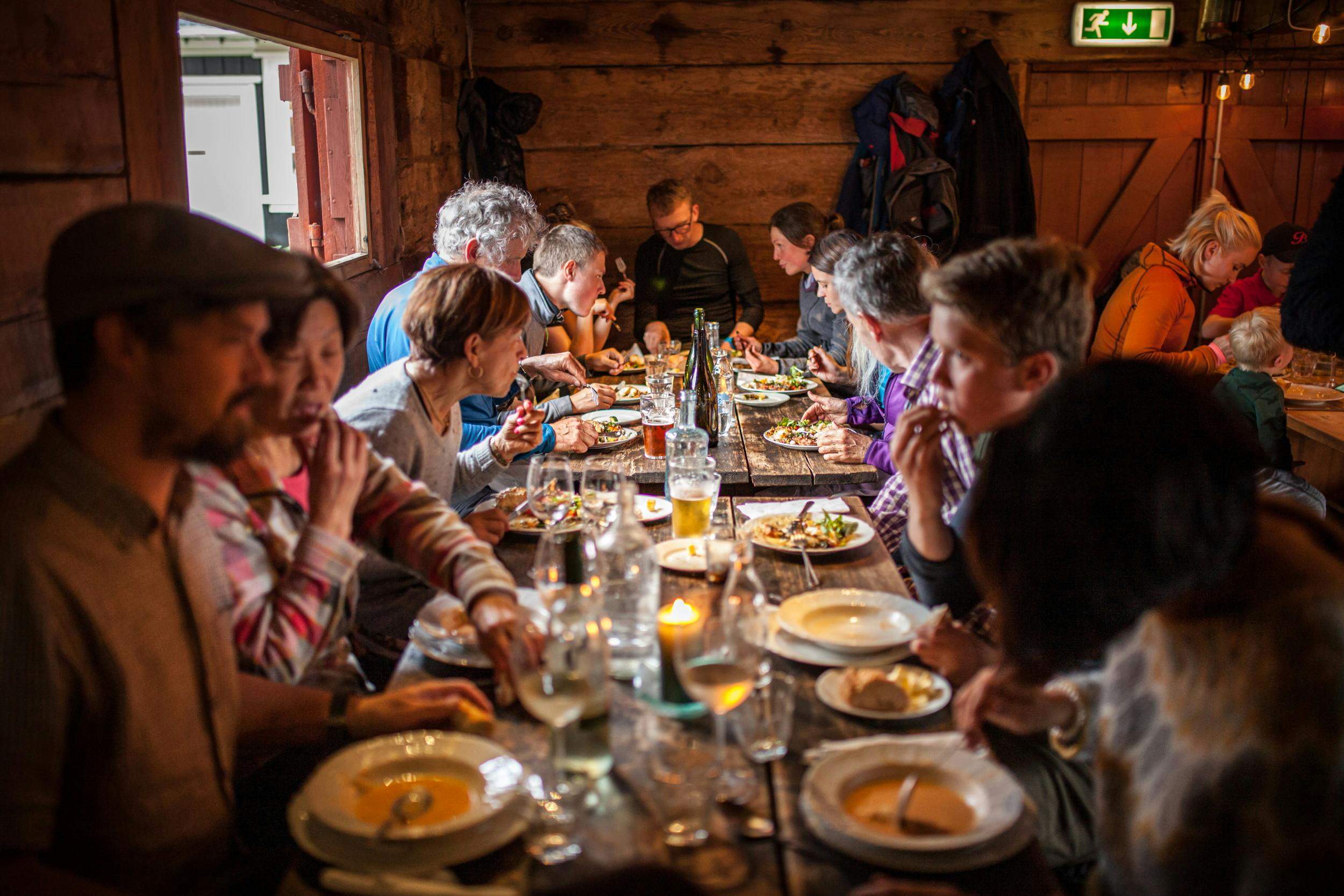
16 places of Character and Charm to eat for Every Corner of Iceland
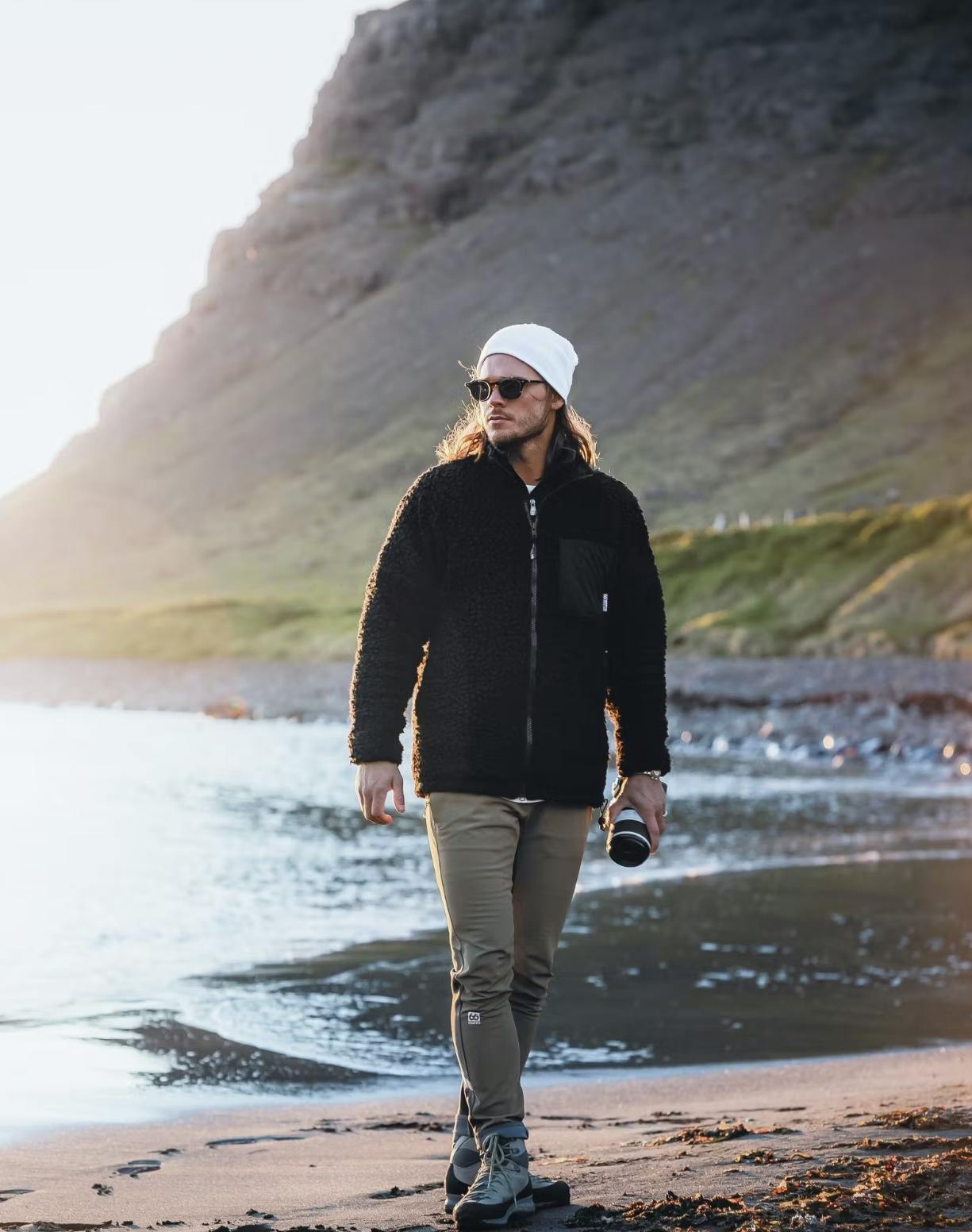
What to wear in Iceland
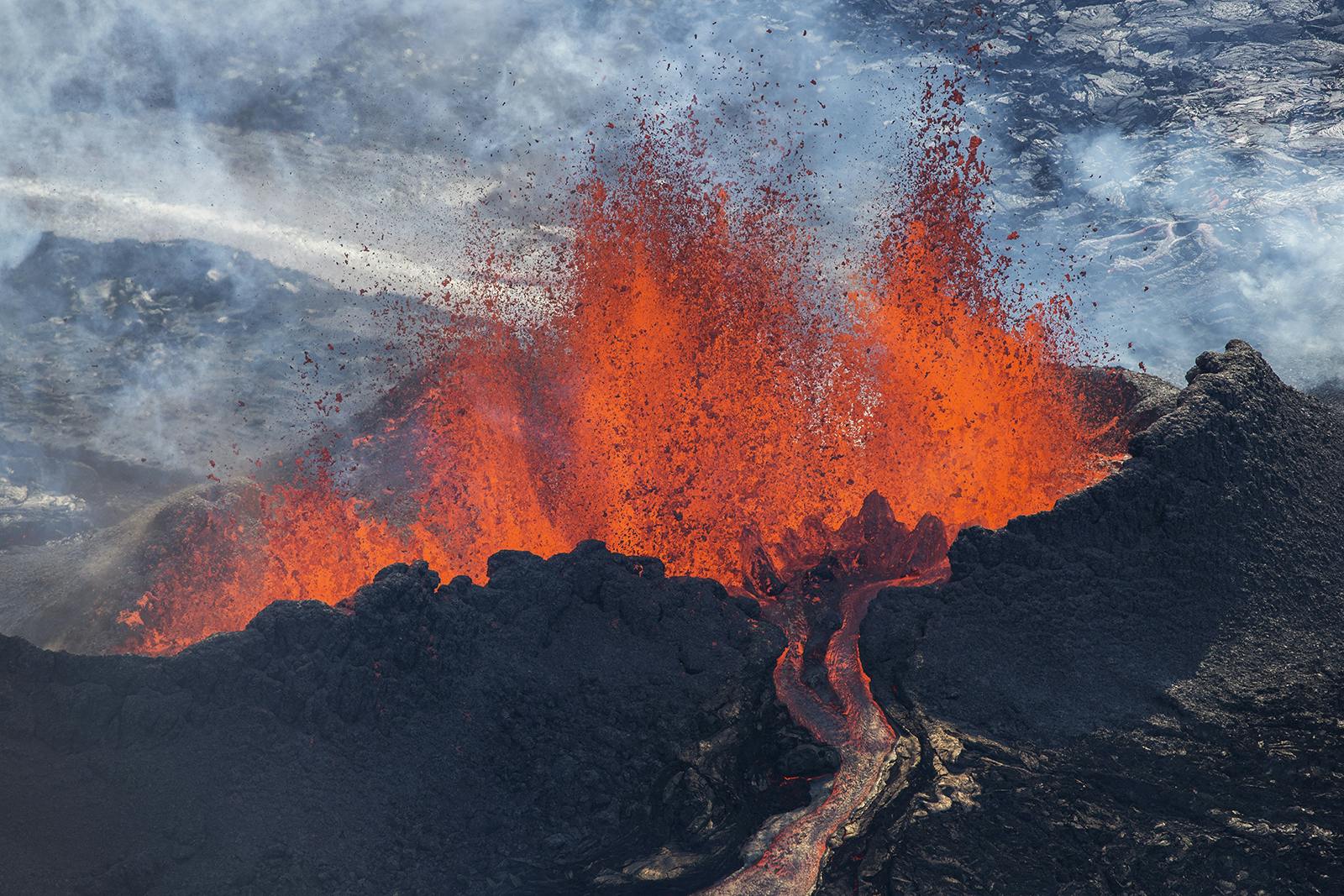
Volcanos of Iceland
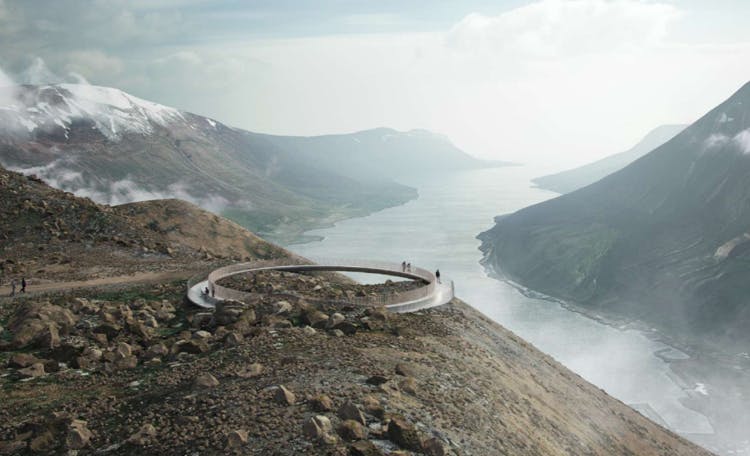
New destinations in 2024
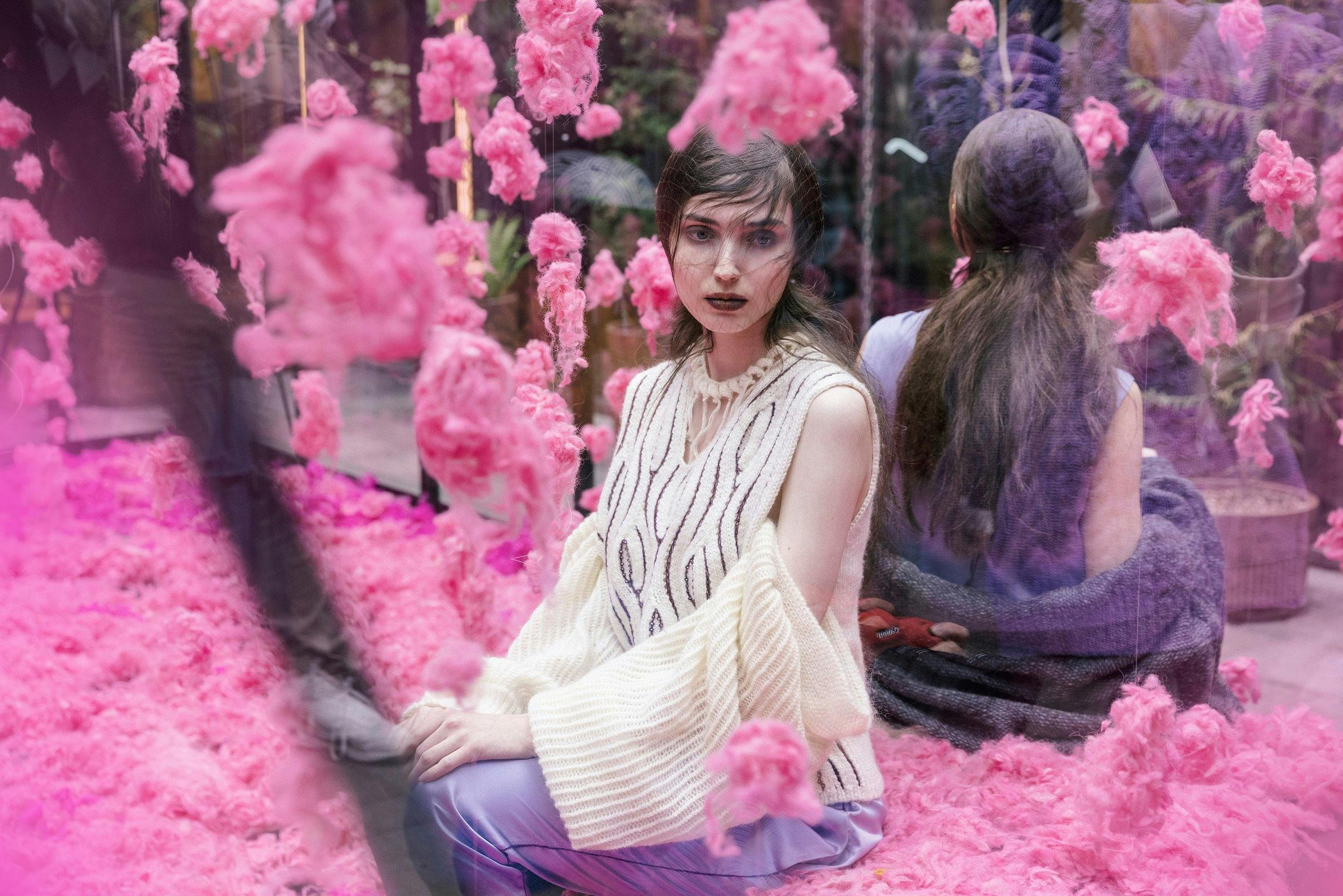
How to practice your hobby in Iceland
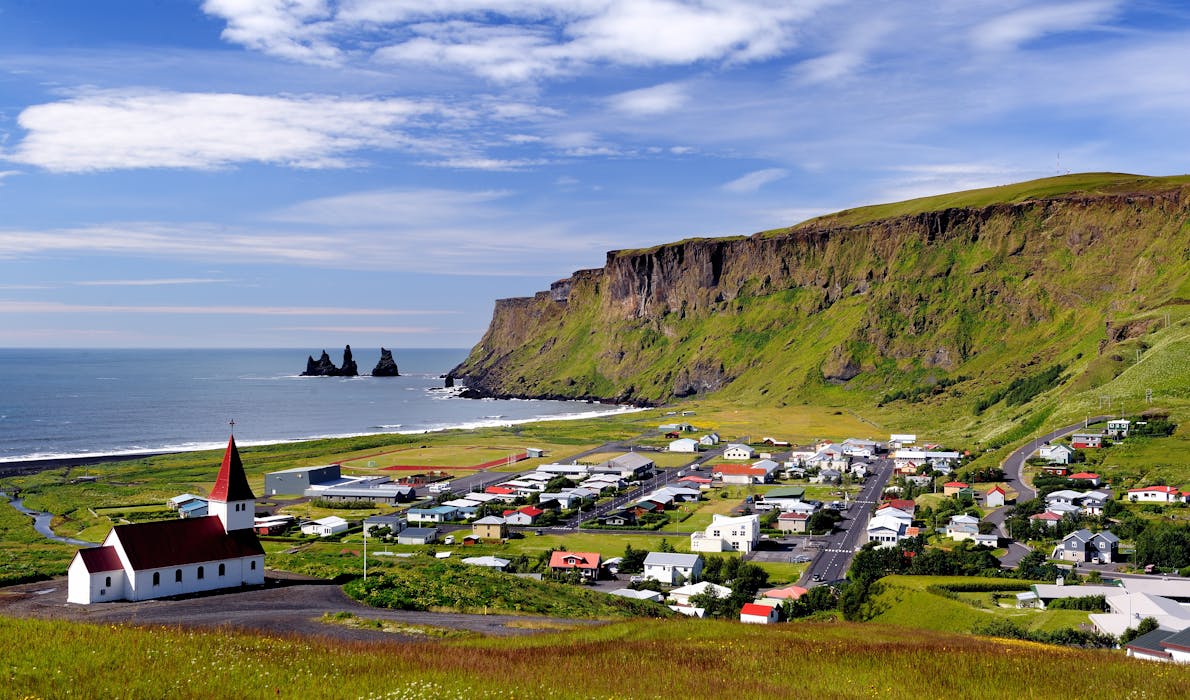
Vík: The idyllic Icelandic village
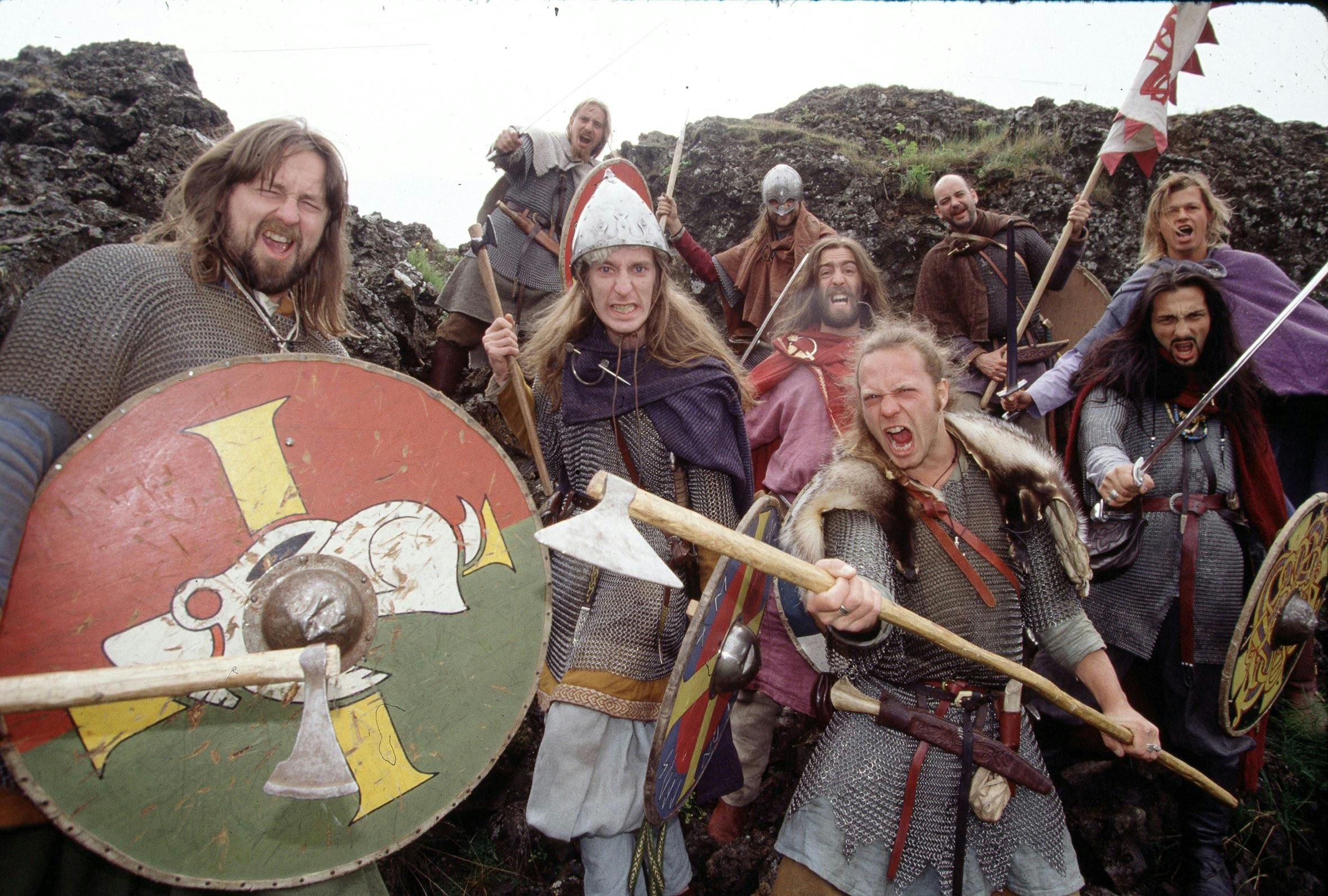
Key Locations for Viking History in Iceland
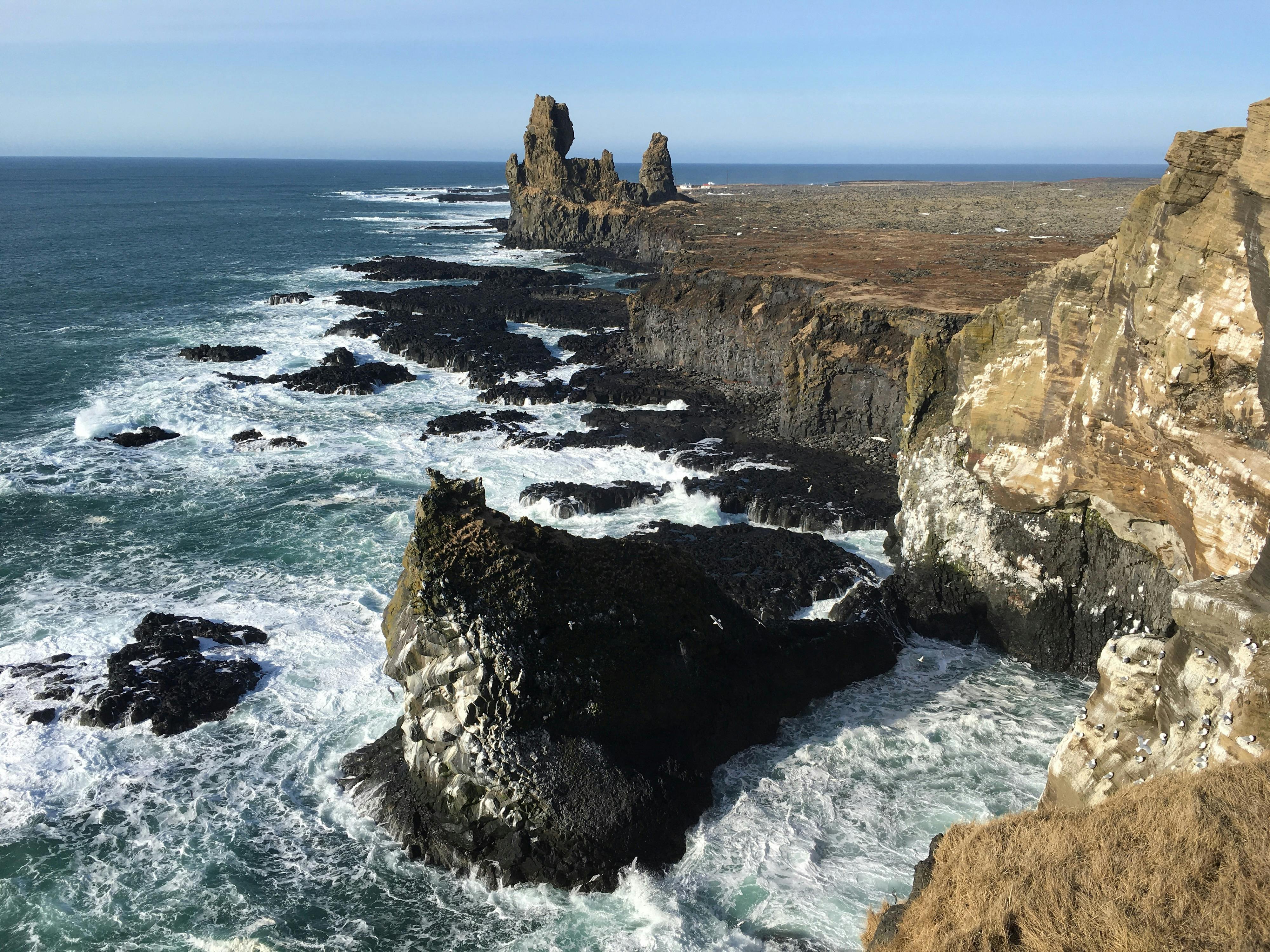
A 3 day mini-break in West Iceland
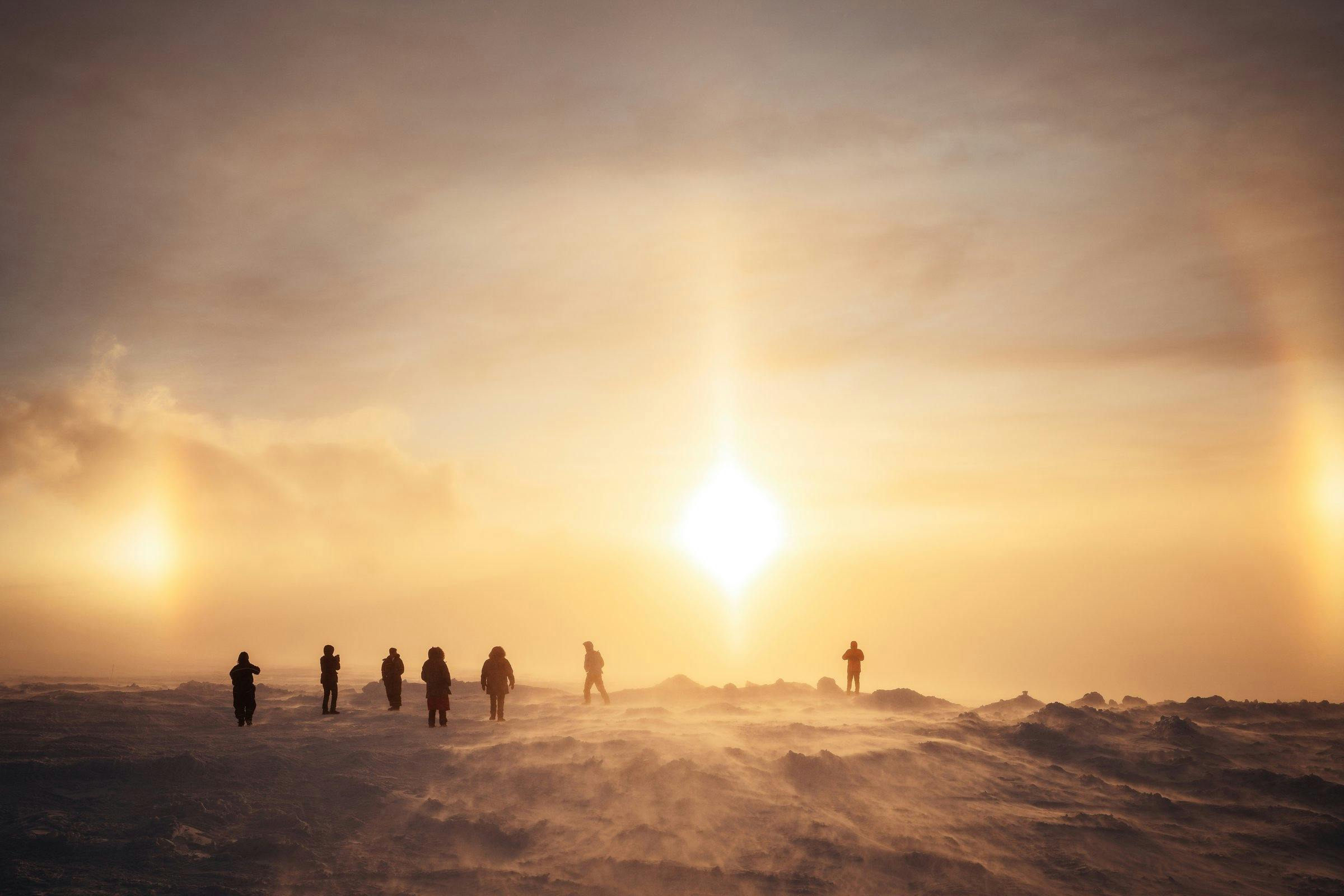
Iceland's Three UNESCO World Heritage Sites
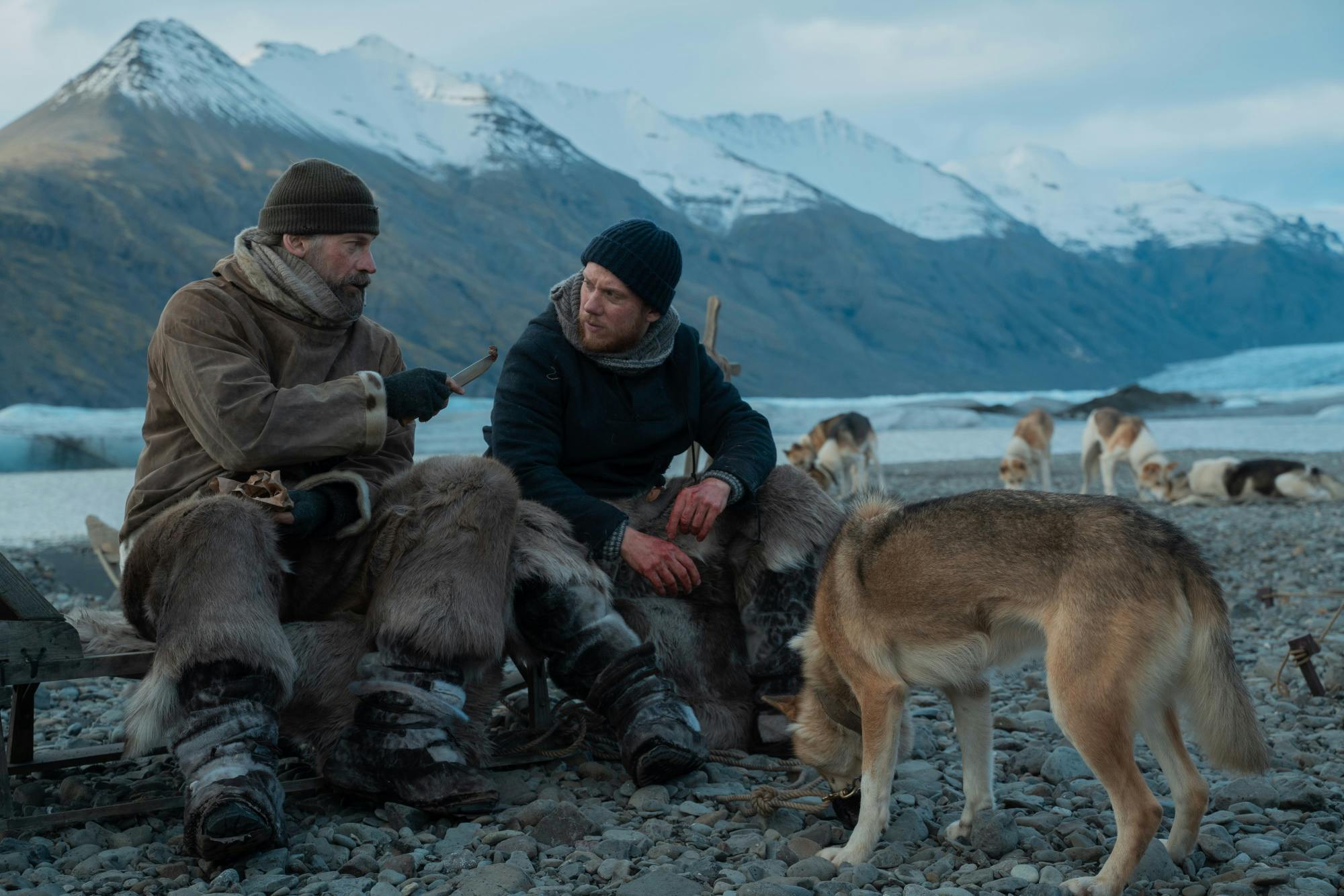
Famous film sights in Iceland
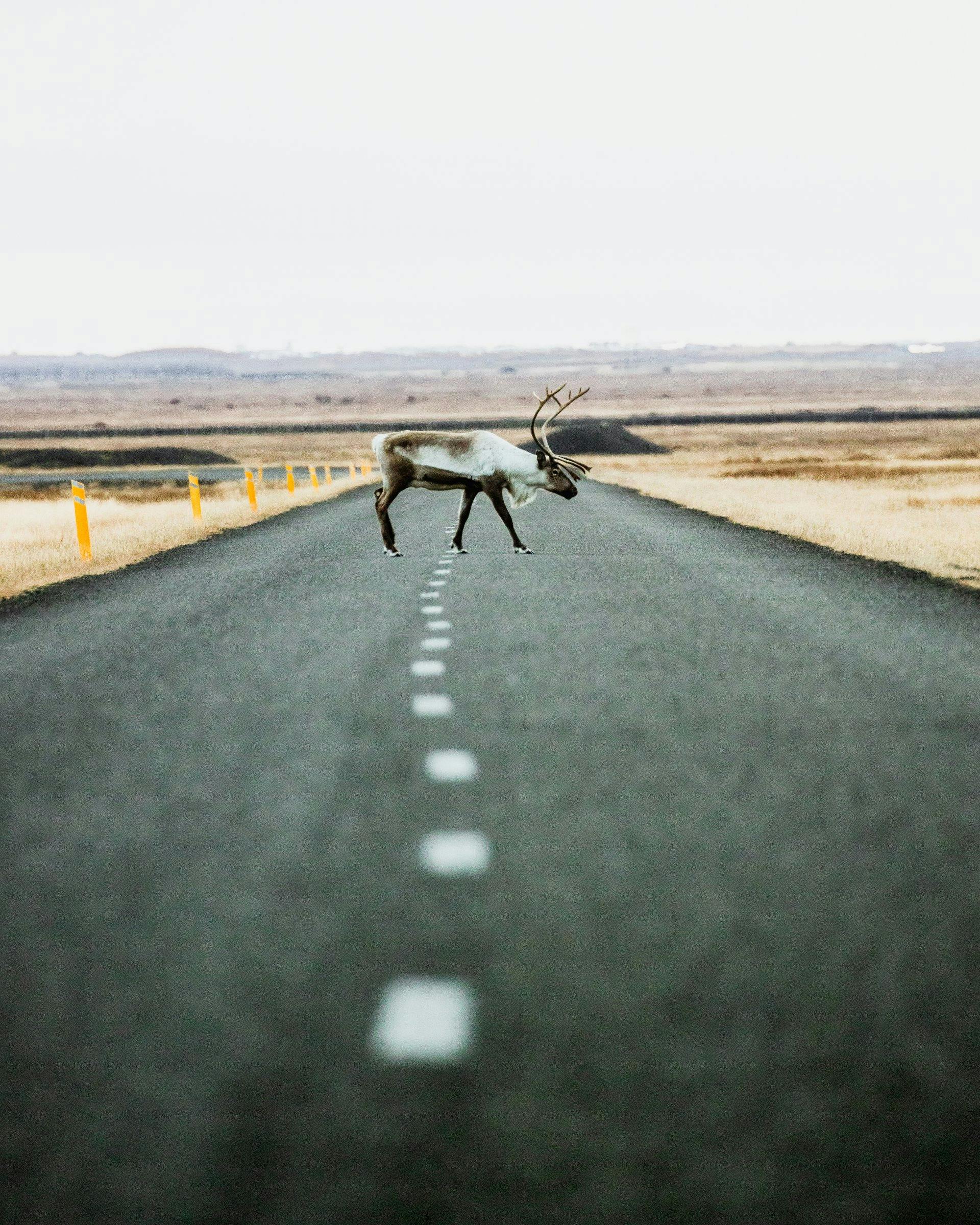
The Eastfjords
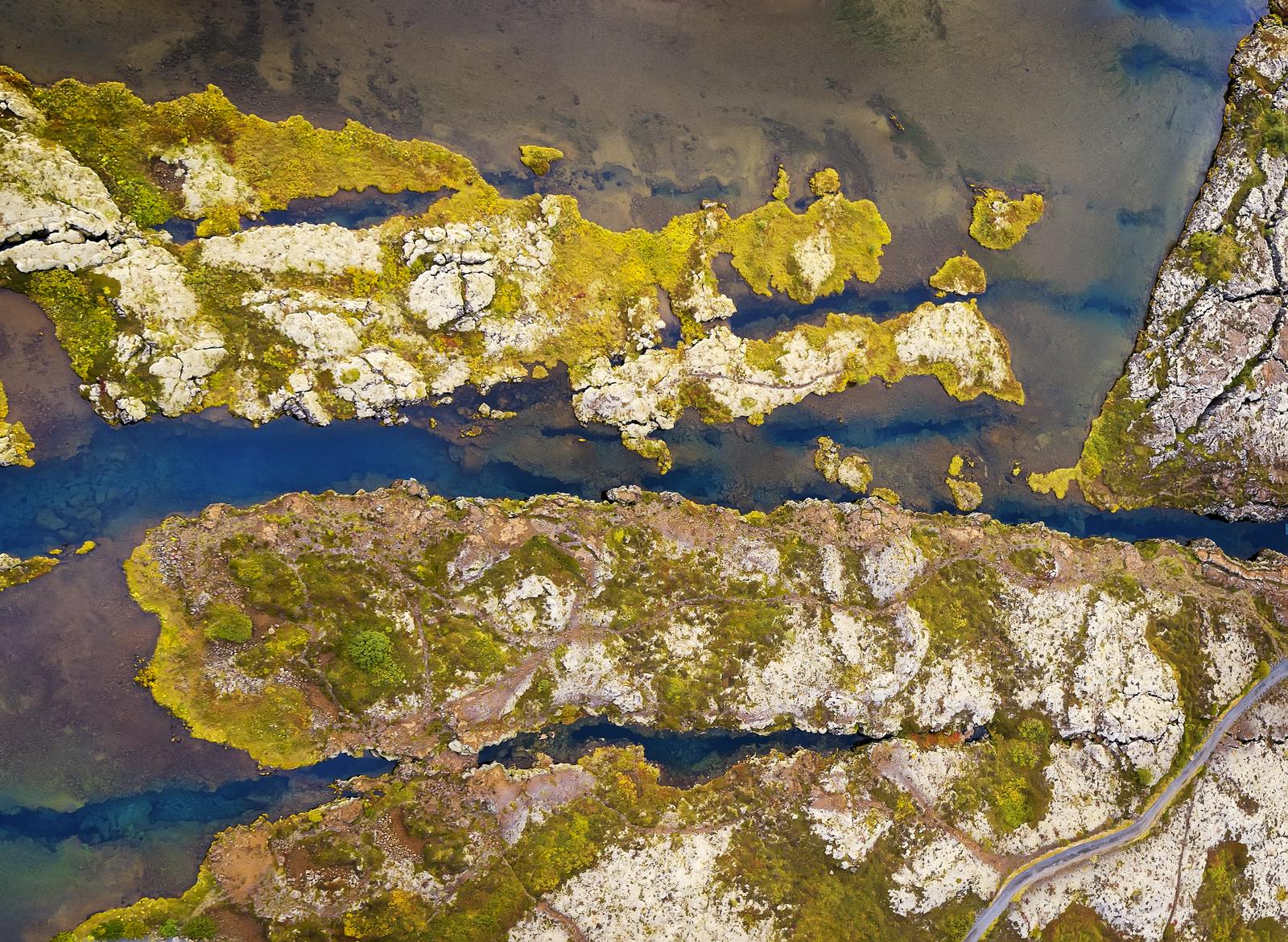
Safe travel in Iceland
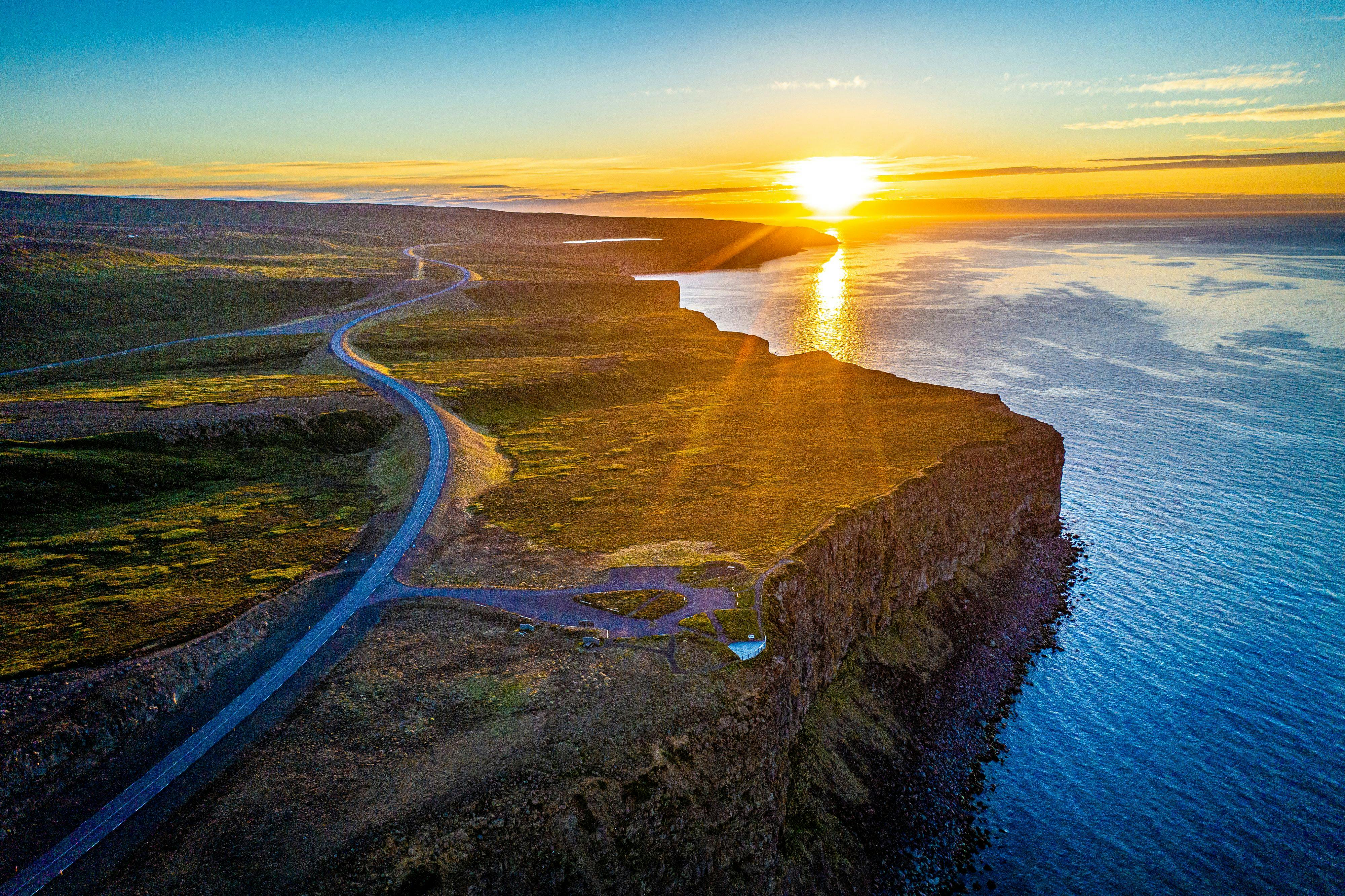
Arctic Coast Way
_Diamond.jpg?ixlib=gatsbyFP&auto=compress%2Cformat&fit=max&w=2000&h=1333)
The Diamond Circle
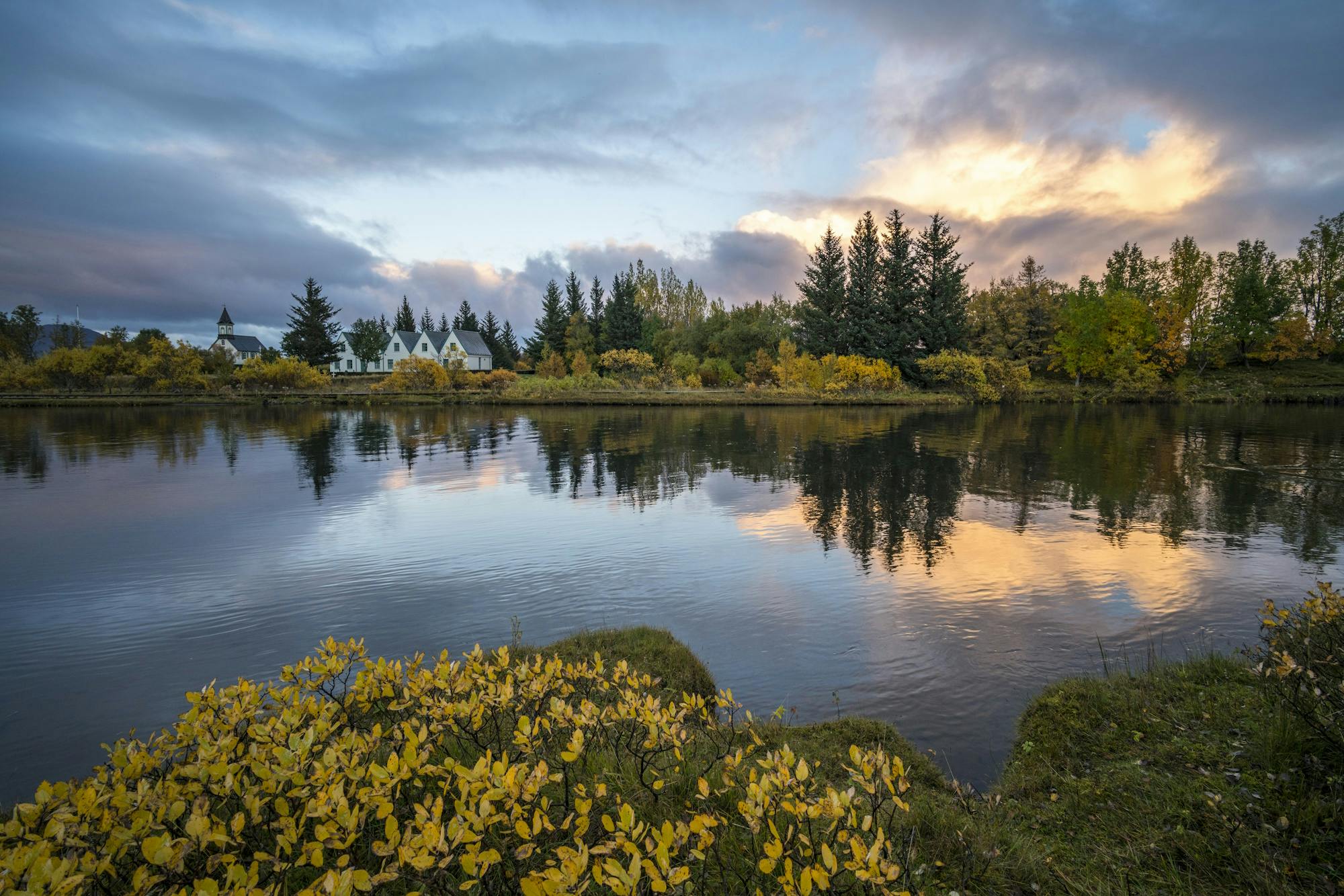
Þingvellir National Park

Volcanic Activity on Reykjanes Peninsula
Since 2021, the Reykjanes Peninsula has witnessed a surge in seismic activity, including several volcanic eruptions. Despite this, Iceland has remained a safe and open destination for travelers.

Regions of Iceland
Iceland is typically divided into 7 different geographical regions. Each region differs slightly in respect to culture and landscapes, but are uniquely Icelandic. Find your favorite part of Iceland.
Looking for things to do?

Wellness in Iceland
Experience the ultimate wellness retreat for your mind, body, and soul amidst the breathtaking landscapes of Iceland. Across the country are world-class spas that tap into Iceland's abundant—and sustainable—mineral-rich waters from geothermal sources. Iceland is a true haven of relaxation and rejuvenation, beckoning tired travelers from across the globe.
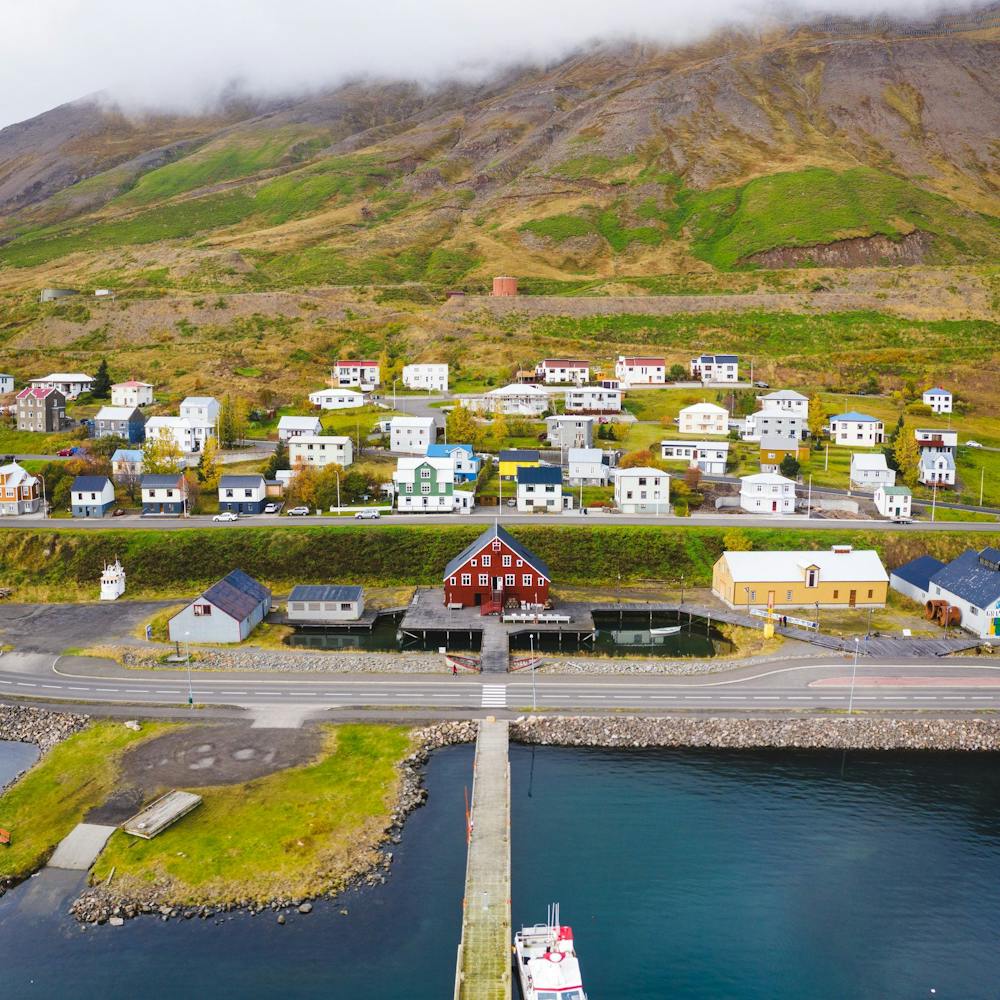
Appreciate our towns & villages
Did you know that there are over 100 towns and villages to explore throughout Iceland? We encourage you to stop and look into these charming, beautiful, and often quirky places. History, art, nature, local cuisine, and year-round swimming pools abound. You might be surprised at what you find!
Sign up for our mailing list
Stay connected and find out what is happening in Iceland.
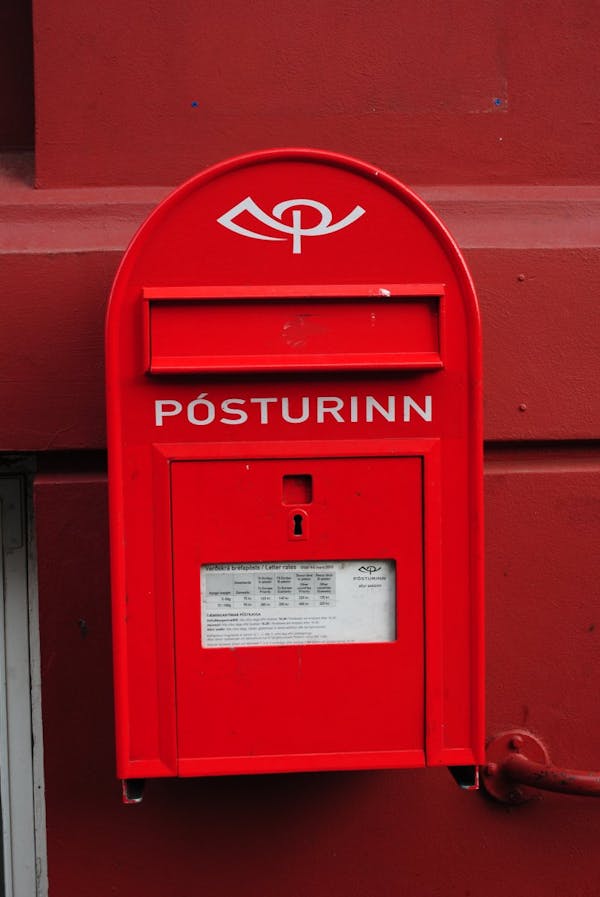
- Facts About Iceland
- A Country for All Seasons
- Nature´s Variety show
- Summerhouses & Cottages
- Hotels and Guesthouses
- Farm Hollydays
- TravelGuide
- National Parks
- Culture and Arts
- Dining & Entertainment
- Festivities
- Online Casinos

The world you have never seen in ICELAND
Discover iceland.
Discover Iceland tourist destination by following the best guide to Iceland. Think of Iceland and there are several familiar associations: hip Reykjavík, the beautiful therapeutic Blue Lagoon, or perhaps our musical exports Björk or Sigur Rós. But this land of boiling mud pools, spurting geysers, glaciers and waterfalls is also an adventure playground. Its breathtaking landscape is an inspiration to artists and photographers. Iceland is the least densely populated country in Europe, with a pure, unpolluted and truly magical landscape. Iceland’s summers are surprisingly warm, lush and green, with days lengthening until midsummer, when the sun dips down to the horizon but never sets. During winter you can marvel at the amazing, undulating green, blue, yellow and pink lights of the aurora in the night sky, and the winters are not as cold as you might imagine. And if they are quite cold, you could stay at your cozy hotel and grab a cup of hot cocoa and visit the 5 Star Online Casino where you will get extremely low wagering bonuses that will minimize the risk and requirements when it comes to betting with your own money. Regardless of when you visit, you can be assured of the warmth of the Icelanders’ welcome and their desire to share their culture and make every effort to ensure that your stay is a pleasant one.
Tourism in Iceland
People from all over the world come to see and experience Iceland’s nature, culture, calm, and peaceful atmosphere. There are a lot of tourists that visit Iceland, around 1,5 million per year and contribute from 5% to 10% on the country’s GDP.
Business Iceland is a public-private partnership established to lead the promotion and marketing of Iceland. The job of Business Iceland is to promote and encourage demand for Iceland’s vast array of products, services, investment opportunities, and as an exotic location for film and television shooting.
Íslandstofa takes care of branding and marketing for Iceland and Icelandic export industries, supports Icelandic companies in entering foreign markets and paves the way for foreign investment in the Icelandic economy.
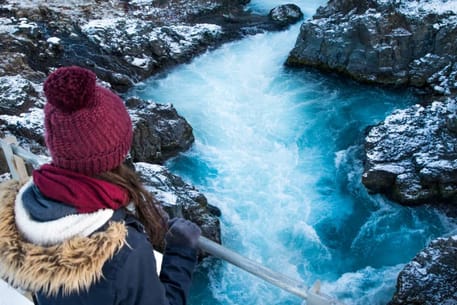
Iceland’s Online Casino
We asked some of the local people, and they said that there are a few of Iceland’s online casinos, but they are not very popular among the people because they are new. They have ads on local websites and Facebook, and some people have given it a try, and they are positively surprised by the variety of slots games that are available.
Pick Your Online Casino
On Iceland tourist boards you will not find any land casinos, video poker, slot games or blackjack rooms. There are some bingo games available, and sports betting is legal, but Iceland’s government does not bother if you play on foreign online casino. We have some friends that live in Iceland, and they say that even the Icelandic people play on the mobile casino that comes from a different country.
Their GDP is high, and their tax is law, they don’t need the extra tax revenue that can be provided from gambling. It’s not declared the happiest country in the world for no reason.
Nature´s variety show
Geologically speaking, Iceland is a very young country; its creation began less than 20 million years ago and is still progressing today. Volcanic eruptions in the Mid Atlantic Ridge, on the bottom of the Atlantic Ocean, created a mountain which grew above sea level, resulting in an island. So Iceland truly has a volcanic origin.This Iceland Travel Blog is a travel guide where you can find travel torus and the most wanted Iceland tourist destination.
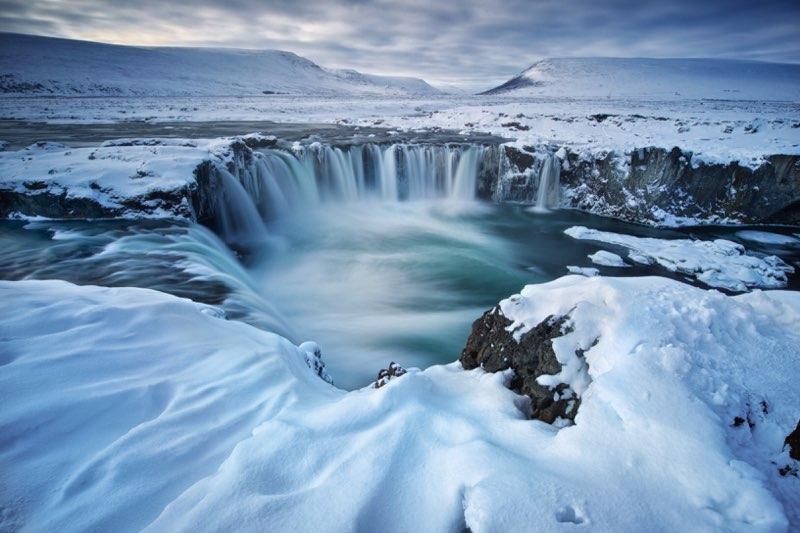
Explorational Stories
News and Updates
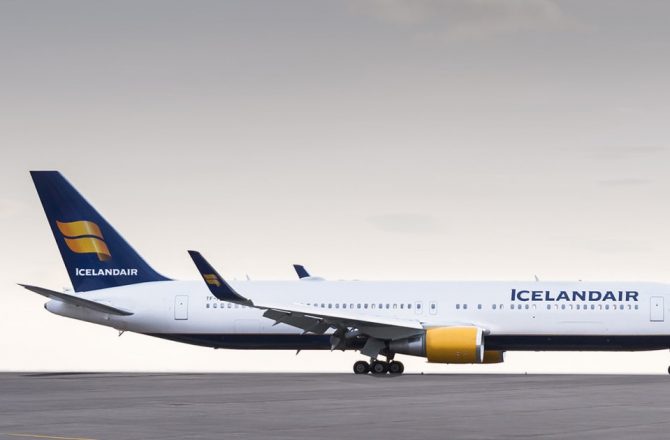
- January 3, 2019
- Transportation
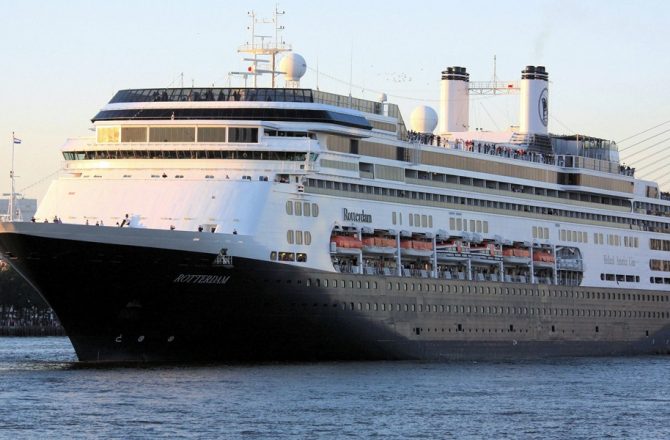
- December 25, 2018
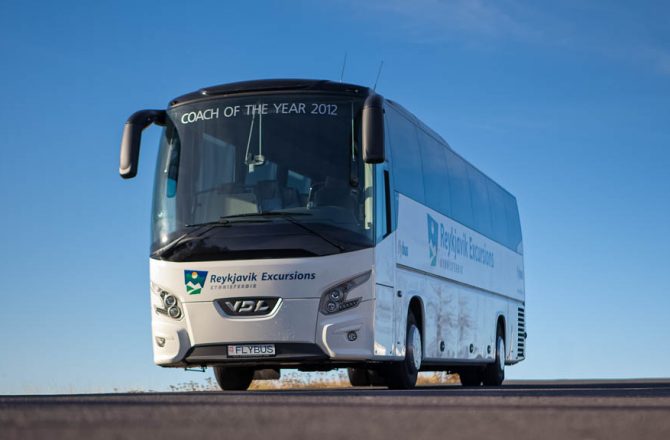
- December 24, 2018
Iceland Tourism Blog offers you a great variety of tours, some covering large parts of the country, others small areas at a time.There are traditional Iceland travel tours as well as tours quite different from what can be experienced elsewhere. There are nature tours with striking landscapes, young lava fields, roaring waterfalls and majestic glacial ice-caps. In addition, there are organized day tours, and weekend and holiday tours all year round with Icelandic touring clubs where the emphasis is on hiking. As you can see this blog is the best travel guide to Iceland.
Pround Numbers
Facts about Iceland
Iceland is an island of 103.000 km2 (39,756 sq.miles), about one-third larger than Scotland or Ireland. Its highest peak, Hvannadalshnjúkur, rises to 2.119 m and over 11 per cent of the country is covered by glaciers, including Vatnajökull, the largest in Europe. If you are mountain lover, you might be interested in discovering some tourism information about Iceland, with a little help of this Iceland Tourism Blog.
Tallest Mountain is 2119m
Longest river is 230km
Tallest waterfall is 190m
Largest glacier is 8300km2
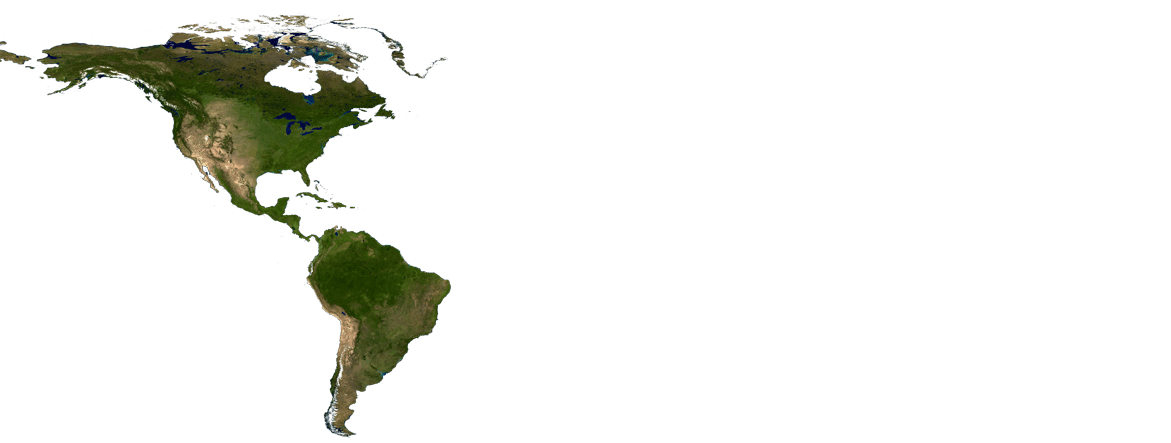
Choose from where you want to travel.
Under the Ministry of Industries and Innovation there is the independent authority of the Iceland Tourism Board, who depends on tourism to prosper. Visit the Iceland Tourism Information Office and get to know all possible activities you can do while staying in Iceland.
Iceland Travel Guide This Iceland Travel Blog offers you practical information and useful tips, so you don’t miss the most famous landmarks, mountains, glaciers, caves and many more things in Iceland that are worth to be visited. So many fun activities to try. You can check out Lake Thórisvatn from a different perspective and book a boat. The experience is equally enjoyable as Lake Tahoe boat rentals . You can travel to The best Travel Guide to Iceland can help you plan your holiday, whether you travel during summer or winter season .

Just pack and go! Let leave your travel plan to travel experts!
Your Name (required)
Your Email (required)
Your Message

Iceland police say 1 U.S. tourist dead, 1 injured in ice cave collapse
Reykjavik, Iceland — One U.S. tourist was killed and another seriously injured when part of an ice cave collapsed in southeast Iceland as their tour group visited the area, police said Monday. A group of 23 people of "several nationalities" were on an organized tour of the glacier Breidamerkurjokull together with a guide when part of the structure collapsed, the Southern Iceland Police said in a statement .
The police had earlier said that two people remained missing after the collapse, but in their later statement they said the tour operator had provided inaccurate information and that all of those involved in the incident had been accounted for.
The police force for the Sudurland region said it was an American couple hit by the collapsing ice, and that the man was killed and the woman was transported by helicopter to a regional hospital where she was in a stable condition. The police said her injuries were not life-threatening.
Rescue services launched a search operation for the two people initially believed to be missing Sunday and that work continued into Monday, but the police said after clearing away the fallen ice they had confirmed nobody else was at the site and the operation was called off.
The glacier where the accident happened is near the glacial lagoon Jokulsarlon, one of Iceland's more popular tourist destinations.
Iceland is a geologically restive nation, home to multiple active volcanoes that cause regular disruption with eruptions of toxic gas, ash and lava.
On Friday, Icelandic authorities said a second fissure had formed on the southwestern Reykjanes peninsula after lava started spewing forth for the sixth time in the region since December. After weeks of warnings, the Icelandic Meteorological Office (IMO) said a new eruption had started the previous evening following a series of earthquakes.
Video showed orange lava bursting out of a long fissure, which the IMO estimated to be 2.4 miles.

- Share full article
Advertisement
Supported by
Climate Change Is Making ‘Last Chance Tourism’ More Popular, and Riskier
More tourists are eager to visit vanishing glaciers and ice caves, but warming is also making the sites unstable.

By Austyn Gaffney
An American tourist was visiting an ice cave in one of Europe’s largest national parks last month when a frozen arch collapsed, killing him and injuring his girlfriend.
While the accident in Iceland cannot be directly linked to climate change, experts say that, as temperatures increase, the recession and disappearance of glaciers has popularized a new form of adventure travel called “last chance tourism.”
As more people rush to see glaciers before they melt, places like Iceland have benefited from a booming tourism economy. Half a million people now visit Iceland for glacier tours every year, according to Elin Sigurveig Sigurdardottir, chief of operations for Icelandic Mountain Guides, an agency that leads trips on a separate glacier within Vatnajokull National Park, where the accident took place.
The American couple was on a tour at the foot of the Breidamerkurjokull glacier, which has ice caves, formed from meltwater, known for their brilliant blue walls. They’re most accessible at the base of glaciers, which are massive frozen rivers of compressed ice and snow that creep slowly down mountain slopes.
The Icelandic park service has temporarily suspended ice cave tours while the authorities review the episode and emergency procedures.
“It’s a good example of the consequence that climate change can have on glacier tourism,” Emmanuel Salim, an assistant professor of geography at the University of Toulouse in France, said of the accident.
Now, experts say, as glacial tourism gains popularity, it might also require more guardrails.
That’s because receding glaciers come with risks. Increasing meltwater can make these formations more prone to collapse. A glacier’s moraine, the collection of rock and soil it leaves behind as it moves, can also become unstable as ice melts, causing dangerous rockfalls or landslides.
Tour operators are working on adaptation strategies to keep glacier tourism open, according to Dr. Salim, like increased maintenance on the hiking paths, bridges, stairs, and handrails that provide access to glaciers. Insulating blankets are sometimes placed on a glacier’s surface to decrease the rate of melting, especially near ice caves.
These caves, popularized by otherworldly images posted by photographers on social media, have been nicknamed “gold mines” by guides in Iceland, but extreme heat can destabilize the cave features. The tours that used to be more common in the winter have expanded into summer. Summer temperatures in Iceland are rising as the globe warms, largely driven by the burning of fossil fuels.
And with more people entering the caves, the risk of accidents increases.
“There are more outdoor enthusiasts, but glaciers are also more unstable than they used to be,” said Trevor Kreznar, general manager of Exit Glacier Guides in Kenai Fjords National Park, Alaska. “If there were just more enthusiasts but glaciers remained the same as in the 1980s, it wouldn’t be as big of a deal.”
Guides typically evaluate the state of glaciers based on experience, but as climate change affects the dynamic environment of a glacier, those decisions becomes trickier, said Johannes Theodorus Welling, a postdoctoral researcher in glacier tourism at the University of Iceland.
“Emerging events can happen that never happened in the past,” Dr. Welling said. Such hazards might require early warning systems for glacial collapse and contingency plans for operators and emergency personnel, he said.
“I always tell my clients: People don’t die on the glacier, they die under the glacier,” Mr. Kreznar said of the caves.
Corin Lohmann, owner of IceWalks, a tour operator on the Athabasca Glacier, part of the Columbia Ice Field in Jasper National Park, Alberta, said his company had to reroute the trail to the foot of the glacier two or three times every season because of glacial melt. His routes have also been affected by wildfires in recent years, including one that closed access to the glaciers this summer. If not for those closures, 2024 would have been the busiest year on record since the company was founded in 1985, Mr. Lohmann said. But that growth probably won’t last.
“This trend probably has an expiry date that could be anywhere from 30 to 50 years, if not sooner,” Mr. Lohmann said. While he doesn’t market last chance tourism, he said he talks about the effects of climate change on the glaciers.
“The guests feel like it’s important that they bring their kids because it’s a very stark reminder when they’re standing with their 10-year-old and they’re, like, you may be the last generation to stand on this glacier,” Mr. Lohmann said.
Austyn Gaffney is a reporter covering climate and a member of the 2024-25 Times Fellowship class, a program for journalists early in their careers. More about Austyn Gaffney
Our Coverage of Climate and the Environment
Climate F.A.Q.: Do you have questions about climate change? We’ve got answers .
America’s Vulnerable Bridges: Extreme heat and flooding caused by climate change are accelerating the deterioration of bridges across the country, engineers say, posing a growing threat.
A New Type of Geothermal: As electricity demand from data centers soars, big tech companies like Meta and Google are looking to harness clean heat far below Earth’s surface .
Re-evaluating a ‘Worst-Case’ Disaster : Global warming is putting Antarctica’s ice at risk of destruction in many forms. But one especially calamitous scenario might be a less pressing concern , a new study found.
Ask NYT Climate : Will A.I. ruin the planet or save it? The technology is a notorious energy hog, but it could speed the global transition to cleaner power .
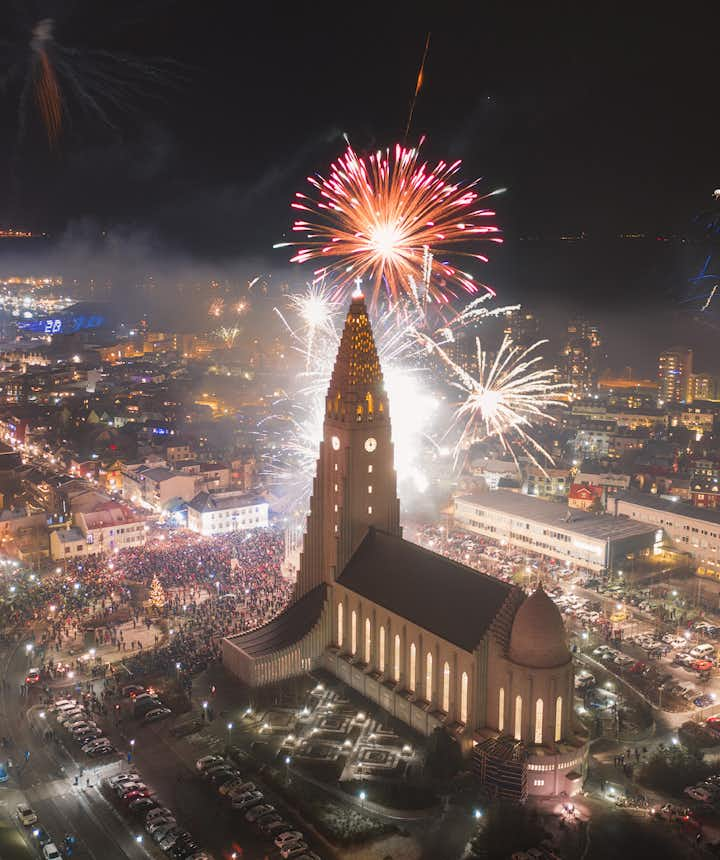
Tourist Information Centers in Reykjavik

What to Expect at Reykjavik Tourist Information Centers
- Reykjavik Tourist Information Centers
Reykjavik Tourist Information
- What's On
Maximize Your Vacation Time and Book Online Instead
- Reykjavik’s Top Tourist Information Centers | In Conclusion
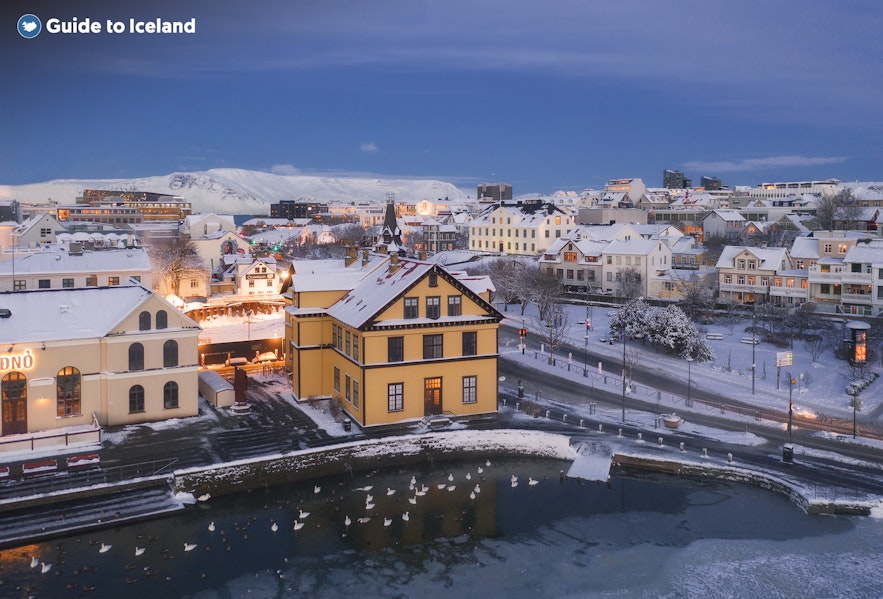
Don’t miss your chance to learn about all that Iceland offers by visiting a tourist information center in the country’s capital, Reykjavik . Reykjavik tourist information centers are excellent places to connect with local experts and learn about the best places to visit.
Whether you’re planning your very first trip or are a seasoned visitor to Iceland, every Reykjavik traveler should know where to go when they need help planning and booking adventures in Iceland.
Iceland is, without a doubt, a wonderful place to visit. It’s full of untamed nature, breathtaking scenery, and vibrant culture and history. Even though it's only about 39,682 square miles (102,775 square kilometers) in size, there is so much to see and do that all travelers will want some help navigating it.
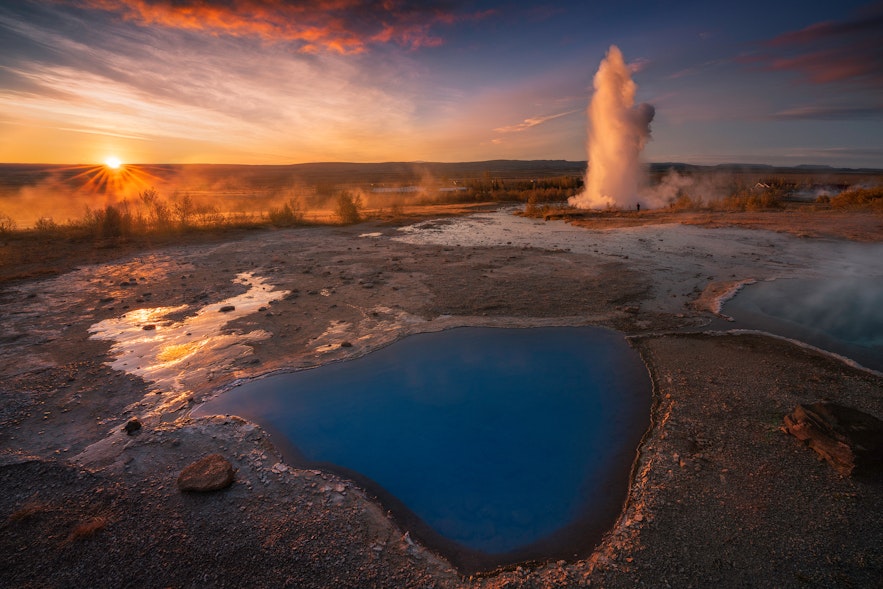
Yet, with so many different attractions, it can be difficult for anyone to choose where to begin. Additionally, first-time visitors to the country may find it incredibly overwhelming to plan a great trip to Iceland by themselves.
Luckily, several tourist information centers in Reykjavik share their expert knowledge and services to ensure you have an unforgettable vacation. Locals who know the land inside and out staff each of these centers to provide guests with the most accurate and helpful information possible.
This article shares top tips about Reykjavik’s tourist information centers and what you can expect to find at them.
Top City Breaks
4-day reykjavik city break with optional activities, 10-day christmas & new years vacation package holiday in iceland, fun-filled 3-day northern lights winter stopover in reykjavik with the golden circle & blue lagoon.
Tourist information centers inform visitors about the incredible things to see and do during their visit. They’re the perfect place to plan all your adventures in Iceland.
The staff at Reykjavik tourist information centers will happily provide directions to famous or popular landmarks. They can share recommendations for museums and the top Reykjavik restaurants and offer insider advice about the city’s best bars and nightclubs .
In addition, visitors can book full-day or multi-day excursions, arrange rental cars from Reykjavik , or even purchase Reykjavik city cards for discounts or free entry to select museums, galleries, and pools in Reykjavik.
These centers can recommend different activities depending on what you want to do or see. From an unmissable six-hour snorkeling tour in the Silfra fissure to a stunning four-hour glacier hiking tour , the only tricky part will be deciding what to do first!
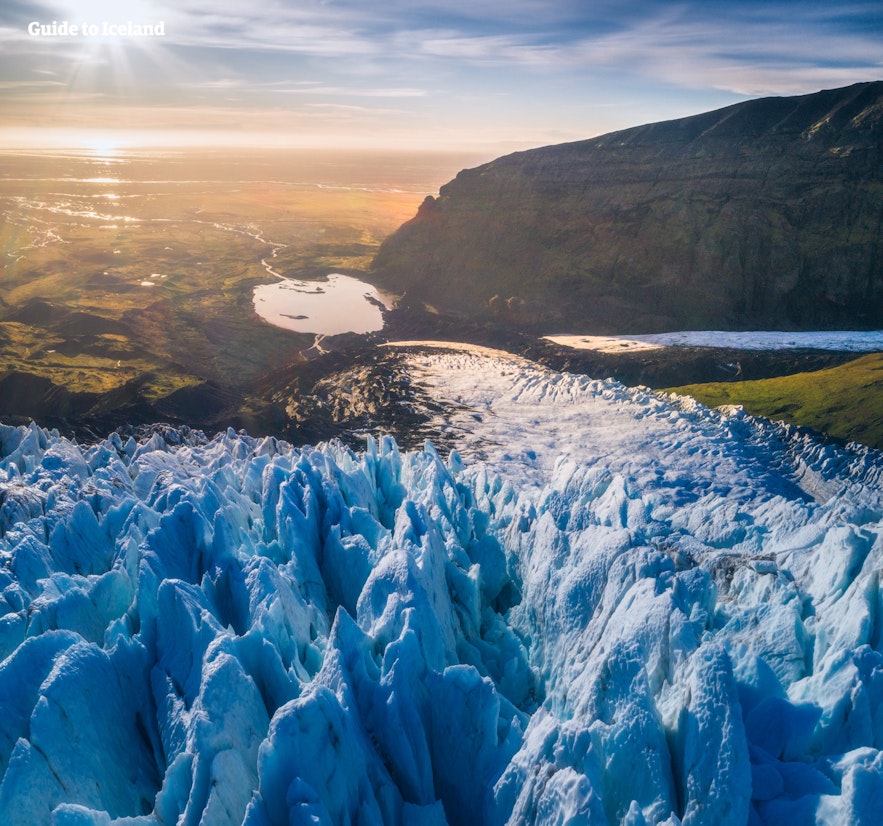
At visitor information centers, you can learn about the country’s most famous attractions. Discover Iceland’s much-loved driving routes, the Golden Circle and the Ring Road .
The former includes three awe-inspiring attractions you can visit in a single day, and the latter offers the perfect multi-day excursion around the whole country.
Once you decide the routes you have time for and areas you most want to see, tourist information centers can recommend the perfect Golden Circle tours and Ring Road adventures . Whether you choose a guided option or one of the many self-drive tours available, you’ll walk away ready for an excellent vacation.
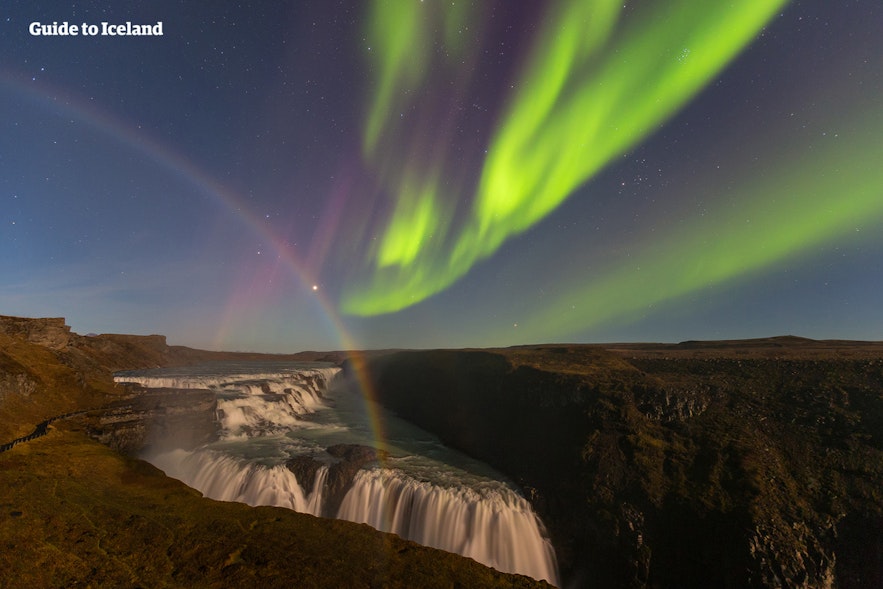
Reykjavik Tourist Information Centers
When traveling to unfamiliar places, knowing where to go is essential when you need help or information. This article includes tourist information center addresses, plus notable attractions, hotels, and landmarks nearby.
A great stop on this list is Reykjavik Tourist Information, a tourist information center and a well-known travel agency. You’ll find them at Hverfisgata 105, 101 Reykjavik, Iceland, and they’re open from Monday to Friday.
Reykjavik Tourist Information was created in 2019 by entrepreneurs and tourism operators. Their mission is to provide visitors to Iceland with a genuine, thorough, and innovative experience so they can enjoy all that the land of ice and fire has to offer worry-free.
There are plenty of hotels available near the center. Such hotels include Fosshotel Baron , only 262 yards (240 meters) away, and Fosshotel Reykjavik , also a short walk from the information center.
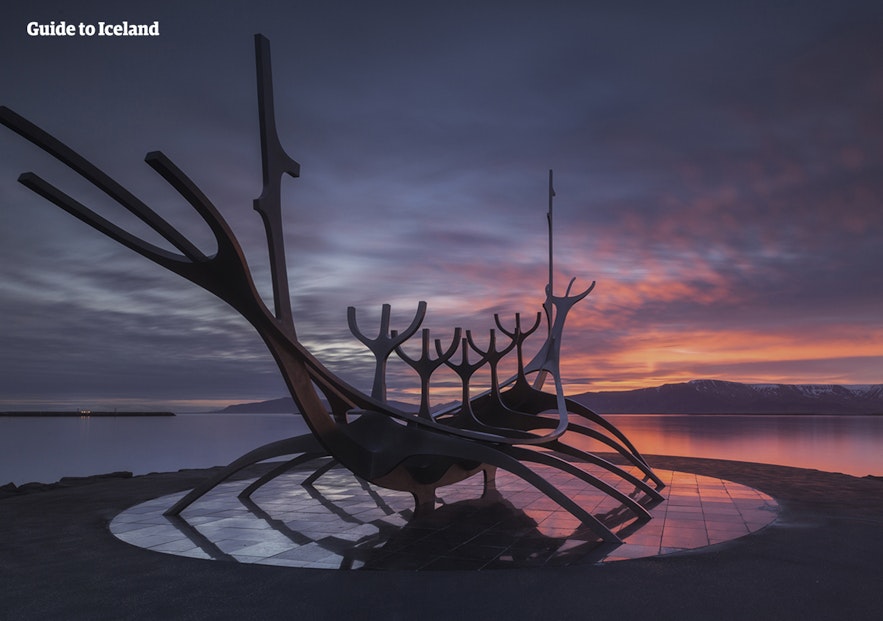
Reykjavik Tourist Information is about 1.3 miles (2.1 kilometers) from the incredible Perlan museum . Perlan offers a unique museum experience dome-shaped building. Several exhibits allow visitors to explore and learn more about Iceland's vibrant culture, history, and nature.
When at Perlan, you must book admission to the Wonders of Iceland exhibit . The Wonders of Iceland is a one-of-a-kind encounter that allows visitors to immerse themselves in beautiful Icelandic nature. Here you can witness the internal magnificence of a glacier while experiencing its subzero temperatures.
Top Day Tours in Iceland
Best ice cave tour in vatnajokull glacier starting from jokulsarlon glacier lagoon, inside the volcano thrihnukagigur tour with transfer from reykjavik, small group tour of snaefellsnes national park with transfer from reykjavik.
What's On is a much-loved Reykjavik tourist information center. They have two conveniently located centers in downtown Reykjavik. You’ll find both What’s On offices along the mile-long stretch of the Laugavegur shopping street, ideally positioned near many Reykjavik restaurants and bars.
What's On started as a monthly magazine publication. It has been ongoing for the last 30 years, making it one of the oldest tourist magazines in Iceland.
Their main office is at Laugavegur 5, while their second office is at Laugavegur 54. Both What's On tourist information centers are open Monday to Sunday.
What's On's main office is near many excellent hotels, such as the Exeter hotel , which is only 765 yards (700 meters) away. Their second office is close to Alda hotel , only 120 yards (110 meters) from the tourist information center.

The second What’s On office is close to the breathtaking Hallgrimskirkja church . With its tower reaching a whopping 245 feet (74.5 meters) high, it's the tallest church in Iceland and the tallest building in Reykjavik. Visitors can pay to ascend to the church's observation tower and overlook the entire city.
What's On provides visitors with valuable information on events happening in Reykjavik, such as exciting music acts and even thrilling roller derby events.
Top Culture Tours
Small-group 6-day adventure exploration tour around iceland's ring road from reykjavik, exciting 6-day guided adventure around iceland via ring road from reykjavik.
In addition to Reykjavik’s main tourist information centers, most hotels offer 24-hour tour desks with professional, knowledgeable staff. Hotel tour desks provide their guests with various services, so they never need to go too far from the comfort of their hotel for information or help.
For example, hotels can book tours in Iceland, such as northern lights tours from Reykjavik or adventure tours from snorkeling to snowmobiling, ice caving, and more. Furthermore, they can book Reykjavik tours if you want to stay in the capital city.
If you want to purchase tickets to the various museums, galleries, or activities available throughout the city, your hotel's tour desk may even be able to sell you tickets.
For your convenience, here are a few hotels with tour desks and a brief overview.
Fosshotel Baron
The Fosshotel Baron is a 3-star hotel offering its guests a unique and affordable experience. With 120 historically themed rooms to reflect the hotel's historical significance. The hotel's roots date back to 1898 when they constructed the first concrete building in Reykjavik, where part of the hotel still exists.
The Fosshotel Baron is smoke-free, with free Wi-Fi available throughout the property. They have a dedicated tour desk to help you plan your perfect day trip or multi-day excursion.
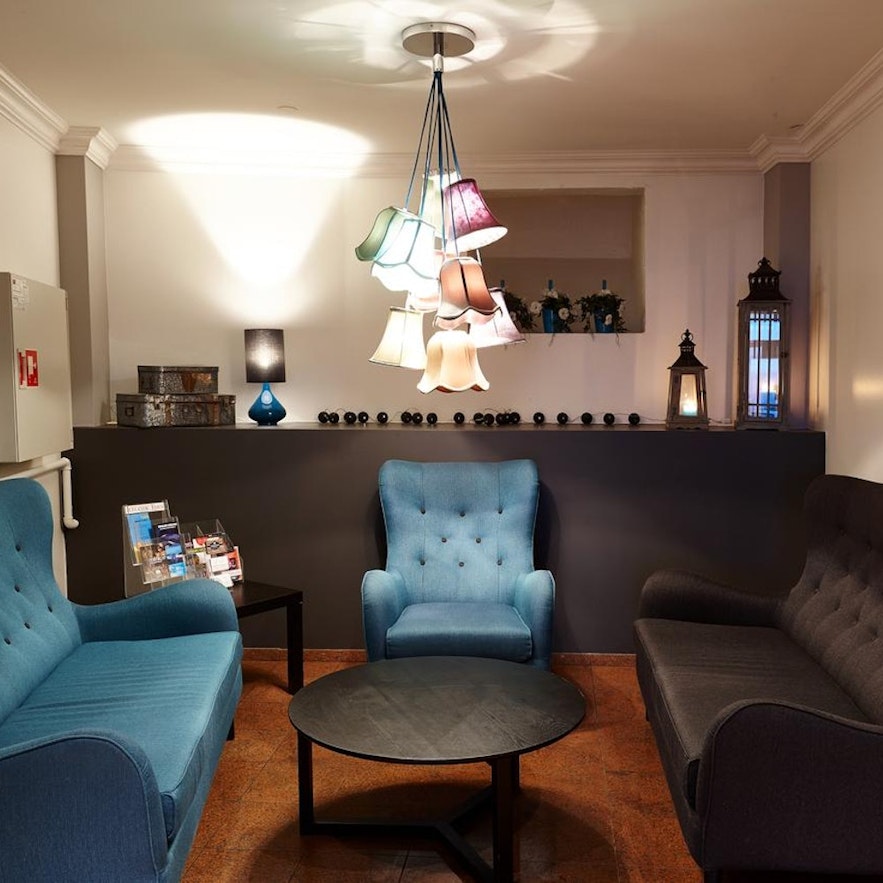
Exeter Hotel
The Exeter Hotel is a 4-star hotel full of industrial-chic elegance. What was once a storage building now encompasses 106 guest rooms, each in a contemporary style. The Exeter Hotel offers a fully equipped gym and sauna perfect for working out and relaxing afterward.
In addition to such amenities, the Exeter Hotel provides complimentary breakfast and free Wi-Fi throughout the property. Staff members at the 24-hour front desk will happily assist you with tour bookings and general information.
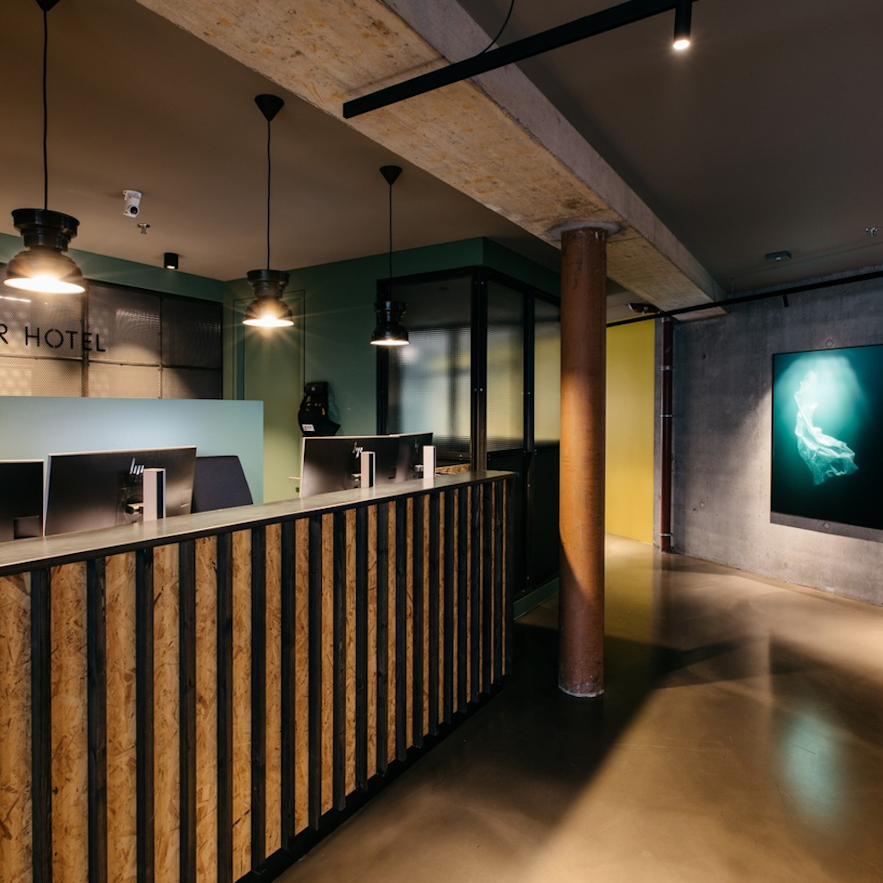
Hotel Reykjavik Saga
The Hotel Reykjavik Saga is a modern four-star spa hotel with friendly staff who can help you book activities and excursions. They offer 130 stunning boutique-style rooms of various sizes.
The hotel is smoke-free, with free Wi-Fi available throughout the property. It has excellent amenities, including a fitness center, restaurant, and bar.
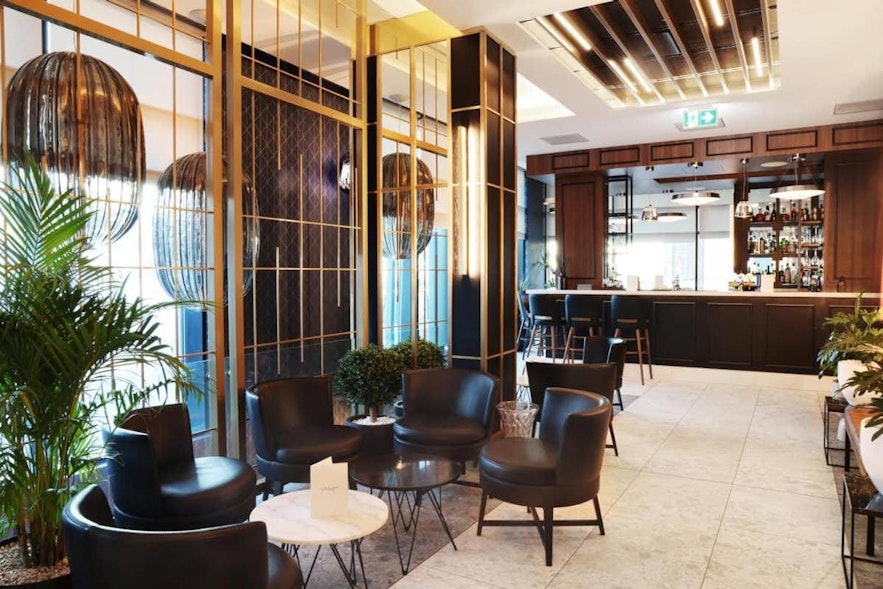
In addition to the many excellent tourist information centers throughout Reykjavik, Guide to Iceland offers unbeatable information and booking options for your upcoming vacation.
Guide to Iceland is an online tourist information center offering everything you need to ensure your visit to Iceland goes off without a hitch. By booking online, you can spend more time enjoying unforgettable experiences.
You can learn about the nature and culture of Iceland through our well-researched articles or find personal recommendations for places to visit from experienced travel bloggers. Visitors can even get directions to attractions and sites throughout the many regions of Iceland.
Then when you're ready to plan your visit, you can book tours and rent cars through Guide to Iceland.
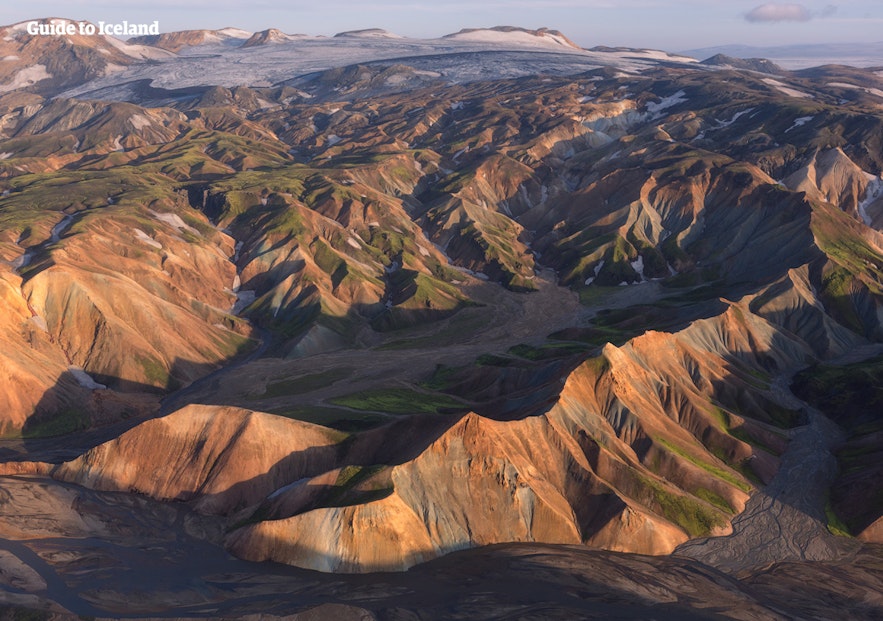
Reykjavik’s Top Tourist Information Centers | In Conclusion
Now you know more about several Reykjavik locations where you can get help planning and booking tours or getting tickets to nearby attractions. With countless museums, galleries, shops, restaurants, cafes, bars, and geothermal pools, you will never be bored when visiting Reykjavik.
Take comfort in knowing that no matter where you end up staying during your visit to Reykjavik, there are plenty of helpful tourist information centers near you. Each center has friendly and knowledgeable Icelanders to assist you and make your stay enjoyable.
Are you ready to plan your vacation to Iceland? Start by checking out our top itinerary ideas , whether you’re after a seven-day budget-friendly option or the ultimate winter itinerary .
Top Winter Tours & Packages in Iceland
3-day northern lights tour of iceland’s golden circle & south coast with ice caving & glacier hiking, 8-day guided northern lights winter tour of the complete ring road of iceland, scenic 4-day northern lights tour of vatnajokull ice cave, jokulsarlon & the south coast, popular articles.
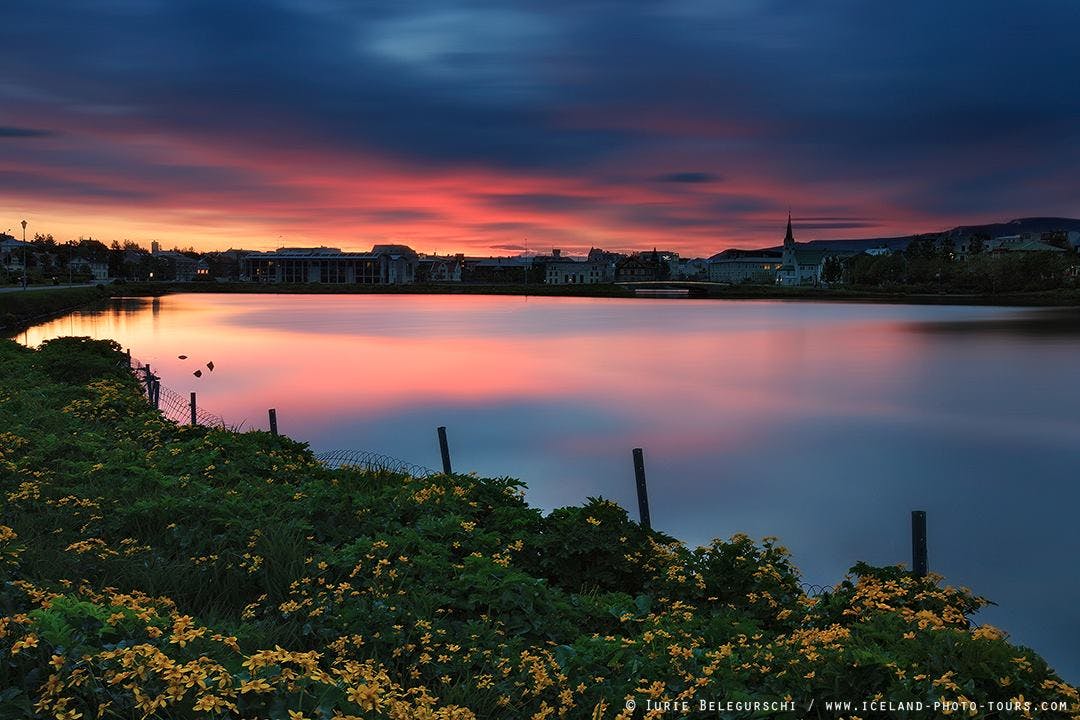
Guide to Iceland | The Story of the Leading Travel Agency of Iceland
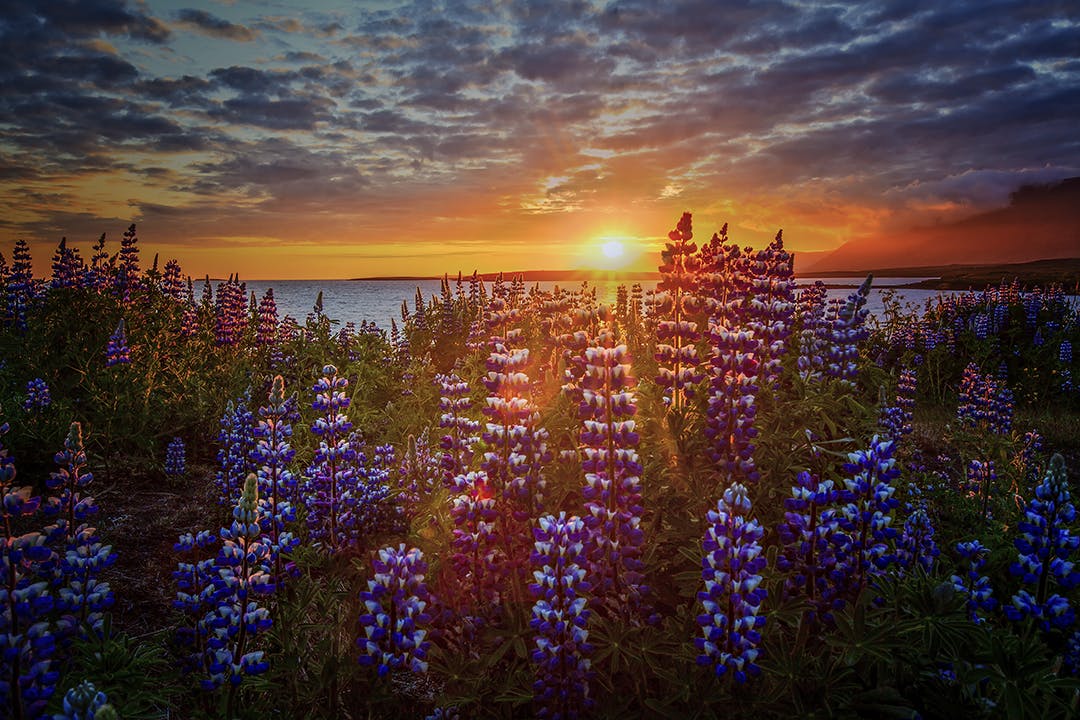
The Complete Guide to the Midnight Sun in Iceland
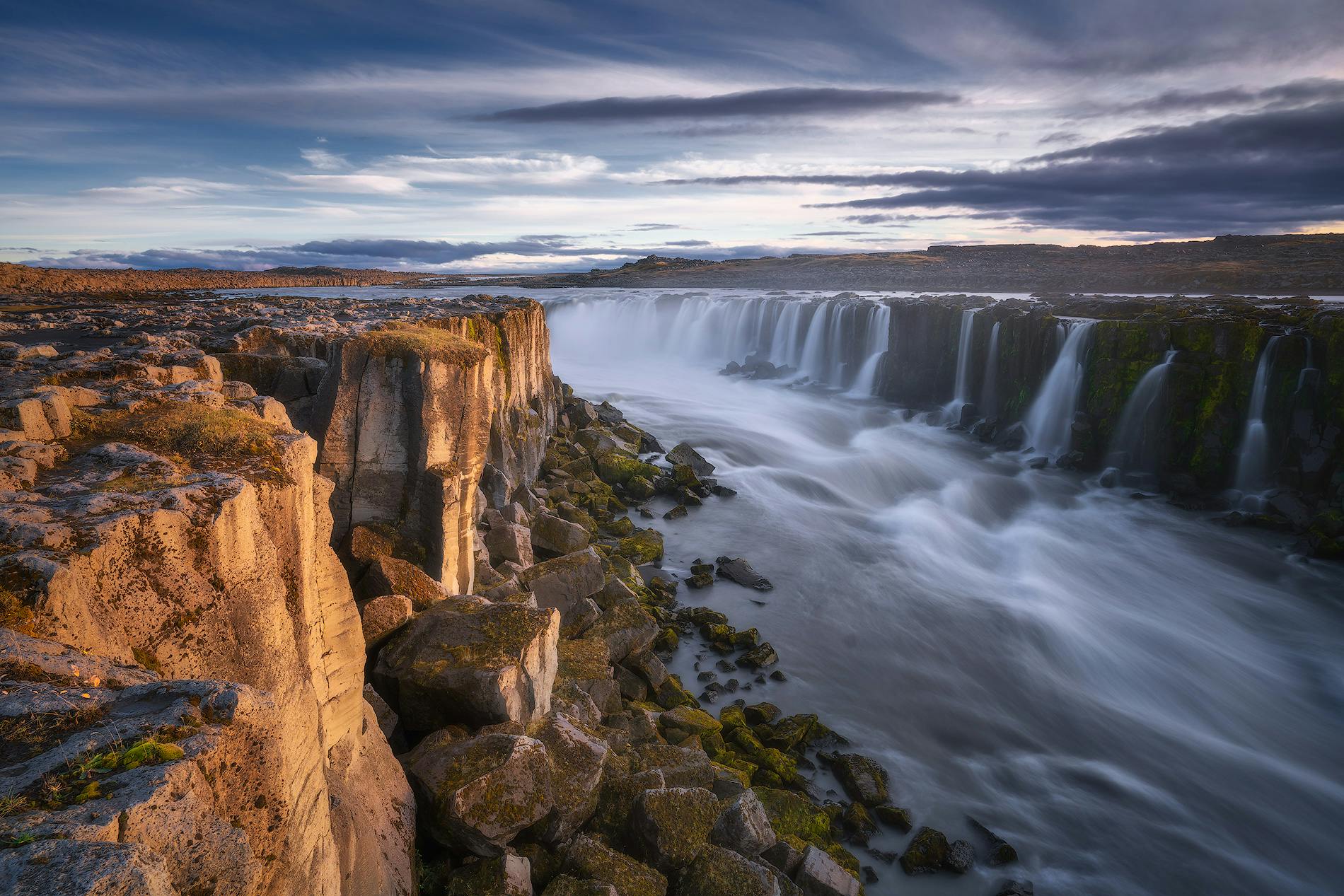
Top 20 Most Beautiful Waterfalls in Iceland
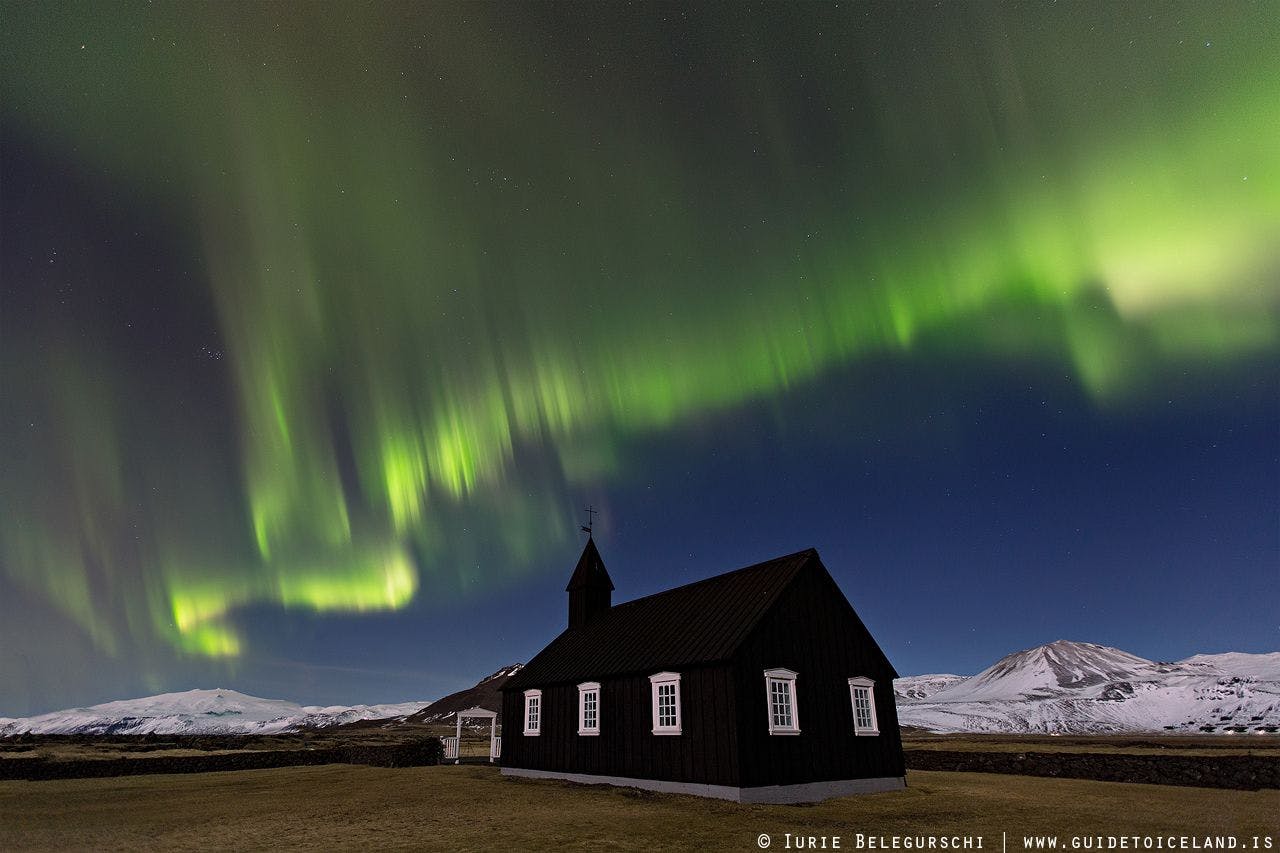
22 Photos of the Aurora in Iceland
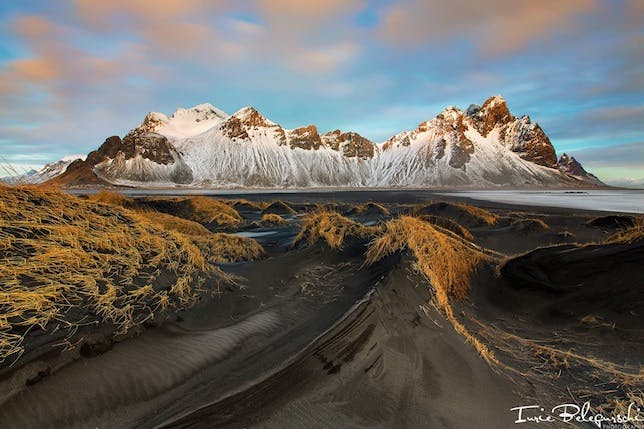
Mountains in Iceland
Other interesting articles.
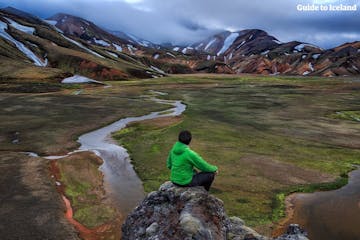
The 7 Best Spots for Peace, Quiet & Silence in Iceland
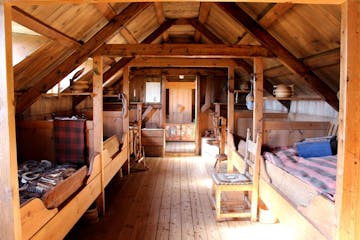
The Best Museums in Iceland
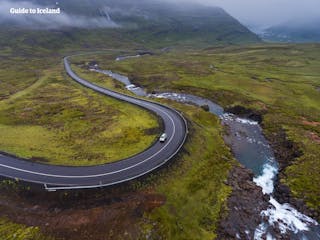
Driving in Iceland in July: All You Need to Know

Download Iceland’s biggest travel marketplace to your phone to manage your entire trip in one place
Scan this QR code with your phone camera and press the link that appears to add Iceland’s biggest travel marketplace into your pocket. Enter your phone number or email address to receive an SMS or email with the download link.
Top things to do in Iceland
Book your complete trip with the best companies only
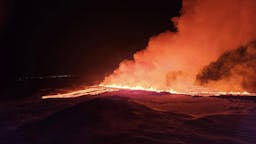
Visit a Live Volcano
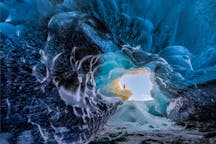
Explore an Ice Cave
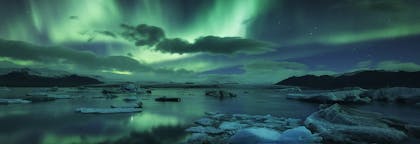
Find the Northern Lights
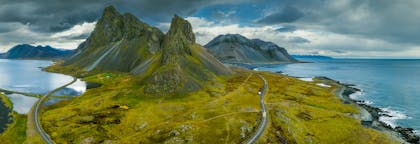
Go on a Road Trip
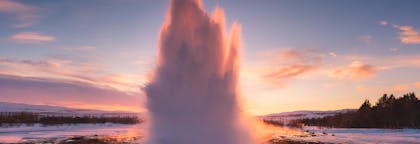
Do the Golden Circle
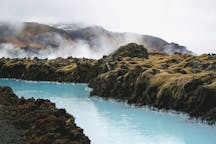
Visit the Blue Lagoon
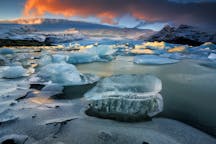
See the Glacier Lagoon
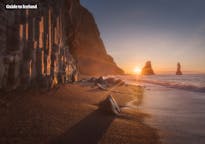
South Coast Tours

IMAGES
VIDEO
COMMENTS
Find out everything you need to know about Iceland, from regions and activities to weather and safety. Explore articles, videos, and tips to plan your trip and take the Icelandic pledge.
Discover the best attractions and activities in Iceland, from natural wonders to cultural experiences. Learn about Reykjavik, the Golden Circle, the South Coast, the Ring Road, the Blue Lagoon, the Snaefellsnes peninsula, the Westfjords, and more.
Learn about Iceland's volcanic eruptions, safety rules, hot spring etiquette, driving conditions and more before you plan your trip. This guide covers the essentials for first-time visitors to this stunning country.
Discover the best time, places and attractions to visit in Iceland, a breathtaking northern destination with endless talents. Find expert tips, articles and travel tools to plan your trip with Lonely Planet.
Discover the natural and cultural wonders of Iceland, a year round destination for outdoor enthusiasts and travelers. Find information on accommodation, dining, recreation, tourist routes, transport and regions.
Find useful information and book travel services for your trip to Iceland with Guide to Iceland, the largest website about Iceland. Explore top attractions, itineraries, tours, and more.
Download Iceland's biggest travel marketplace to your phone to manage your entire trip in one place. Your complete travel guide to Iceland. Find tips, book trips, affordable holidays or a self drive tour. Rent a car and find accommodation. Contact people, see pictures,
One idea is the Arctic Henge in Raufarhöfn, which was designed as a giant sundial to capture the midnight sun in perfectly aligned gateways. 7. Hike or bike through stunning natural wonders. After the snow melts and the mud dries in summer, Iceland reveals its incredible hiking routes past stunning natural sites.
Iceland (Icelandic: Ísland) is a stunningly beautiful place if you enjoy strange and desolate landscapes interspersed with glaciers, volcanoes, rivers and waterfalls.It is a place for hiking, ice climbing, kayaking in glacial waters, and relaxing in geothermal hot springs, and there are many tours available for those looking for a less strenuous vacation.
Introducing Iceland is a guide written by travellers for travellers, and contains personalized advice to help you make the most of your trip to the country. This guide will help you discover the main tourist attractions, what the typical dishes are, the best areas to stay, and our Top 10 recommendations.
Litli-Hrútur Volcano. Sner/Getty Images. Hiking a volcano is one of the most thrilling adventures you can embark on in Iceland, and Litli-Hrutur is the newest eruption. This particular hike is no ...
Festivals in Iceland; Useful Travel Info; Icelandic folk tales and legends; Culture. Information about Culture. Origin of Icelanders; Vikings and the Discovery of America; Art in Iceland ... Your Guide to Reykjavik & Iceland Find places, shops, restaurants and things to do. Practical. Discount Coupons. List of Happy Hours. Browse our book 2025 ...
Find out everything you need to know about Iceland's nature, culture, and attractions. Book tours, activities, and travel services with the largest selection and best price guarantee.
Travel agency. Information for applicants; Annual reassessment of package travel security for travel agencies ; Security amounts - increased securities; ... Find all the latest data from Tourism in Iceland right here, in the Tourism Dashboard. SEE MORE. The Tourist Site Protection Fund.
Discover the best destinations in Iceland, from the Golden Circle to the Eastfjords, with tips on when to go and what to do. Whether you're looking for nature, culture, adventure or relaxation, this guide has something for you.
Discover the best places to visit in Iceland, from Reykjavik to the Blue Lagoon, Gullfoss Waterfall, and whale watching. Learn about the country's geology, culture, and history with tips on tours, activities, and resorts.
Official travel websites. Visit Iceland Visit South Iceland Visit East Iceland Visit North Iceland Visit Westfjords Visit West Iceland Visit Reykjanes. Welcome to Reykjavík! - a city to recharge, restore and refuel. It's a city surrounded by incredible nature - but at the same time, a city full of life, beaming with creativity.
Iceland is one of the most sparsely populated countries in the world, with a population count just under 380,000. Almost two-thirds of the inhabitants live in the capital area in the southwest, and the rest of the population is spread around the long coastline, mostly in fishing villages and farmland regions. Geology.
5 Day Iceland Travel Itinerary: Day 1: The Golden Circle Tour. The Golden Circle tour is Iceland's most popular day trip. This is generally a full day tour which departs from Reykjavik around 8am and returns at 5pm. If your flight is arriving a bit later you can opt for an afternoon tour around the Golden Circle.
Regions of Iceland. Iceland is typically divided into 7 different geographical regions. Each region differs slightly in respect to culture and landscapes, but are uniquely Icelandic. Find your favorite part of Iceland. Find out all about it.
December 24, 2018. TusoDikens. icetourist.is is definitely the best travel guide to Iceland. By air AIR ICELAND operates regular scheduled flights from Reykjavík to major domestic airports in all parts of the country. Furthermore, in co-operation with several bus companies, Air Iceland can offer an air/bus connection to over 40 towns all over ...
See all tours. 12. Go On a Whale Watching Tour. Whale watching is one of the best things to do in Iceland. Over twenty species of whales, dolphins, and porpoises call the Icelandic coastal waters home, ranging from the small harbor porpoises to the earth's largest animals, blue whales.
Reykjavik, Iceland — One U.S. tourist was killed and another seriously injured when part of an ice cave collapsed in southeast Iceland as their tour group visited the area, police said Monday. A ...
Consider scheduling 1-2 days in Iceland after your Greenland visit, before you return to Europe or North America. That buffer can help eliminate the stress of missing your onward flight connections if your departure from Greenland is delayed. ... Discover more Greenland travel advice and helpful information below: Aircraft and airports ...
An American tourist was visiting an ice cave in one of Europe's largest national parks last month when a frozen arch collapsed, killing him and injuring his girlfriend. ... places like Iceland ...
A great stop on this list is Reykjavik Tourist Information, a tourist information center and a well-known travel agency. You'll find them at Hverfisgata 105, 101 Reykjavik, Iceland, and they're open from Monday to Friday. Reykjavik Tourist Information was created in 2019 by entrepreneurs and tourism operators.